If you’re looking for information on the types of trees, you’ve come to the right place. Here you’ll find a comprehensive guide to tree types, including information on their names, characteristics, and growing habits. You’ll also learn more about their common types, such as deciduous and evergreen trees.
What is a Tree?

Trees are one of the most abundant plants in the world. They also have some of the longest lifespans of any organism. They are capable of sending chemical, electrical, and hormonal signals to enhance growth and survival.
Although they may seem simplistic, tree growth is actually not that simple. It involves many factors including water, sunlight, and air. Each of these factors is responsible for the formation of a unique canopy for each species.
The trunk is the most prominent visual feature of a tree. It contains multiple layers of cells. Each cell is involved in various metabolic functions, including oxygen absorption and carbohydrate synthesis.
The trunk is also waterproof and a source of moisture. As the tree grows, its bark stretches and cracks. This allows the tree to protect itself from the elements.
During primary growth, the branching system produces new leaves. Secondary growth occurs when branches grow thicker. The phloem is the layer below the bark that transports sugary sap to all parts of the tree. The innermost layers of xylem are located right in the center of the tree.
Facts About Trees
Trees are one of nature’s most amazing creatures. They provide shelter for wildlife, filter rainwater and improve water quality. They also help slow the rate of erosion.
A tree can live for thousands of years. They can send airborne chemical signals to warn of danger. They can store carbon dioxide, and release oxygen into the air to replace it. They can also produce a stunning burst of color in fall.
There are more than 60,000 species of trees in the world. The UK has more than thirty species, including silver birch, oak and willow. They are the tallest living things on earth. They are also one of the longest living.
The oldest known tree is the bristlecone pine, called Methuselah, which is 4,852 years old. In the wild, these trees can live for up to 5,000 years.
Trees have a symbiotic relationship with soil fungi, which help them absorb nutrients and water. They also communicate with other trees by releasing airborne chemical signals. They can warn predators of an approaching threat and attract caterpillar-eating birds.
Different Types of Trees
There are thousands of different types of trees in the world. They are a very important group of plants that are used for a variety of purposes. They are also important in terms of erosion control and soil stabilization. They also contribute to the generation of oxygen and the absorption of carbon dioxide. They have specific needs for moisture, light and soil, so they can be grown in a wide range of environments.
The majority of tree species are evergreen. That means that they don’t lose leaves during cold winters. However, there are some exceptions. There are also some conifers that are deciduous.
These are woody plants that have single, self-supporting trunks. They can grow tall and have a lot of branches. A mature tree can absorb 48 pounds of carbon dioxide a year. It also helps keep the air clean.
Almost all conifers are evergreen. They also have hard flat leaves. These can be compound, with several leaflets, or simple, with one blade leaf. There are also scales that grow on some conifers. These can be used to help identify a tree.
Deciduous Tree Types
There are several deciduous tree types that you can plant in your garden to add color. You will need to find out what each one is and how to tell them apart. You can also look for their uses. Some trees are used for food, while others are used for fuel. There are several that are also used for interior decoration.
There are several types of oak that are common in North America. The wood of these trees is very strong and is used for a variety of different things. Some of the most popular uses include furniture, construction, and even fuel.
Another tree you may have heard of is the black ash tree. This tree is a deciduous variety that grows best in cool weather. The bark of this tree is dark gray, while the leaf is pinnately compound. The fruit of this tree is a winged pod.
The American hornbeam is a small deciduous tree that is found in the eastern part of the United States. It is also a very fast growing tree. It has wood that is extremely durable and is used for many different kinds of tool handles.
Evergreen Tree Types
Evergreen trees come in a wide variety of shapes, sizes, and colors. Many are used for ornamental purposes, while others provide shade and windbreaks. These woods also provide useful building materials.
There are four basic categories of evergreens. Each category has its own characteristics, including the way they grow.
Conifers are one of the most common types of evergreens. Their needles remain green throughout the year, giving them a distinctive appearance. This makes them popular for landscaping and as screen plants.
They can be found in most regions of the world. They grow well in both dry and moist soils. They are easy to maintain, making them a practical addition to any landscape. They can also be useful as wildlife habitats.
They are also useful for creating a natural barrier between properties. They can also add color to your garden.
They are used extensively for privacy screens and hedges. Their soft and aromatic wood is also used as a natural bug repellent.
They have a very long lifespan. They can reach up to 50 feet tall. They are also a very prolific plant in northern Africa and the Middle East.
Types of Trees
There are many different types of trees in the world, so knowing more about the various kinds is an important skill. This guide explains the different varieties of trees and their functions. Getting to know the different tree types will help you keep your garden looking beautiful.
Trees are perennial plants that tend to live a long time. They have been revered in many cultures throughout the centuries. Their branches provide a source of shade and cooling in areas where it is needed. They also have been known to feed and shelter countless creatures.
A good way to distinguish between different species of trees is by the size and shape of the leaves. Some trees are large and wide, while others have small leaves and short stems. Usually, the bigger the tree, the better.
Another useful tip to determine the type of tree is by the location of its roots. Some trees are planted in wet areas, while others can grow well in dry uplands.
The term evergreen is frequently used to describe conifers. A conifer is a tree that has leaves year-round. Several examples of evergreen trees include eucalyptus, spruce, and fir. The most common evergreen trees are those that grow in tropical regions.
1. Acacia Tree
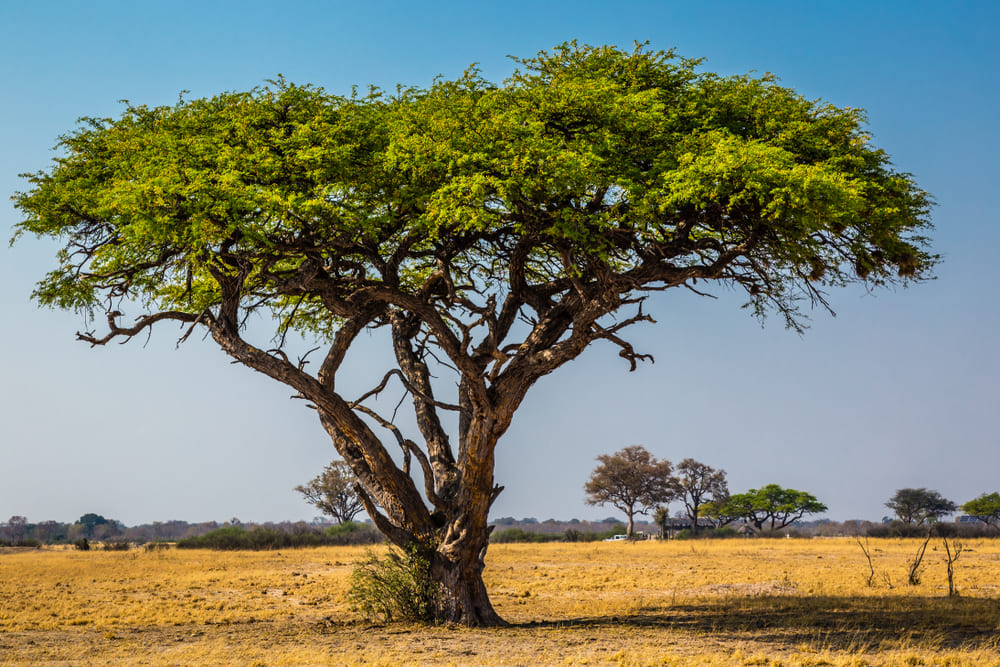
Acacias are an important part of the savanna ecology in Africa. They were first described by Carl Linnaeus, a Swedish botanist and physician. He observed that acacias formed dry, open forests with species of Eucalyptus.
They are also a source of gum arabic, a compound used in soft drinks and pharmaceuticals. Many acacias are cultivated for ornamental and commercial purposes.
They are hardy and drought-resistant. Their leaves are narrow, but they retain water well. Some of them grow fast. They can be deciduous or evergreen. They are commonly found in hot and dry climates. They are widely grown throughout the world.
Some acacias have thorns. These thorns are used as natural defense mechanisms. They protect the tree and are a necessary feature in desert areas.
The wood of an acacia is dense and durable. It is often used for furniture. In addition to making a great focal point, it is available in a variety of colors.
Many people believe that acacia trees provide health benefits. They are claimed to help prevent cancer, diabetes, and heart disease. They are also used as a medicinal plant.
2. Apple Tree
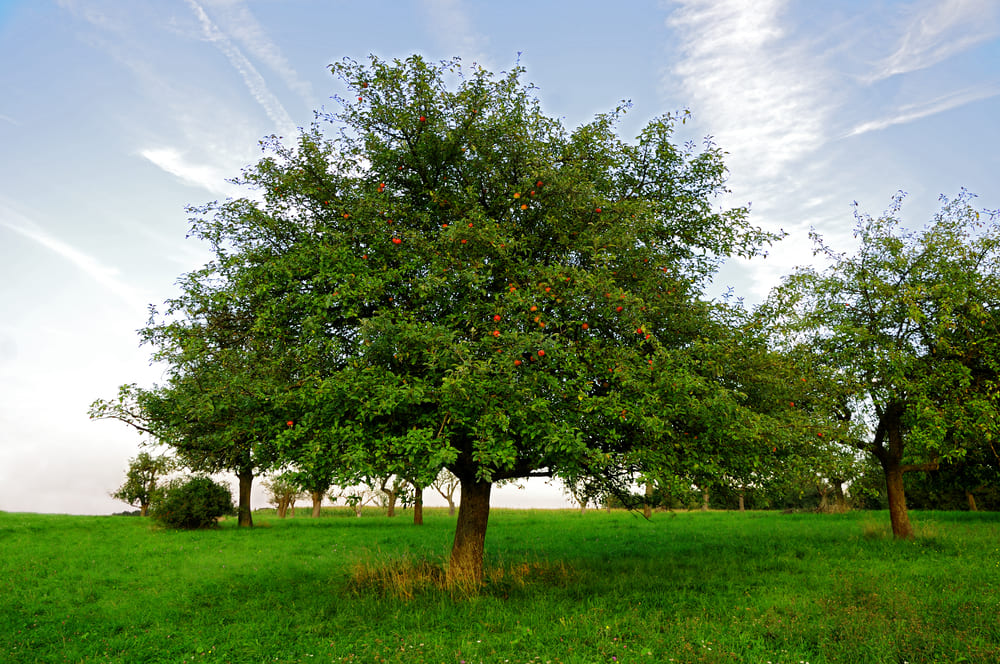
Apple trees are a popular landscaping tree. Whether you want to grow them in your home or commercial orchard, there are some facts and tips to help you identify your varieties.
One of the most important characteristics of an apple tree is the leaves. They are egg shaped, simple, and toothed at the edges. They range in length from about 1 1/2″ to 3 inches. The underside of the leaf is dull grayish green.
Another identifying characteristic is the blossoms. They typically have five petals. The blooms are pinkish white. They are generally early to mid-season bloomers. They are followed by fruit that appears in late summer or early fall.
Although an apple tree will bear fruit for several years, it may not have any fruit in its first year. The type of rootstock used will also have an impact on how many years the tree will produce fruit.
Choosing an apple tree depends on your location, landscape, and climate. Most apple types prefer a moderate climate with warm summers and mild winters. They do well in USDA Hardiness Zones 5 to 8. There are some that will fare well as far north as Alaska.
3. Pear Tree
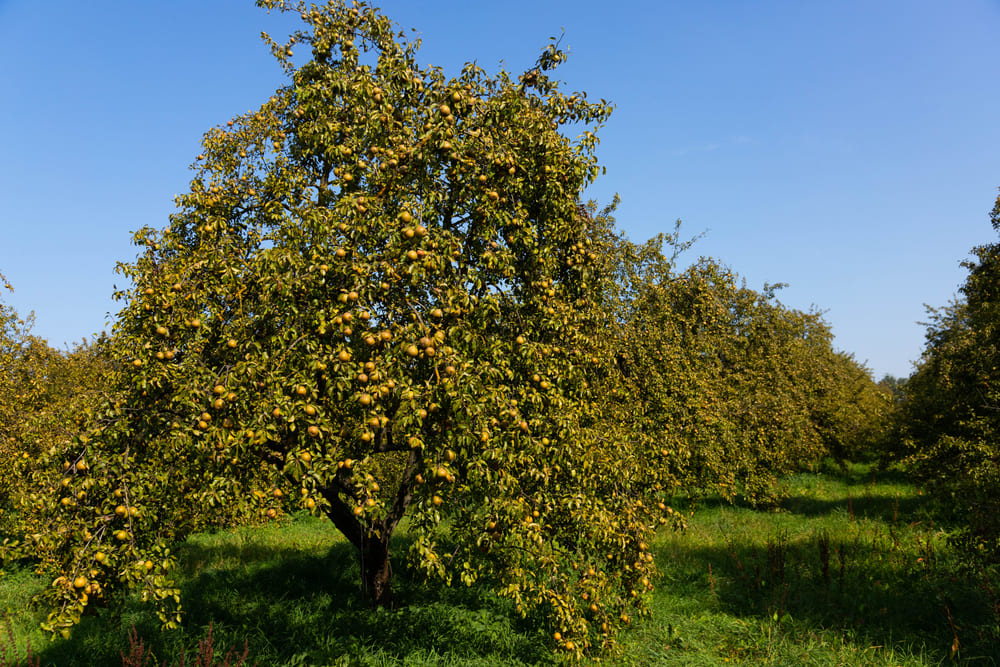
Pear trees come in a wide variety of shapes and sizes, and you need to make sure you pick the right one. There are many different varieties and you will want to choose a variety that will thrive in your area.
Pear trees can be grown as either an ornamental or fruit tree. Both produce small, colorful fruits that can be used as ornaments or as food. There are also some very delicious types of pears. The most common are Asian pears, which are popular for their sweet taste and caramel-like flavor.
Pears are generally considered an ornamental tree, but some varieties of pears are good for cooking. They can be eaten fresh or canned. If you don’t know what type of pear tree you want to plant, it may be helpful to research and learn about the different varieties.
There are several types of pears, including Asian pears, Bartlett pears, and Harrow Sweet Pears. The Asian pears are typically eaten raw, but they can be cooked if you desire.
Asian pears are known for their high water content and juicy, sweet fruit. They are not as hard as conventional pears and they can be easily eaten on the counter. You can find them in most growing areas.
4. Black Birch Tree
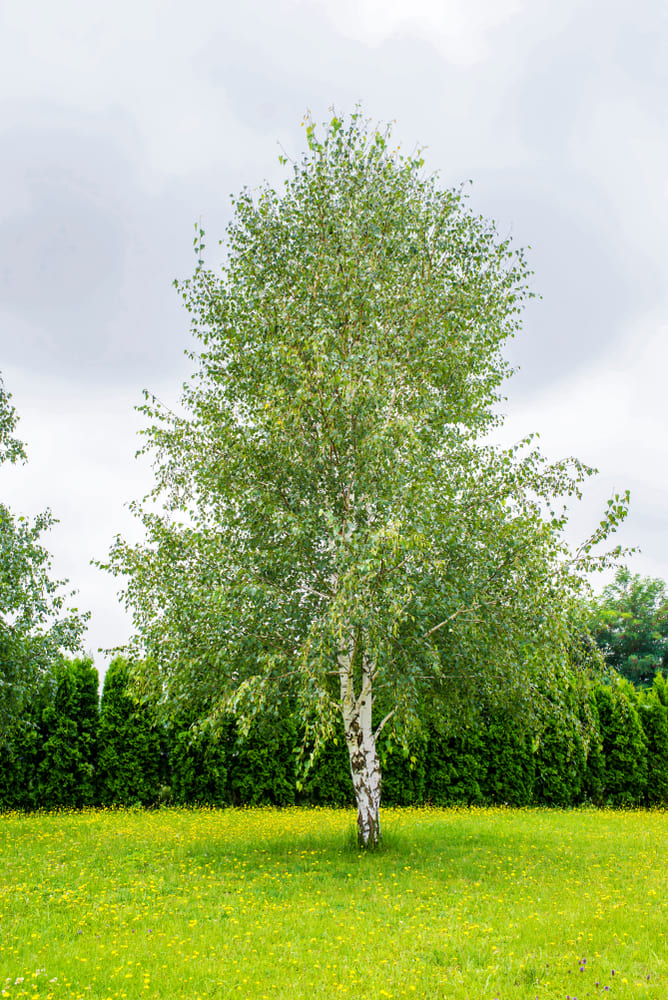
The Black Birch tree is a native tree that is found throughout the eastern United States. It is a very common garden tree. It is also a common building tree and it is often used to make furniture and veneer.
The Black Birch is a tall, slender tree. It is a member of the Betula genus. It is a monoecious tree, meaning that both male and female flowers appear on the same tree. The female flowers are small, yellow, and inconspicuous.
The leaves of the Black Birch are large and ovate. They are green in the spring and turn to golden-yellow in the fall. They are usually serrated.
The Black Birch is a good choice for smaller gardens. It is a light-growing tree that can reach up to 40 feet in height.
It is a great choice for low-lying wet areas. It is resistant to acidic soils. The wood is hard and attractive. It has a dark brown bark.
The Black Birch can be grown in a variety of soil conditions, but it is best in wetter climates. It is also fairly drought-resistant.
5. Ash Tree

The ash tree is a deciduous tree. It grows in a variety of habitats. It is found throughout the Northern Hemisphere. It has a large trunk. It can grow up to 30 feet tall. It is an important part of many landscapes.
It is part of the olive family, called Oleaceae. It has a range of 45 to 65 species of medium to large trees. It is widespread across Europe, Asia and North America.
The tree’s bark is smooth initially, but turns gray with diamond-shaped ridges as it ages. It is hard and pliable. It is used to make a variety of tools.
The leaves of the ash are usually oval. Each leaflet has a toothed margin and a sharp point. The leaflets are alternate, and sometimes they are stalked.
The fruit is a samara. The seeds are commonly known as keys in English. The ash tree is usually unisexual, but females may produce fruits containing a few seedlings.
The ash tree is frequently planted as a shade tree. It is also popular as a lawn tree. It is an excellent source of timber. It is valued for its beauty.
6. River Red Gum Tree
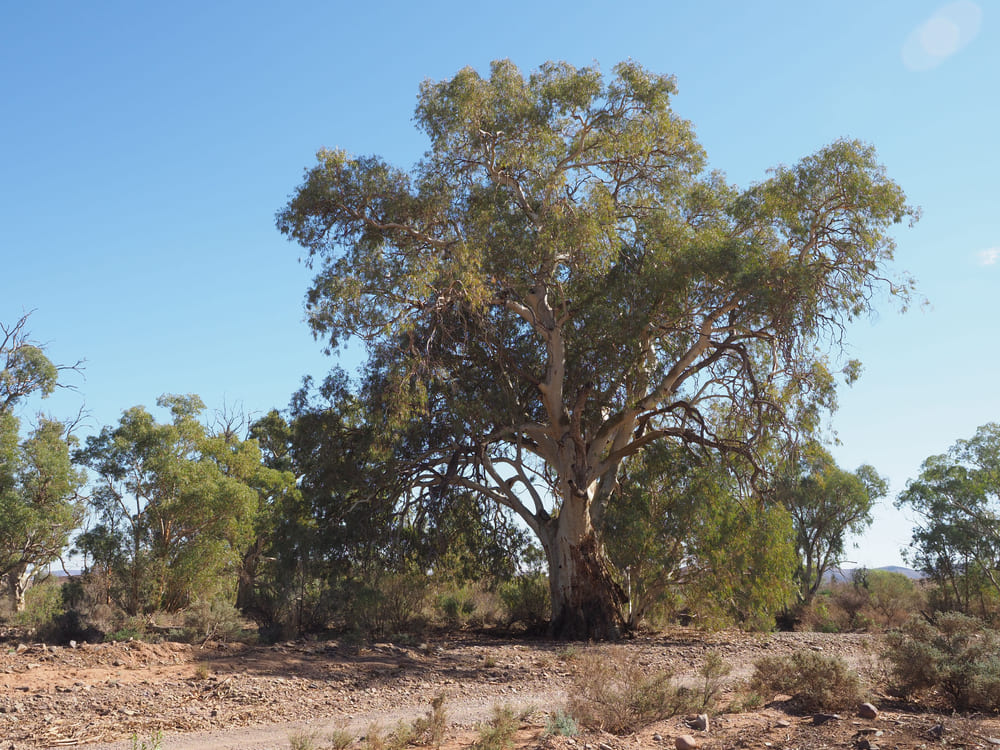
The River Red Gum is the most widely distributed eucalypt species in Australia. It is an opportunistic water user and can survive for long periods of drought and flood. It also forms a deep root system to extract water from clay soil.
The river red gum is also a major pollinator of subtropical fruit. It produces flowers that attract birds, insects and small mammals. The flowers then produce a wood capsule that opens up to release yellow cuboid seeds. These are eaten by animals.
These seeds are carried along the waterway where the mother tree grows. The fruits are 4-10 mm wide. During the flood season, the river red gum drops large numbers of seeds. The seeds are then dispersed by wind.
The river red gum has been subject to many government inquiries regarding conservation and use. In the past, it was often seen as a timber tree. However, it is now considered an ornamental tree.
The tree has been depicted in literature and art. Images include Hans Heysen, Henry Johnstone and Harold Cazneaux.
7. Peach Tree
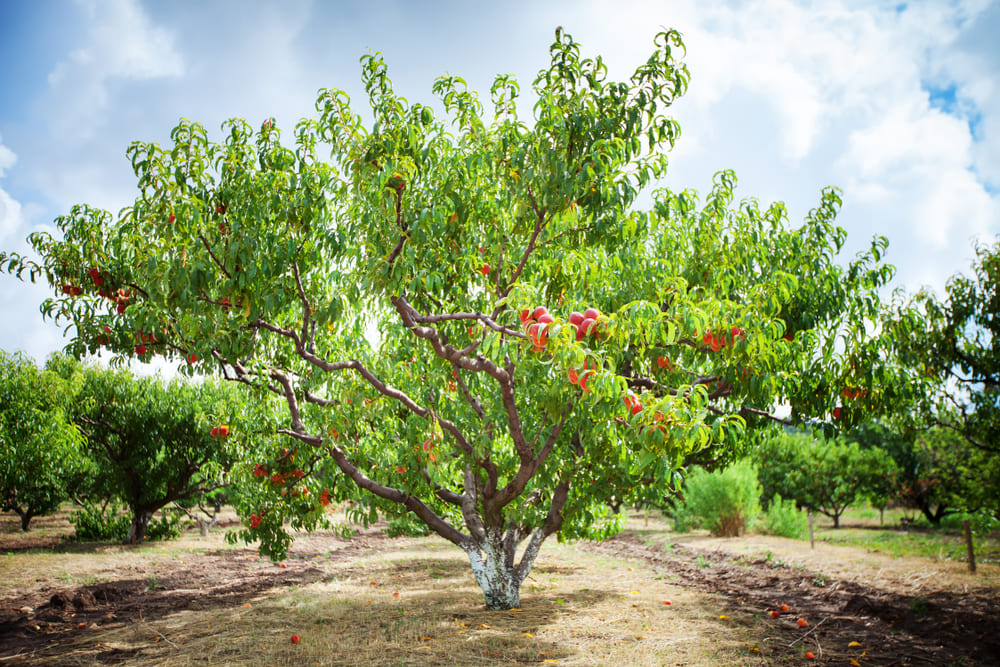
Peach trees produce a variety of juicy fruit, including the clingstone, freestone, and semi-freestone varieties. These trees can be planted in home gardens and provide a tasty treat.
When growing a peach tree, make sure it gets regular watering. This will help promote stronger root growth. In addition, keep the soil nutrient rich by adding fertilizer. The proper balance of nitrogen, phosphorus, and potassium will result in robust growth.
Peach trees are susceptible to brown rot and leaf curl disease. These diseases cause reddish spots to appear on the leaves. These spots will drop out leaving holes in the leaves. This disease can result in stunted growth and reduced yield.
To prevent these problems, you should plant your peach tree during the dormancy period. It also helps to provide a 3- to 6-inch berm around the tree’s root zone.
Once your peach tree is established, you should water it every 7 to 14 days. You can use a soaker hose or hand-watering. However, you should avoid sprinklers as these can damage the tree’s foliage.
8. Banyan Tree
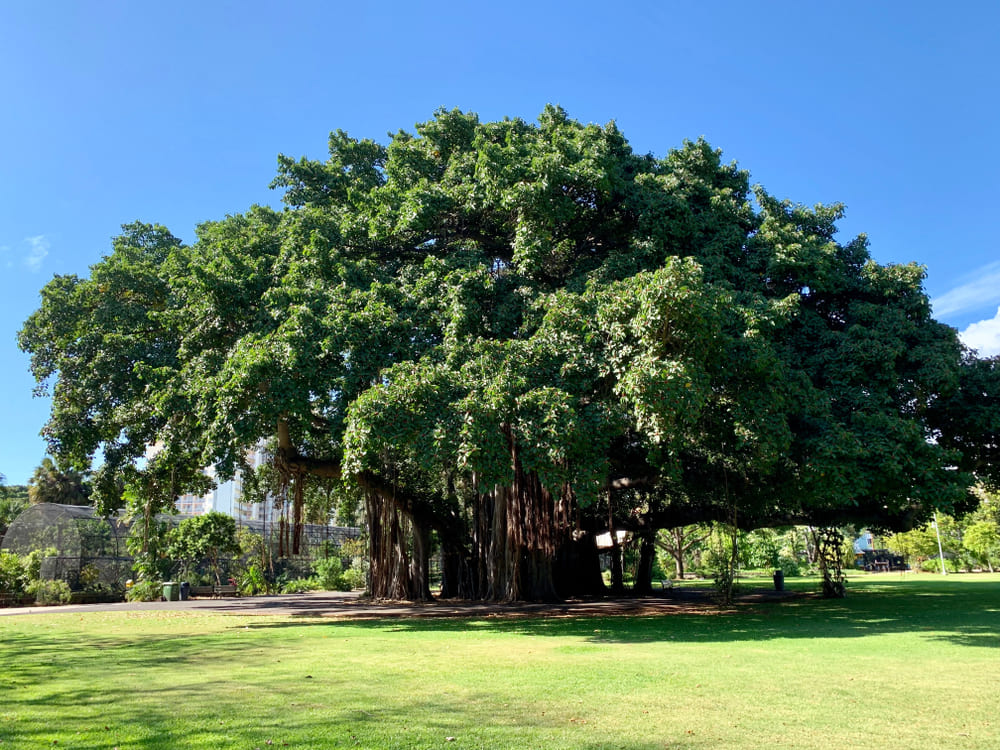
A banyan tree is a tree with a long history of being used as a shade tree in home landscaping. It is one of the most popular species for bonsai. The leaves of the tree are a deep green to olive and are leathery, large and thick.
There are three main types of banyan trees. The ficus citrifolia, the Florida strangler fig, and the shortleaf fig. Each has its own unique characteristics.
The ficus species can grow well in gardens, but they tend to be more associated with tropical forests. The Florida strangler fig is common in the southern United States, and the shortleaf fig can be found in central and south America. Its fruit is large, fleshy and has multiple ovaries.
Aside from being a shade tree, the banyan tree is also used for its wood products. Its trunk has a smooth grayish color and the petiole is quite short.
Several cultures have considered the banyan tree a spiritually auspicious plant. In Hinduism, the banyan is believed to be the place where Krishna rests. It is also considered to be the host for peaceful spirits. Its roots are said to be symbolic of the human struggle with the senses.
9. Common Fig Tree

Common fig tree is a popular plant in the Middle East and Mediterranean region. It is grown widely for its edible fruit. It grows well in a range of climates and soils, with a preference for light, well-drained soil, moderate salinity, and filtered shade.
The fig has been cultivated for thousands of years, and is still a highly prized food crop. There are a number of cultivars available, including the Brown Turkey, Kadota, and celeste. A few are particularly suited to cooler climates.
A hardy fig tree will produce plenty of medium-sized, edible figs. A mature fig can grow to be a large, dense shade tree. It can also be grown in a container. The fruit should be fully colored and soft to the touch. It is best to avoid picking the figs before they ripen. Its fruit is very sweet, but some varieties are vulnerable to hard freezes.
Common figs are a favorite of birds. Their small size and sweetness make them especially tempting. They are often used to fatten geese for foie gras. The fruit is also a popular food for squirrels.
10. Neem Tree

The neem tree is a fast-growing plant that has been widely used in India for over 4500 years. It is also a plant that has been recognized by the United Nations as a tree of the 21st century.
It is a member of the genus Melia, which contains many species that are closely related. The neem is an evergreen shrub or small tree that reaches heights of 15 to 30 meters.
It is often found in front yards of homes and colleges. It can also be propagated by seed. The seeds can be soaked in water before planting. They should be planted in a large container with a drainage hole. They should be fertilized with a balanced fertilizer. They will germinate in one to three weeks.
It grows well in arid or semi-arid climates. It can thrive in soil that is moderately acid. During extreme drought, it may lose some of its leaves.
The neem tree can be harvested from seed or propagated from cuttings. It will start bearing fruit after 3-5 years.
11. Aspen Tree

Aspens are one of the largest and most widely distributed trees in the world. Their leaves are a brilliant yellow. They are also considered a key part of the ecosystem. They provide habitat for many wildlife. They are found throughout the Intermountain West, from Mexico to the continental United States.
Aspen trees are commonly found in areas with cool, moist soils. They are dioecious, meaning they have male and female trees. Both types produce fruit. The fruit is green and consists of small berries.
Most Aspen trees are around 20 to 80 feet tall. They can live for up to 120 years. They are often planted in lawns. They are sold at nursery and garden centers as either a male or female tree.
The roots of aspens sprout green leaves. These leaves serve as an excellent habitat for insects. They also return nutrients to the soil. The bark of an Aspen can range in color from gray to almost white.
When an Aspen tree is damaged by a pest, it usually breaks down. The most common problem affecting ornamental aspens is iron chlorosis.
12. Mahogany Tree
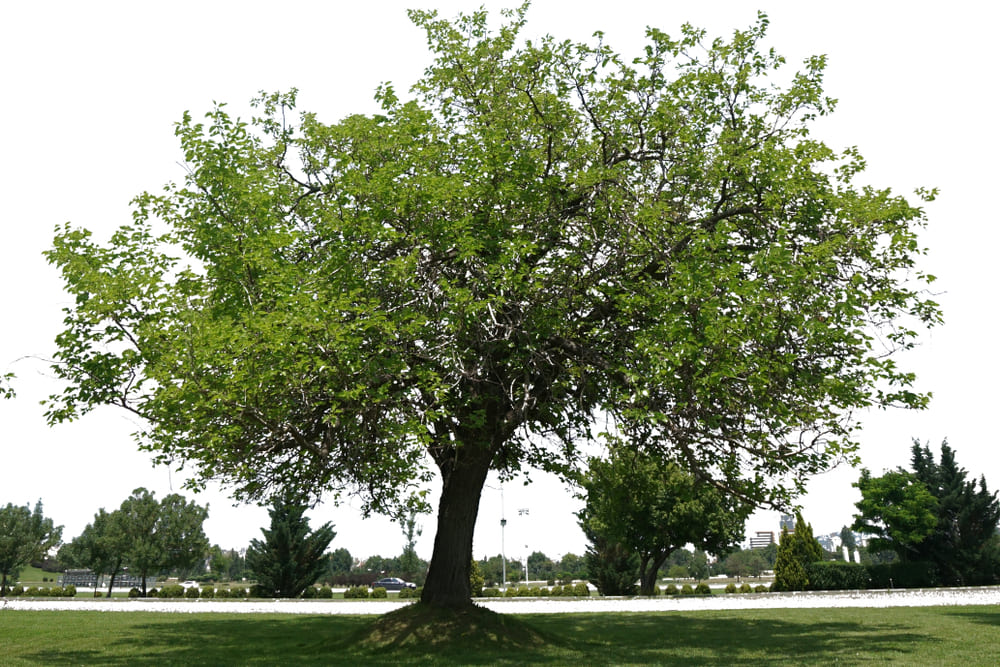
The mahogany tree is a native of South and Central America. It is used for many purposes. It is also used in furniture making and flooring veneers. Mahogany trees grow well in a variety of climates and conditions.
The wood of mahogany is very strong and resistant to drywood termites. It is also very resistant to warping. It is widely available in equatorial to temperate areas. In addition, it is easily kiln dried.
Mahogany is a member of the pantropical chinaberry family. It is also known as swamp mahogany and mountain mahogany.
The wood of mahogany has an attractive appearance. It has a reddish brown hue and a lovely texture. Mahogany is an excellent wood for use in the tropics.
Mahogany is a dense hardwood. It is also a great shade tree. The trunk of a mahogany tree can be about 2 feet long. It grows in tropical forests in South and Central America. It can also be found in tropical rainforests in Brazil. Mahogany trees are also found in the Caribbean.
Mahogany is a unique species. It can grow to as much as 50 feet in height. It can produce as many as 25,000 seeds in its lifetime. This makes it an important species to protect. It is one of the world’s most endangered species. It is also threatened by the loss of its habitat.
13. American Basswood

The American Basswood is a medium-sized to large deciduous tree that grows in many places throughout the United States. It’s an important timber tree in the Great Lakes region, and is found in several different regions throughout the central and eastern United States.
Basswood trees grow best in moist, well-drained soils and are a favorite for providing shade for large lawns. They can be propagated by seed or by grafting.
The wood of the American Basswood is used for making furniture, carvings, and veneer. It’s also highly prized for its fragrance. The wood is soft, flexible, and even-grained.
The tree is moderately fast-growing and can be quite handsome. Basswood is often planted along city streets in the eastern United States. Its leaves are coarsely toothed, heart-shaped, and vary in color from green to yellow.
The bark of the American Basswood is soft and fibrous. It turns gray-brown with age. It also shows long, shallow grooves. In the fall, the foliage turns light yellow.
A few years after the first budburst, the basswood will produce small, round fruit. The flowers are fragrant and provide the tree with a wealth of nectar for insects.
14. Beech Tree
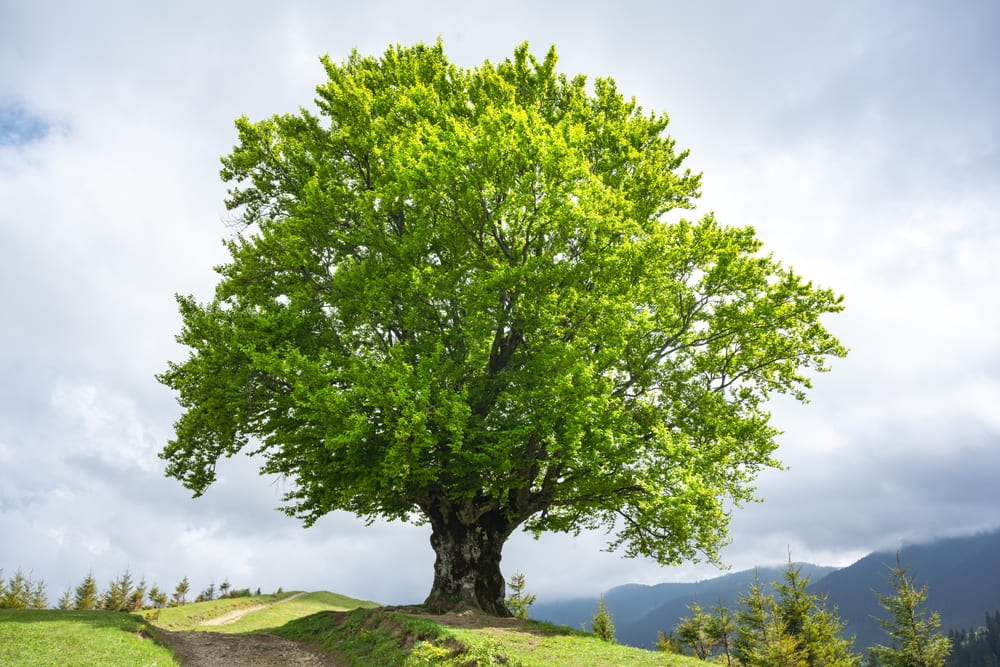
Beech trees are deciduous, wind-pollinated trees that can live for centuries. These trees can reach a height of about 80 feet. They are found in temperate regions, including Europe and North America. Beech is a durable tree that can grow in a wide range of soil conditions. The leaves are oval, glossy, and dark green, with parallel veins on both sides of the leaf. The bark is smooth and gray.
Beech trees can be very useful for shade. The fruit, which contains an edible nut, is eaten by birds and deer. This tree is also used by Indigenous Peoples for fuel and flooring. It grows well in moist, well-drained soils.
Beech trees have a distinctive serrated look to their leaves. The leaves of an American beech are ribbed and oval. The fruit, which is an edible nut, ripens in summer.
The fruit of an American beech is a three-angled nut that is eaten by deer, mice, and chipmunks. This nut is a favorite food of many squirrels.
The beech tree is widely cultivated in North America and European countries. It is a popular ornamental tree. It is also used as a source of wood for tool handles and flooring.
15. Tulip Tree
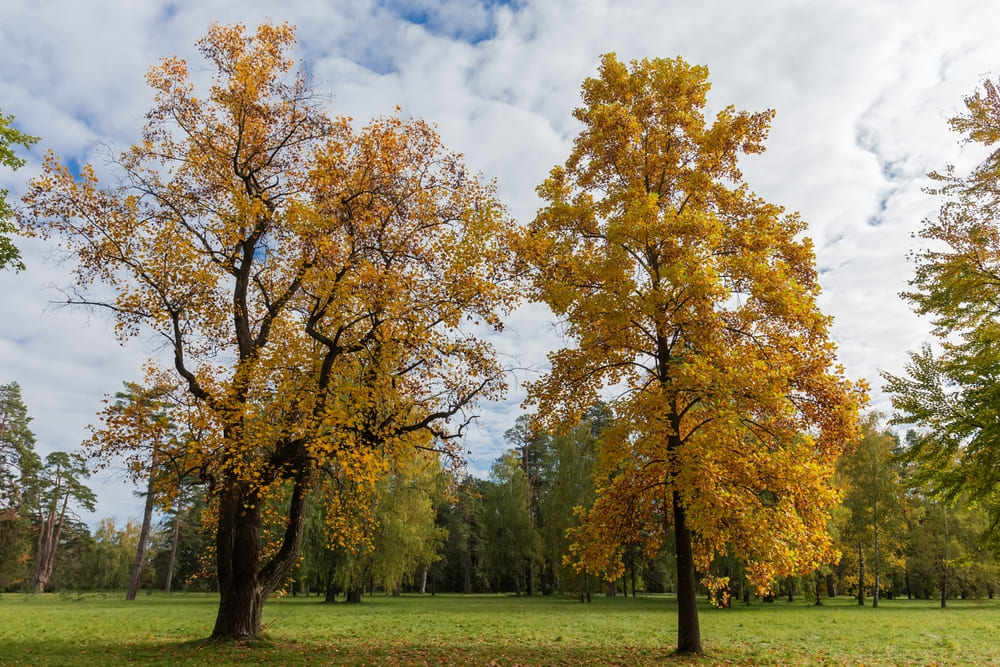
The Tulip Tree (also called the Tulip Poplar) is a fast growing hardwood tree that is native to the United States. It is widely planted in gardens and is also used as a tree for lining commercial entrances. Its large leaves are a beautiful feature. The tree can be found in woodlands, mountain forests, and swamps. It is a native plant of the northeastern and central United States.
This tree can grow to be as tall as 40 feet (12 meters). It is a useful and stately shade tree. It can be planted in full sun or in a more shady location. It is very popular for its luscious foliage and pretty flowering blooms.
It is the state tree of Indiana. It is one of the largest hardwood trees in North America. It grows in moist, loamy soils. The trunk can be as large as two meters.
In the fall, the leaves of this tree turn bright gold. The flowers are greenish-yellow on the outside with orange bands. They attract bees and hummingbirds.
16. Paper Birch Tree
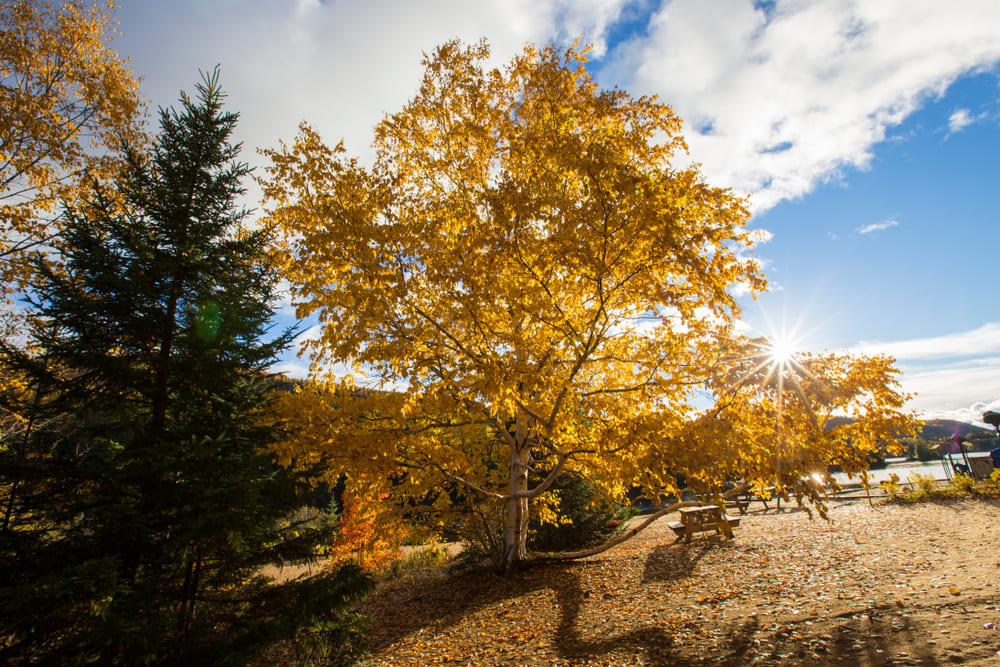
The Paper Birch is a deciduous tree which is found in the northern United States. It is a medium-sized tree that can grow up to 60 feet tall. It has attractive leaves and ornamental bark.
The Paper Birch is a pioneer species that has become an important part of the landscape. It thrives in sandy soils, as well as in moist soils by rivers. It is also adapted to urban landscapes. It can live in USDA zones 2b through 6.
The bark of the Paper Birch has been used for utensils and canoes by Native Americans. It was also used for medicinal purposes. It is known for its beautiful white bark.
The paper birch tree has a narrow oval crown and ascending branches. Its leaves are medium green in color and have two-to-four inch long leaves. The leaves have a smooth surface and three to seven sidelong veins.
The Paper Birch produces both male and female catkins. The female catkins are smaller. The male catkins form in the fall and produce pollen. The dry fruit of the paper birch forms in clusters on drooping catkins.
17. Butternut Tree
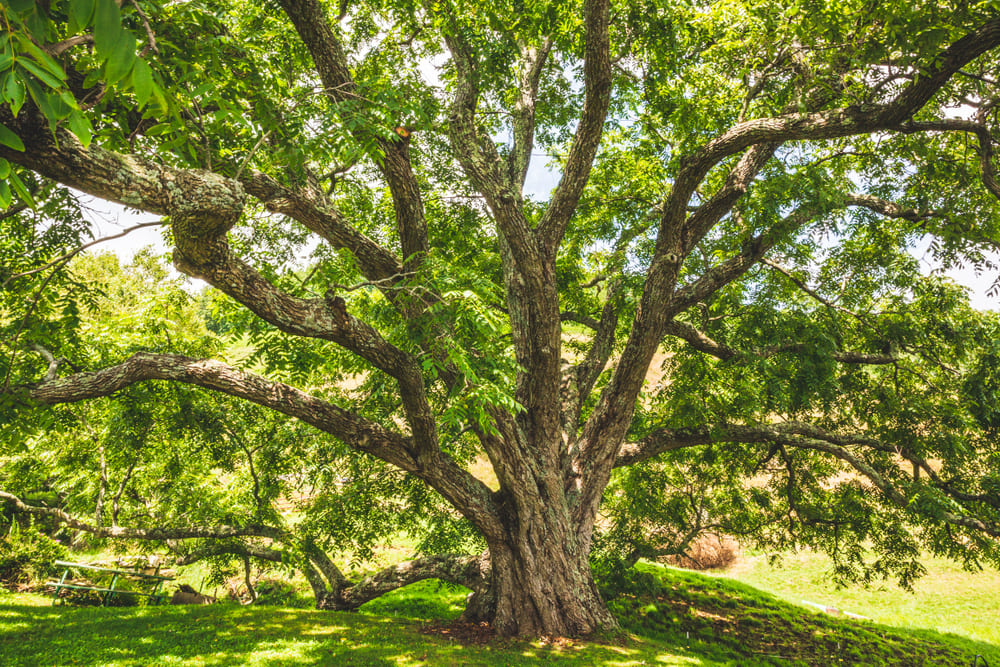
Butternut is an important tree in the United States. It is also known as white walnut. It is native to eastern North America. It is a medium-sized tree that usually grows to a height of around 40 feet. It is usually classed as a shade-intolerant species.
Butternut trees are monoecious. They produce flowers that develop on the shoots of the current year. The male catkins are bright yellow-green. The female flowers are short terminal spikes on the current year’s shoots. They contain a light pink stigma.
Butternut trees grow fast and can live for up to 75 years. They are also very susceptible to fire damage. However, they can tolerate a range of temperatures. They are generally considered to be more winter-hardy than black walnuts.
Butternuts are easy to propagate. Seeds germinate in the fall and mature in the spring. They can be planted directly from the ripened nuts or by grafting them onto other trees. They do not require fertilizing. They should be protected from rodents.
Butternut trees grow best in soil that is rich in nutrients. They also need about one inch of water per week. The root system of a butternut tree is extensive and deep.
18. Cherry Tree
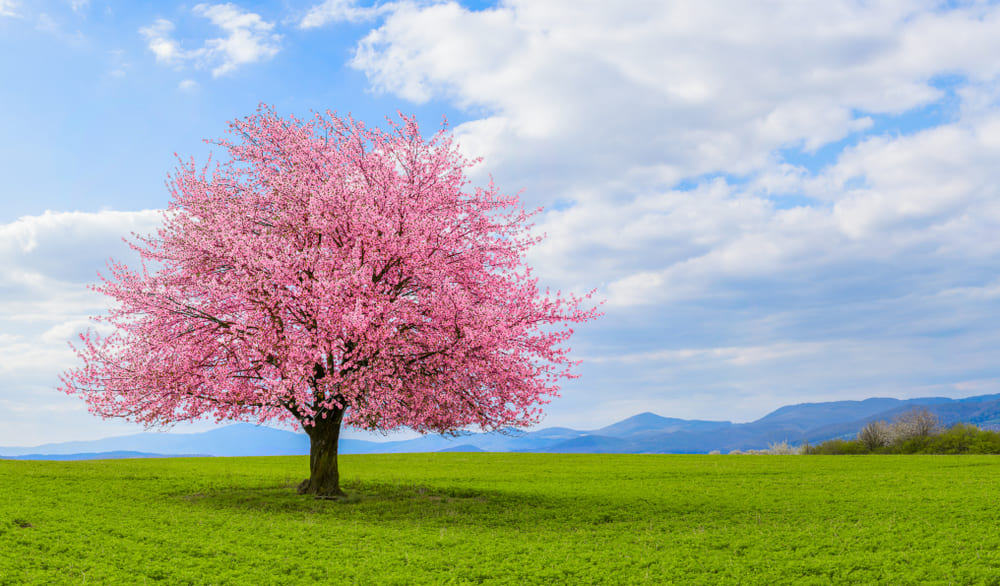
The wild cherry tree is found in woodlands. The leaves are 7-12 cm long with regular teeth. The stem has hairs on the veins.
It has lenticels that let the cells under the bark breathe. Its bark is glossy with a copper hue. The fruits are dark red. The seeds are slightly toxic. It is widely grown for timber in warmer European countries.
The Montmorency cherry tree is popular for its tasty tart fruit. It grows to 30 feet tall and prefers well-draining soil. The flowers are white.
Several species of the cherry tree are native to North America. Other varieties are native to parts of Europe. Besides cherries, cherry trees produce beautiful wood.
There are many types of flowering cherry trees, from the double weeping to the Japanese cherry blossom. Each has its own unique characteristics.
Cherry trees produce beautiful flowers that bloom in late summer. They have two glands on the stalk that attract beneficial insects. However, most varieties do not set fruit.
Cherry trees require full sunlight and water, and tend to be susceptible to disease and pests. They also tend to produce short-lived flowers.
19. Chestnut Tree

There are several types of chestnut trees. They range in size from small to large. They need to be planted in sandy, loamy soil. The mature trees can also benefit from irrigation.
The American chestnut tree is one of the most commonly grown chestnut trees. It is a fast growing deciduous tree, averaging 50 to 75 feet in height.
It has a canopy that is wide and can reach up to 100 feet. It grows best in USDA hardiness zones 5 through 8. It prefers full sun.
Chinese chestnut trees can be identified by their broad crown, serrated margins, and lanceolate leaves. They typically grow to 40 to 60 feet. They prefer warmer summers.
Chestnuts are a super beneficial plant. They are an excellent source of vitamin C, manganese, copper, and potassium. They are also very high in antioxidants. They are also an irresistible treat for rodents.
It takes 5-7 years for a chestnut tree to bear fruit. The fruit is sweet and edible. It is best to plant these trees after the last hard frost. If you want to harvest the nuts, you should do so in the fall.
20. Cottonwood Tree
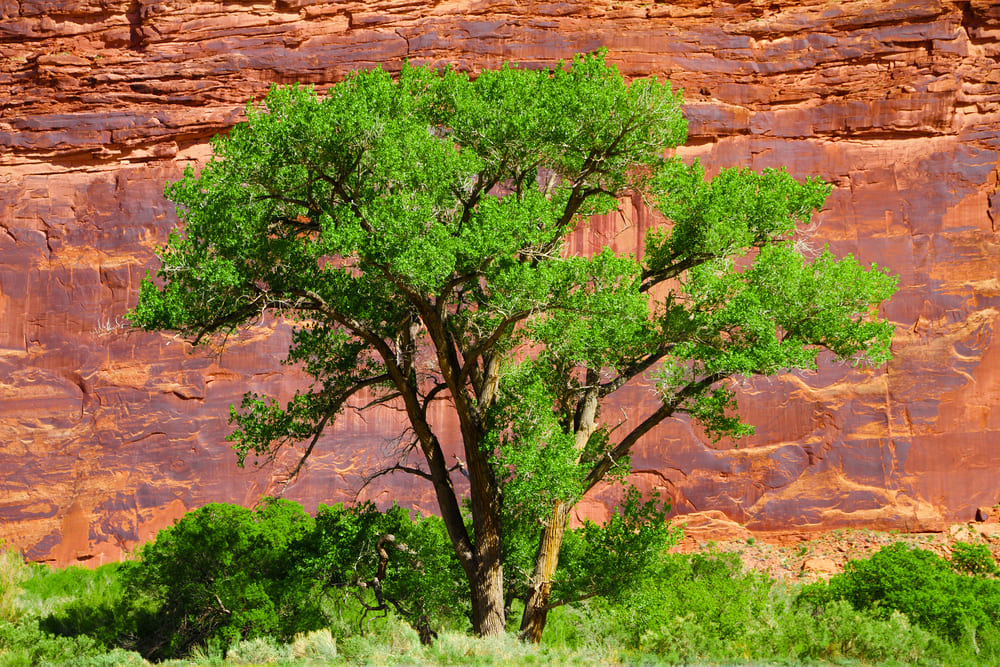
Cottonwood trees are found across North America. They are related to poplars, and they provide habitat for many animal species. They are also used for lumber, plywood, and matchsticks.
Although they are not a true tree, cottonwoods can grow to over 100 feet tall. They are often used for habitats, and their roots help slow down runoff from flooding. They can tolerate droughts and forest fires.
Cottonwood trees come in several different varieties. The most common are lanceleaf, eastern, and plains cottonwood. These trees can grow in various parts of the United States, from the Southwest to the Central US.
Eastern cottonwood is one of the largest hardwoods in the U.S. It grows along the edges of waterways. It is found in the east and throughout the northern part of the country.
The plains cottonwood is a common tree in western and southern Canada and Texas. It is the state tree of Wyoming. It grows to about six feet in diameter.
Its leaves are dark green, triangular, and glossy. The leafstalk is a little shorter than the midrib.
21. Cucumber Tree
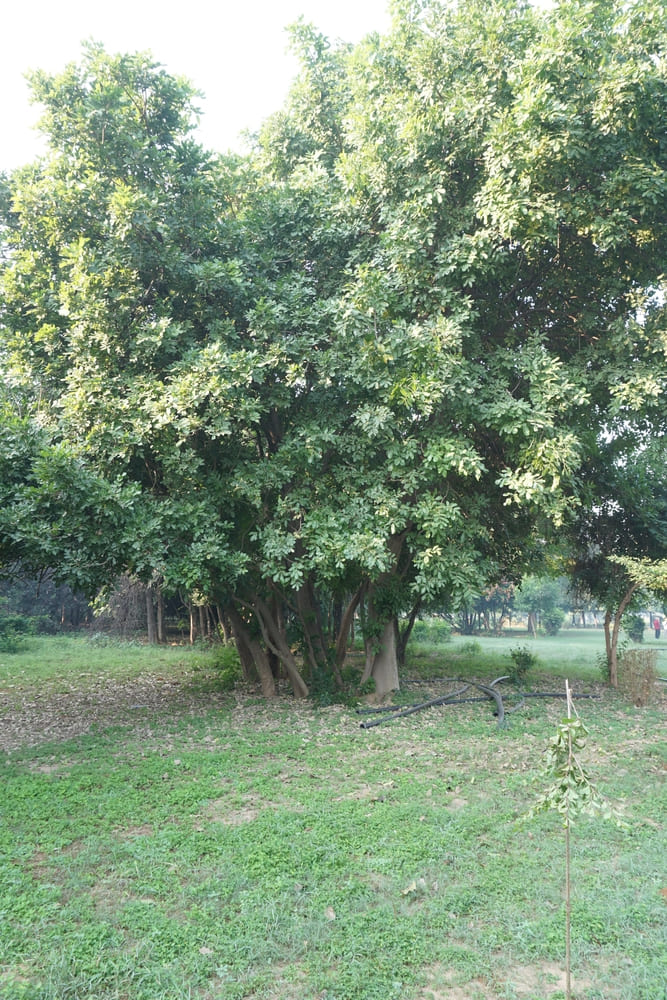
If you are looking for a shade tree that is both beautiful and easy to care for, you should consider planting a cucumber tree. This native tree grows in the eastern United States and is protected in Canada.
The tree grows in moist, well-drained soil. It is more common in southern New England than in northern New England. It is often planted in parks and golf courses.
The tree is fairly tolerant of pests and disease. It is also fairly resistant to drought. When a tree is first planted in a garden, it should be watered 4-5 times a day. The tree should also receive supplemental water during periods of drought.
This tree is a cousin of the tulip poplar. It has a thick trunk. It grows to about 20-30 m. Its bark is pale gray on young trees. The tree matures to brown.
The tree’s flowering season is from mid to late spring. Its flowers are small, yellow, and bell-shaped. The leaves are light green on the outside, but turn dark yellow in the fall. They have a nice scent.
22. Magnolia Tree

Magnolia trees are beautiful, long-lived, and relatively easy to care for. They are also resistant to many pests and diseases. There are two main types of magnolia trees.
Deciduous magnolias grow best in moist but not constant wet soil. They can tolerate sandy, clay, and loamy soil. However, they are especially susceptible to fungal diseases.
They require little pruning. Once established, they are hardy, tolerant of drought, and resistant to most pests.
They have long, pyramidal crowns, and leaves are alternately placed on the branches. In winter, some species lose their leaves. They can grow to a maximum height of 20 feet.
Magnolias are one of the oldest flowering plants. The first flowers appear in spring. The flowers have male and female reproductive organs and are bisexual. Beetles use pollen for food.
They can be grown in hot or cool climates. They are drought-tolerant, and can withstand hot summers. Some varieties are evergreen.
They are usually planted in a shaded location, or in a spot with good drainage. They are a favorite food for wildlife. They are also a valuable source of soil amendment.
23. American Elm Tree
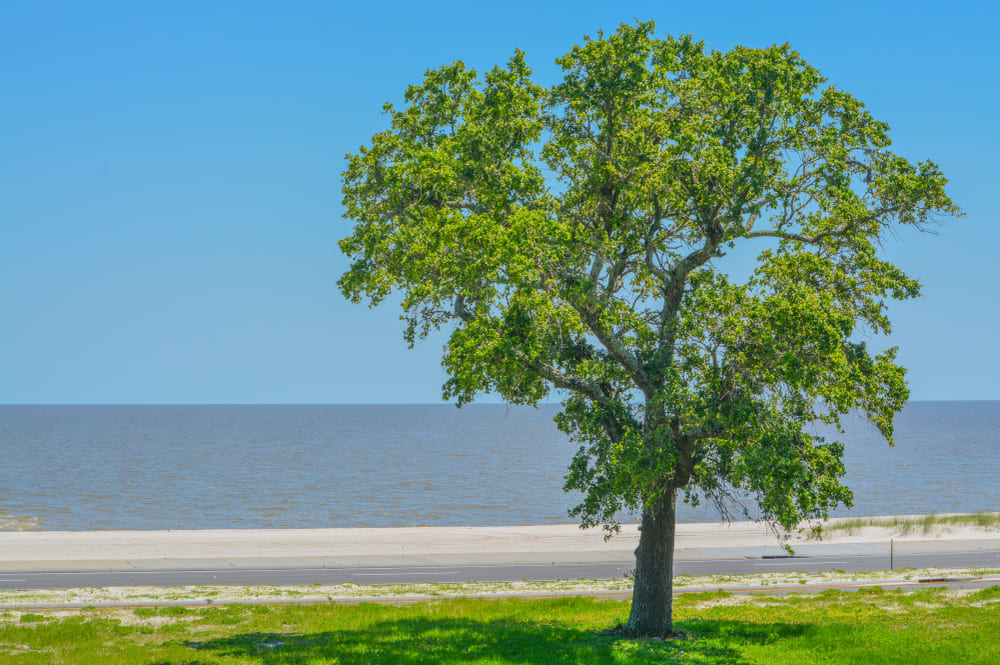
American elms are tall, fast-growing trees that can easily grow up to a foot per year. The tree grows best in full sun, but they can also adapt to areas that receive partial shade.
American elms can be identified by their grayish-brown bark and jigsaw-like shapes. They can be planted in containers and are resistant to Dutch elm disease.
They are also hardy. The leaves of an adult American elm are about six inches long. They are toothed along the edges and have a prominent midrib. The leaves have a tendency to break during storms.
The American elm is a hardy tree that is easy to care for. It requires little water and grows in a wide variety of soil conditions. In addition, it produces prolific seeds.
In urban settings, American elms have been planted for the shade they provide. However, they are prone to fungal infections. For that reason, they should be pruned from fall to late winter. This will ensure a strong, healthy branching structure.
When planting an American elm, it is important to choose a spot that gets adequate sunlight and has good drainage. It is also a good idea to mulch the tree with organic material to lock in moisture.
24. Hawthorn Tree
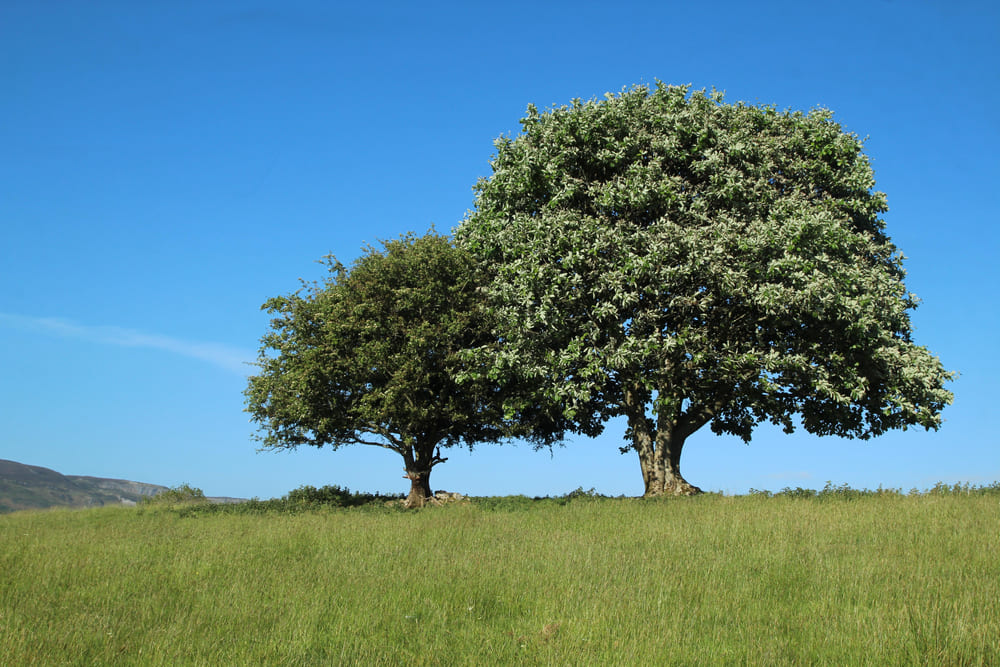
A hawthorn tree is a small, deciduous tree with beautiful foliage and flowers. It is popular for its ornamental value. It is a great addition to a garden, cottage, or suburban lot. It can also be used as a hedge. There are many varieties of hawthorn, each with its own unique characteristics.
The flowers of a hawthorn tree are reminiscent of apple blossoms. They are white, pink, or red, and are accompanied by a sweet fragrance. They provide nectar for pollinating insects.
The fruit of a hawthorn tree is a round red haw, similar to a rosehip. It grows with the flowers, and is eaten by birds. It can be made into jam, candies, and wine.
The bark of a hawthorn tree is grayish brown, and contains many small scales. It is very durable. However, it is susceptible to diseases such as leaf spot and powdery mildew.
Hawthorns are also prone to cankers. To combat this, you can apply mulch, which prevents evaporation of soil moisture. In order to ensure optimal health, you should consult a licensed arborist.
25. Honey Locust Tree
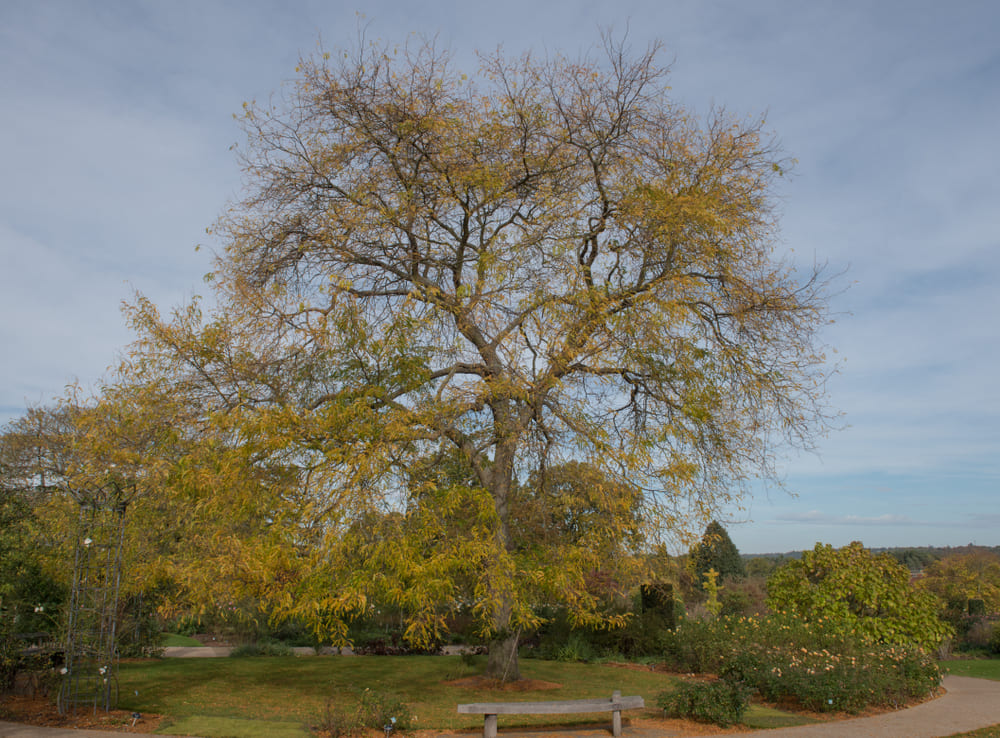
The Honey Locust Tree is a large deciduous woody plant native to the central North American regions. It is widely grown as an ornamental species. It is a popular landscaping tree and is commonly planted in parks, gardens, and in urban areas. The wood of the honey locust tree is rot resistant, which makes it ideal for a variety of uses.
The hard timber of the honey locust tree is used for a variety of crafts, including furniture and fencing. It is also used for firewood. The tree’s timber is dense and rot-resistant, making it ideal for small wooden construction projects.
The young bark of the honey locust is smooth and stout, but the bark of the older trees is often lined with ridges. The thorny branches of the honey locust tree have a stout, sharp appearance. The fruit of the honey locust is edible and provides nourishment to wildlife and livestock.
The flowers of the honey locust are small, greenish yellow and strongly scented. They are displayed on two to three-inch clusters. They are a valuable source of nectar for bees.
26. Hickory Tree
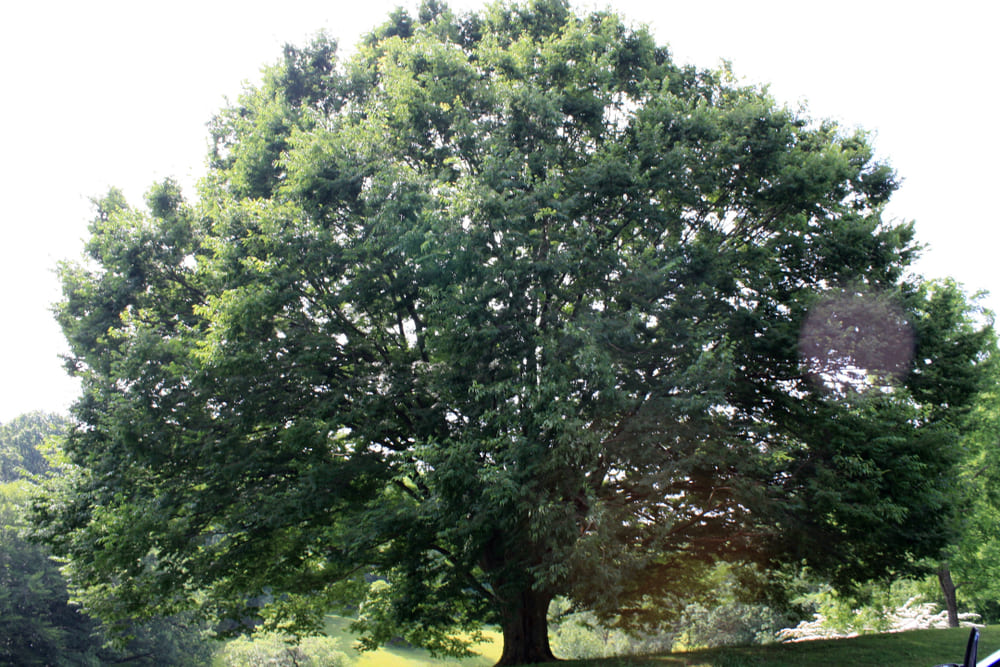
There are many different types of hickory trees. Some of the varieties are shagbark hickory, shagbark hickory, red hickory, black hickory, and pecan. The shagbark hickory is the most common hickory tree found north of the Missouri River.
The leaves of a hickory tree are feather-compound. Each leaf has five to seven leaflets. The middle leaflets may be larger than the others. A hickory’s leaves are typically golden yellow in fall.
Hickories are native to the tropical and temperate rainforests of Asia and North America. They are commonly used for food and timber. They are known for their smoky effect when grilling. They have a hard, shock-resistant wood.
Hickories can be planted in full sun, partial shade, or in the shade. They prefer rich, moist soil. Often they grow along streams. They also produce nuts. A hickory tree will grow about 75 to 100 feet tall. They should be pruned for diseased limbs or dead twigs. They should not be planted near power lines. They can also be treated with fertilizer.
27. Hophornbeam Tree
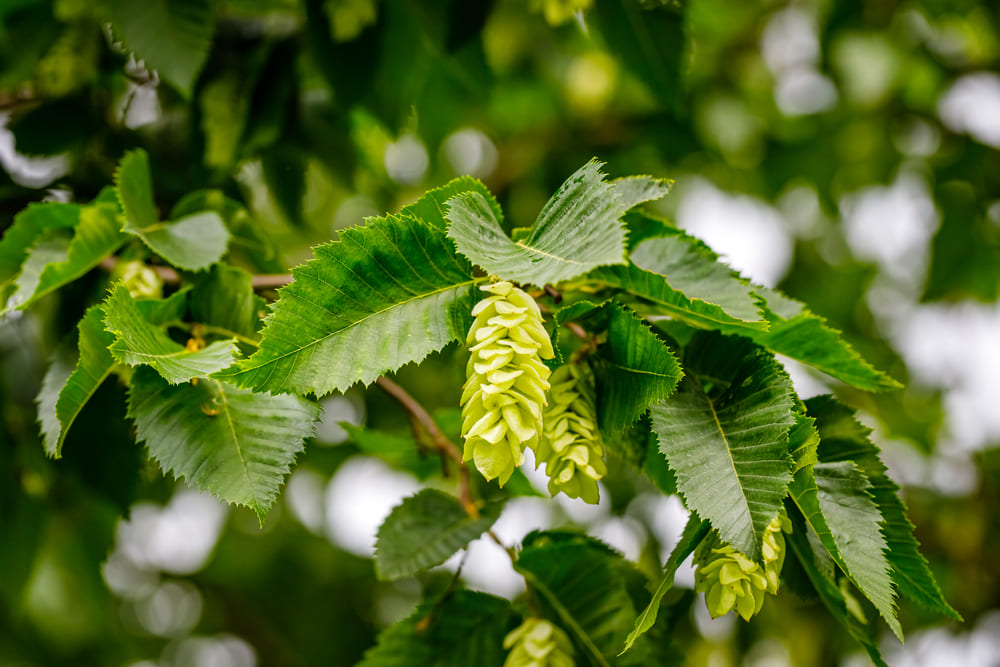
Hophornbeam is an understory tree with a relatively small diameter and a slow growth rate. It is also a good choice for landscape settings because it tolerates a variety of soils and light conditions. It is best grown on dry or wet sites, in partial shade, and in well-drained soil. It is appropriate for parks and other natural areas.
Eastern hophornbeam occurs in a wide range of moisture-drainage classes and on a variety of soil textures, from shallow, wet sands to deeply buried limestone. It occurs throughout the eastern half of North America. The species grows at elevations between 75 and 980 feet, and it is hardy to zone 3 in most areas.
During the spring, male catkins are born in clusters. These catkins are light green and shaped to pick up pollen from the wind. The flowers mature to about 5 cm (two inches) in length. The female catkins develop late in the season. The fruits are papery sacs. They contain nutlets.
American hophornbeam trees are primarily found on the east coast of North America. They are also grown in Canada, Honduras, Guatemala, El Salvador, and Mexico. They are slow-growing, making them ideal for city parks and parking lots. They can be planted in containers or root-control bags. They can be grown in rocky, moist, or alkaline soils, but they are not tolerant of flooding.
28. Tamarack Tree

The tamarack is a small to medium-sized upright deciduous conifer. It is found in a wide variety of locations, from southern Canada to northern British Columbia.
It is native to northern bogs and other wet areas. It grows best in moist soils, although it can tolerate some light shade.
It can grow in a variety of climates, including hot, humid, and cold. Its cones can persist on the tree through winter, making it attractive in the fall when the needles have fallen.
It is a good idea to plant a tamarack in a spot with a warm, moist, and nutrient-rich soil. In addition to a deep, well-drained, loamy soil, it is also important to add organic mulch around the base of the trunk. This will help retain moisture and improve germination rates.
The tree grows in tufts of 10 to 20 and grows vertically. It will reach a height of 15 to 25 meters. Its wood is used in lumber, poles, railroad ties, and fuelwood.
The leaves of tamarack are pale bluish-green in summer, but become yellow in autumn. Its bark is pinkish-gray.
29. Larch Tree
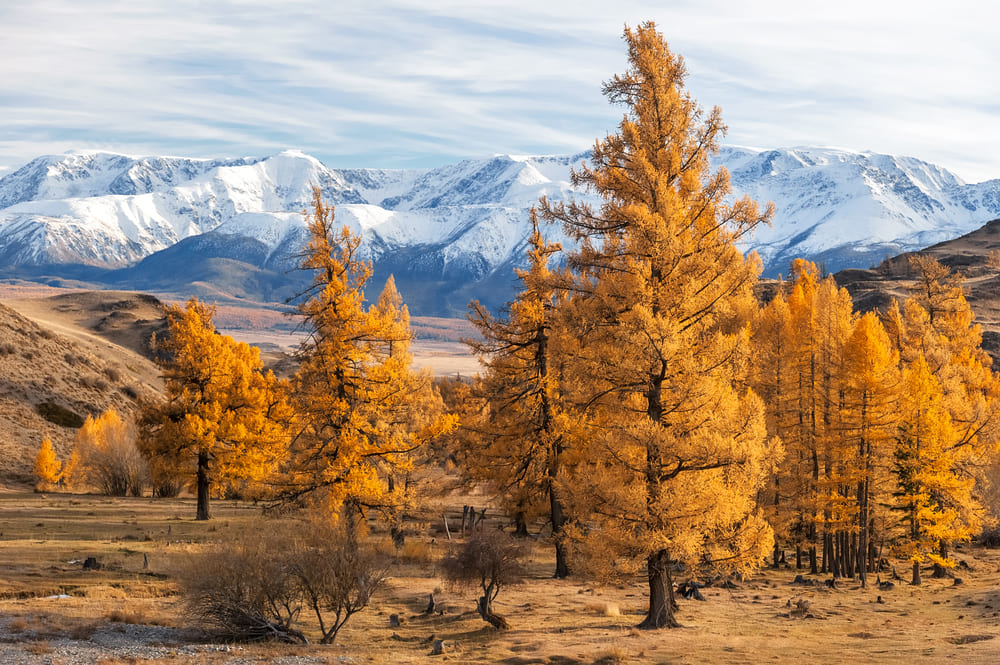
Larch tree is a species of cone-producing conifer that is native to the northern hemisphere. They grow well in cold climates with plenty of moisture. It can be used for fencing and boat building. Larch lumber is available in both European and Japanese varieties. It is also useful for woodworking and furniture making. Larch timber is often found in forests in western Canada and northern California.
Larch is a fast-growing conifer that grows well in mountainous regions. It is an ornamental tree that is ideal for a park or other rural landscape. It also makes a good addition to a rock garden. The needles are bright green in spring and turn golden in the fall. The tree can grow 2′ to 3′ tall in ten years.
Larch trees can be planted in a variety of locations, although it is best to plant it in moist soil. Its branches are thin and pyramidal, and its bark is pinkish or reddish brown. Larch trees can tolerate a wide range of weather conditions, and are able to withstand most forest fires.
30. Maple Tree
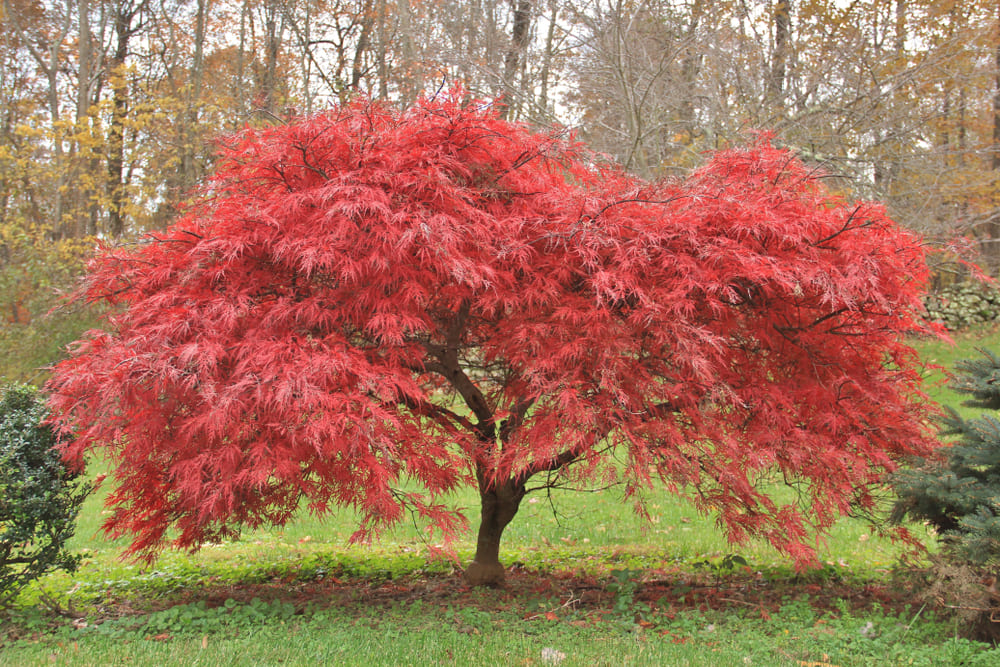
Maple trees are among the most popular ornamental trees. They are native to North America, Asia, and Europe. They are known for their vibrant colors and striking autumn foliage.
They also provide dense, hard wood. Some species are evergreen, while others are deciduous. In addition, maples provide important pollen and nectar to many insects, including bees.
Generally, maples grow best in warm, wet climates. They are hardy and can withstand sub zero temperatures in the lower United States. However, they are not tolerant of hot, dry conditions.
Maples are part of the family Sapindaceae. They are a large genus that has more than 100 species. Several species are found in China. Some are native to the Mediterranean region.
The leaves of the maple tree have three to nine veins. They are lobed and have pinnate veining. The leaf’s upper surface is bright green, while the underside is silvery.
Most maples have smooth bark, but some species have brittle bark. The sap from maples is sweet. It can be collected from the bottom stem bark or from cuttings. It can also be made into syrup.
31. Oak Tree
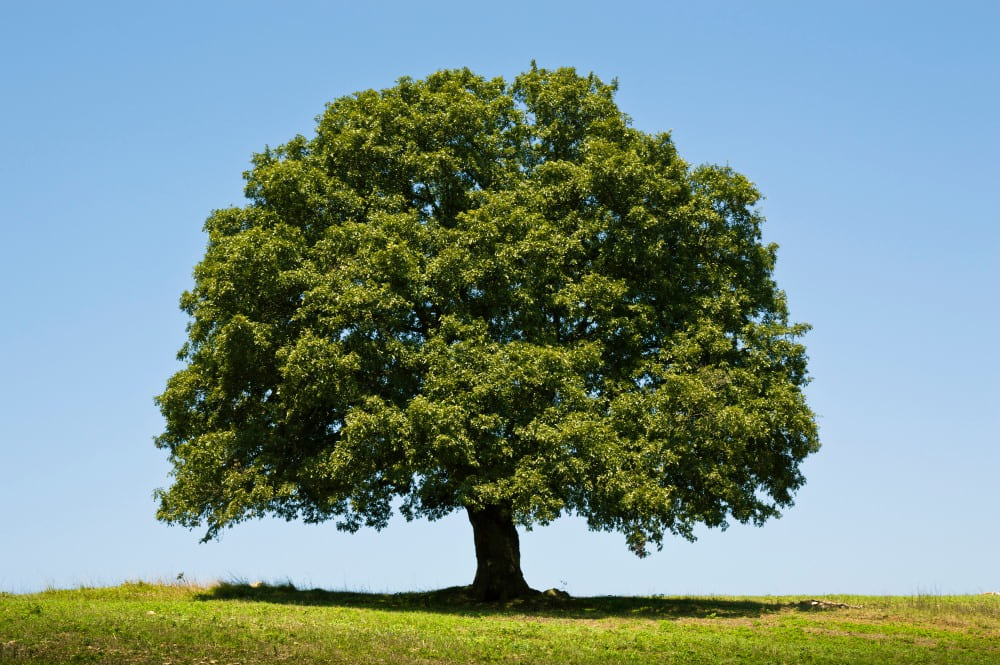
Oak trees are beautiful and majestic hardwood trees. They are usually characterized by their large, rounded canopies and strong branches. They also provide shelter and food for many different living things. These trees are often used as a source of durable wood.
Oaks are a member of the Fagaceae family, which is native to the Northern Hemisphere. There are over 600 species of oak.
Oaks are a source of food for animals, birds, insects, and spiders. Their acorns are eaten by mammals. Some species of oak are deciduous. Others have evergreen leaves.
The acorns of oaks can be shaped like a ball or a pointy disk. Acorns are encased in a thin papery skin. They are eaten by deer, mice, and badgers. They are also used for acorn coffee.
In addition to providing food, oak trees provide a place for birds to rest and shelter for many animals. The oak tree has been revered since ancient times. The oak was sacred to the Slavic god Perun and to the Baltic god Perkons.
32. Pine Tree
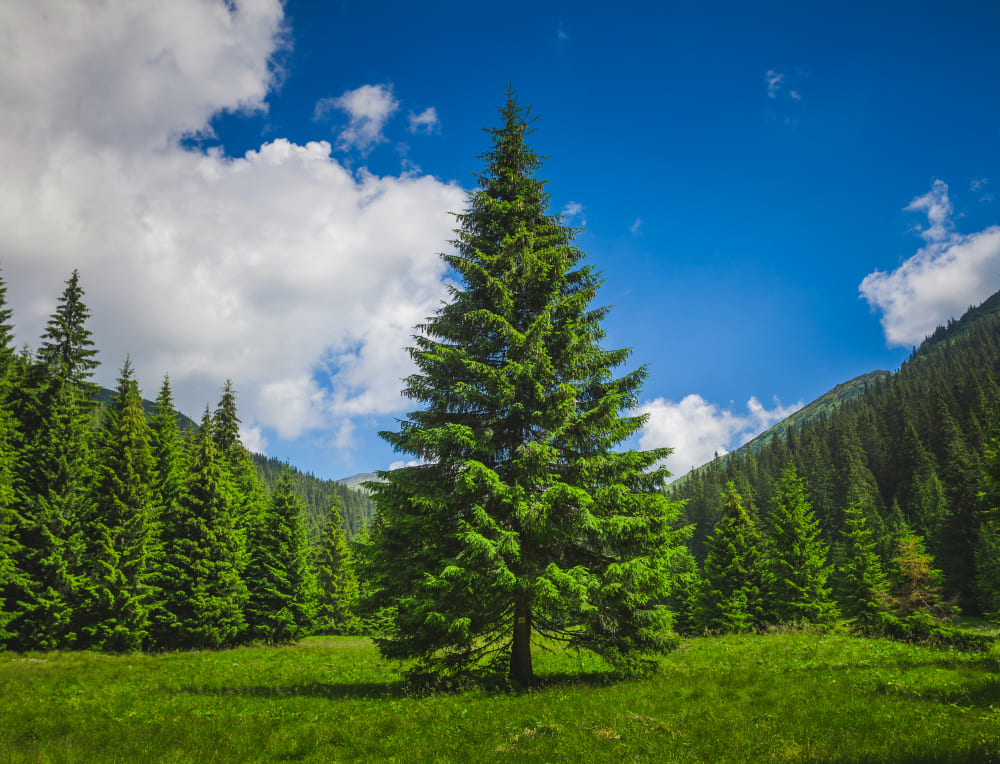
Pine trees are found in various species all over the world. They are categorized into a number of categories, such as the size and color of the bark, needles, and cones. Using these factors, you can determine which type of pine tree you want to plant in your landscape.
Aside from these, you can also determine the species by looking at the manner in which they grow. Some pines grow straight up from their branches while others grow upward and outward. You can also recognize a pine tree by its seed-bearing cones. Some have globose or egg-shaped cones, while others have long, straight or slender ones.
Some of the types of pine trees are known for their reddish brown or gray bark, while others have black or purple markings. In addition, the scales of the cones are slender and thin. The cones are usually opened to release pollen or seed, so they are good for wildlife.
Another type of pine tree is the Austrian pine. This pine is classified as a hard-needled pine. This species is commonly found in the eastern and northern United States. The trunk of this pine is very rigid. It is also tall, growing to a height of 100 to 164 feet.
33. Sassafras Tree

The common Sassafras tree is native to North America. It is a small to medium-sized tree that grows to about 40 to 60 feet tall. It is also very hardy, and a good choice for roadsides. The tree has beautiful leaves that turn various colors in the fall. It has a pleasant citrus aroma and its flowers are pretty and aromatic.
The Sassafras tree requires plenty of water and regular attention. It is also prone to ice storm damage. However, it is not affected by many diseases.
Sassafras is a dioecious plant, meaning that it has both male and female trees. Female trees produce a red stalk, a drupe and a cup of fleshy fruit. The fruit matures in August or September of the first year.
Its leaf shape is usually three-lobed. It grows in a variety of soil types. It prefers a rich, moist, acidic loam. It is also intolerant of shade.
The sassafras tree can be propagated fairly easily from root cuttings. It can be grown as a specimen, but it is best suited to a transition zone between a garden and a natural area.
34. Serviceberry Tree
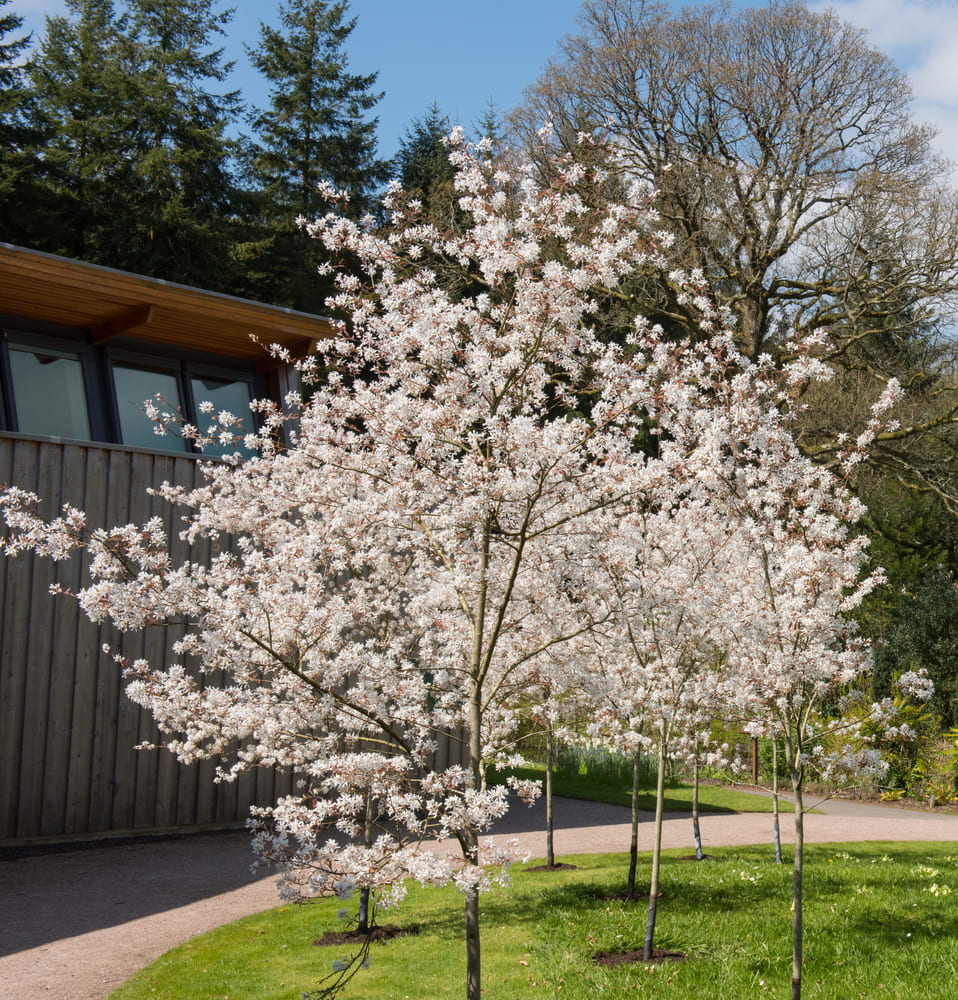
A serviceberry tree is a fruit tree. They are hardy trees that can thrive in a wide variety of conditions. They are easy to grow and are not difficult to care for. They are best planted in a sunny spot with rich moist soil. They are known for their fragrant white spring flowers.
They can be grown as a shrub or as a tree. They produce delicious, juicy fruit. They are also a good food source for birds. Some of the fruits are eaten raw and others are used to make jams and jellies.
They are native to North America. They are found growing in woods, fields, and along the shores of lakes and rivers. They grow well in a range of light and soil conditions.
They are a hardy, drought-tolerant, and low-maintenance plant. They can be grown as an ornamental shrub or as a tree. They are easily propagated by cuttings taken from the base of a tree.
They are commonly known as June berry, shadbush, or Saskatoon. There are 33 species of serviceberries. Some of them are native to Asia and Europe, while others are found in North America.
35. Walnut Tree
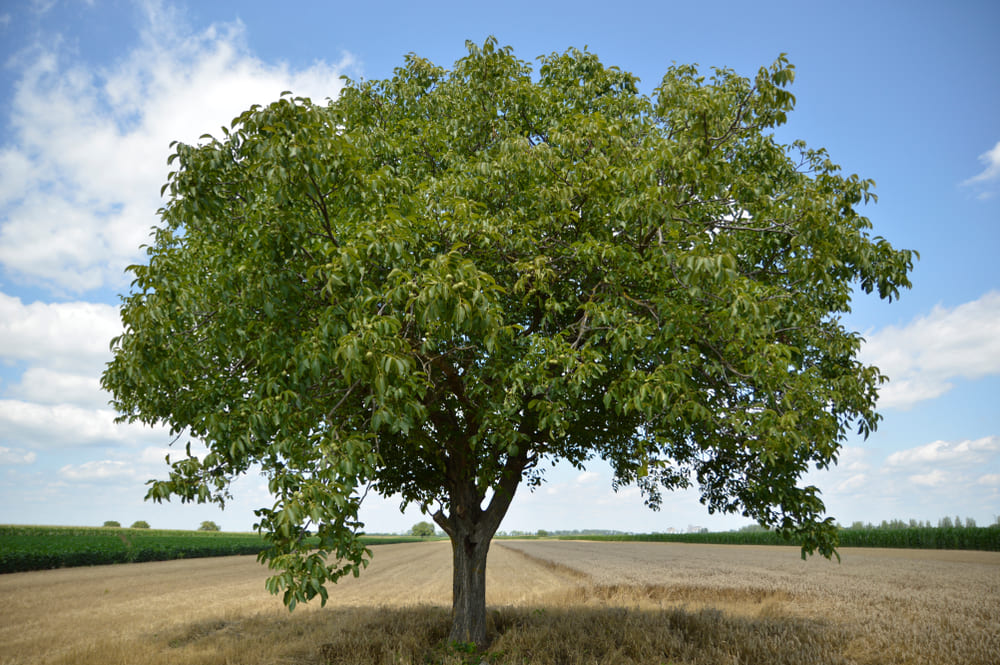
Walnut trees are a group of native trees. They are found in both North and South America, Europe and Asia. They are monoecious, meaning that there is a male and female flower on the same tree. They are commonly planted in gardens.
Walnuts have been used for a variety of purposes. For example, the husks of walnuts have been boiled to produce a dark yellow dye. They are also used to polish and varnish wood. They are an excellent source of vitamins, minerals and omega-3 fatty acids.
The American walnut tree is a highly hardy, fast growing species. It is primarily grown as an ornamental in colder temperate regions. It can reach full size within 20 years. The tree has a dense, rounded crown.
Black walnuts grow from the west to the Great Plains. They are frequently seen with red oak, basswood, sugar maple, and beech. The fruit is heavy and lime green.
Black walnuts are an important food source for many species. They can be eaten by both humans and animals. They are known for their taste and hardness.
36. Willow Tree

Willows are tall deciduous trees. Their bark is used as a tonic, astringent salve, or a poultice. They have been used medicinally for centuries.
In the United States, they’re often seen alongside bodies of water. Their roots are strong, and they can withstand drought. However, they don’t have a very long lifespan. They’re susceptible to flooding.
If you want to keep your yard clean and safe, it may be time to plant a willow tree. They’re a great choice if you’re prone to flooding or if your property is close to a body of water.
Willows are often used as windbreaks. Their branches are flexible like reeds. They’re also useful in erosion control. The willow’s limber extremities help it tolerate a range of soil types.
They’re one of the first woody plants to leaf out in spring. They’re also a useful source of nectar for bees.
Willows are also a valuable biofuel source. They’re especially beneficial during drought. Their root systems are large, and they’re able to absorb as much water as possible.
37. Dogwood Tree
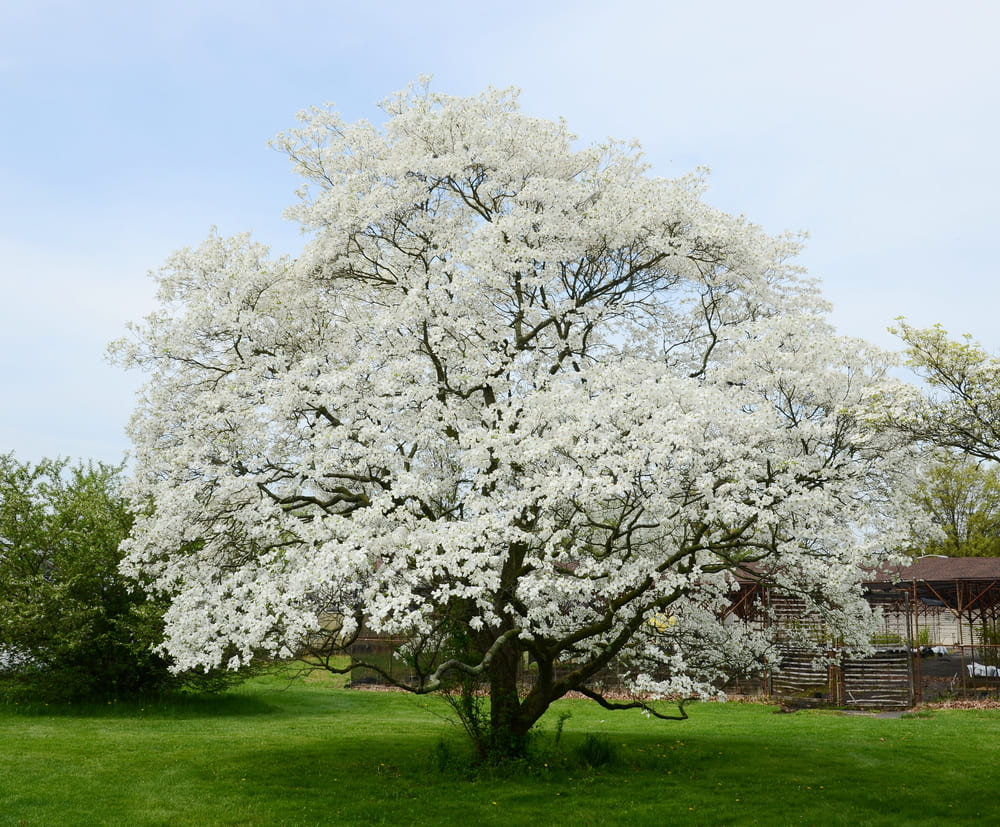
Dogwoods are woody plants that are native to Asia and Europe. They are a member of the family Cornaceae. Some species are evergreen, while others are deciduous. They are popular for their simple, untoothed leaves and showy spring blossoms.
They are native to North America and are found in parts of Europe, China, and Japan. Some are used for medicine, while others are consumed.
They produce a fruit that birds love to eat. In fact, 36 different species of birds nest on the tree’s horizontal branches. It also produces useful bark and bracts.
They grow best in moist, slightly acidic loam or compost. They also prefer part shade. However, they do not grow well in arid or semi-arid climates.
Their bark has tannins and can be used for medicinal purposes. The bark’s outer layer is commonly applied as a treatment for pneumonia, malaria, and other diseases. It can also be used for carving.
The flowering dogwood, or cornel, is a popular type of dogwood. The small creamy white flowers bloom in clusters. They are covered with large petal-like bracts.
38. Flowering Gum Tree

The red flowering gum is a popular tree in landscape gardens in Australia. The trees grow fast and have thick rounded canopies. They are extremely tolerant of drought. However, they need to be watered regularly to avoid root rot. They also need to be planted in well-draining soil.
They are easy to care for and are known for their aromatic flowers. They are also resistant to pests and diseases. They can be treated with insecticides or neem oil.
These ornamental trees can grow up to 20 feet tall. They are a great addition to a garden, especially if you live in a city. They are also well-suited for smaller spaces. They do have some drawbacks though, such as their large, sticky flowers. The blooms can cause mess on vehicles and buildings.
They can be overwatered, which can result in leaf yellowing. They are sensitive to phosphorus. They also tend to be very tolerant of shade, although they are best planted in full sun.
The flowers of the red flowering gum are attractive to pollinators. They have cup-shaped stamen bases. They can be in different shades of red, orange, and pink.
39. Water Gum Tree
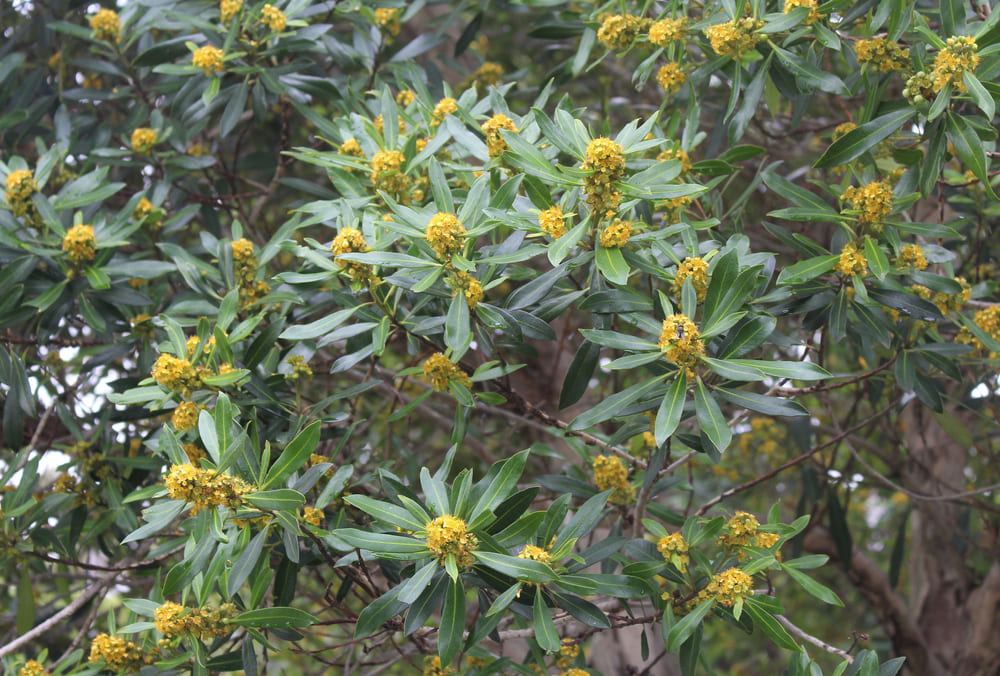
The water gum tree, Tristaniopsis laurina, is a native tree of Australia. It is a member of the Myrtaceae family. It is found naturally along the eastern and southern coasts of Australia. It is popular for its ease of care. It is commonly used as a street tree in urban areas.
It is often used to line streets, especially in cities like Sydney. Its bright summer flowers attract birds and butterflies. It also helps with erosion control.
When growing, it prefers a moist, sandy loam. It does well in both warm and cool climates. It grows to between 5 and 15 meters tall. It is a good shade tree. It is also salt tolerant.
The leaves are glossy dark green. They have a narrow width and a prominent vein running through the center. The underside is paler.
The flowers are yellow. They are arranged in clusters and are very fragrant. They are a vital food source for bees. They have five small rounded petals. They are born in short clusters. They can be self-pollinating.
40. Balsam Fir Tree
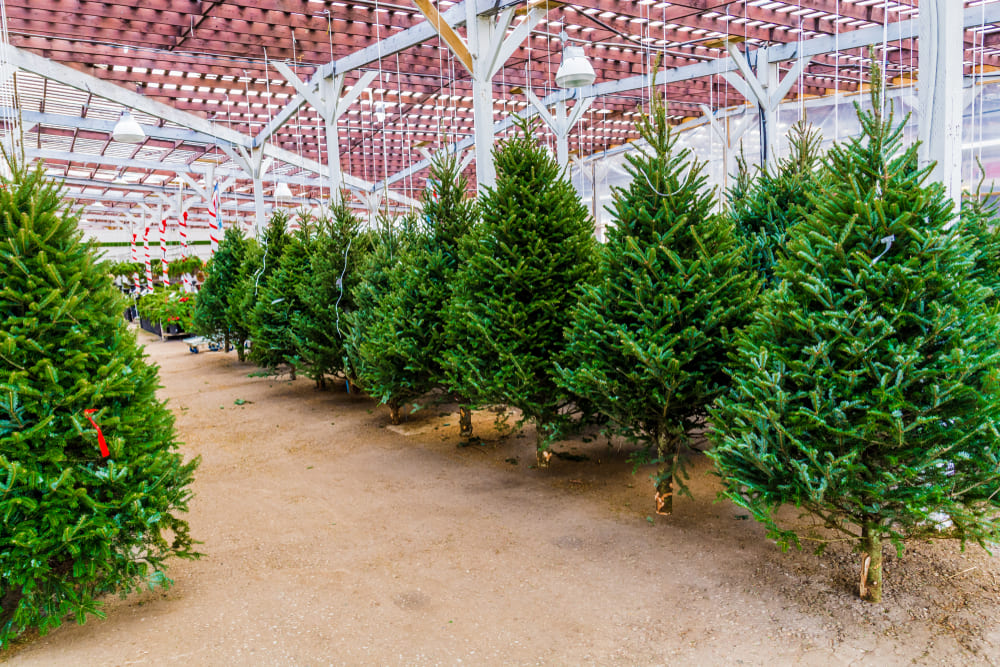
A balsam fir tree is a conifer that grows well in cooler climates. It is widely distributed throughout the northeastern United States and Canada.
It is a medium-sized tree that is typically 45 to 65 feet in height. It is commonly used for windbreaks and privacy screens. It is also used for lumber.
Balsam fir trees are known for their evergreen foliage and aromatic scent. They are favored by many wildlife species. They can provide food for birds, squirrels, and moose. They also serve as an effective shelter for a variety of other animals.
A balsam fir tree’s distinctive bark is covered with resin blisters. These blisters are shaped like warty bumps on the trunk. These blisters contain a sticky substance that can be eaten if you need to.
A balsam fir’s foliage is also very thick and cuts the wind. This dense foliage also makes it easier for animals to move around.
Although balsam fir is a good choice for landscaping, it is not a good choice for hot, humid climates. It requires adequate water, but too much can cause it to uproot.
41. Fraser Fir Tree
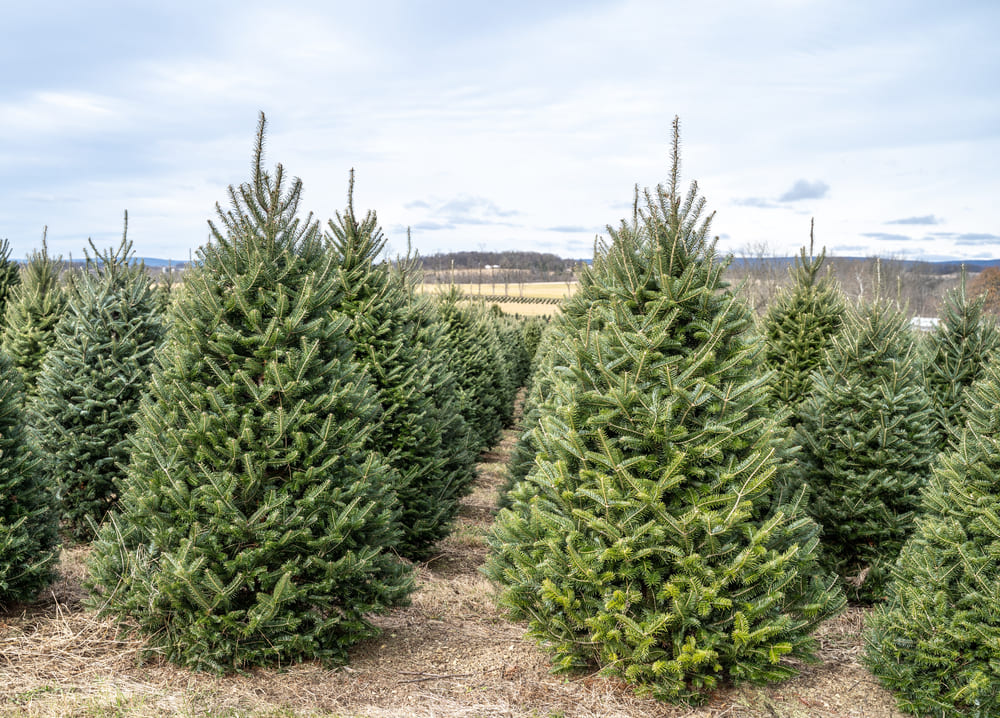
The Fraser Fir Tree is an evergreen tree that belongs to the Pinaceae family. It is native to the Appalachian Mountains of the Southeastern United States and North Carolina. It is also found in southwestern Virginia and eastern Tennessee.
The name Fraser comes from the Scottish botanist John Fraser, who explored the southern Appalachian Mountains in the 18th century. He was also a competitor and collaborator with Andre Michaux.
The Fraser fir grows naturally at elevations above 4,500 feet in the southern Appalachian Mountains. The average height of the mature tree is about 50 feet. They are commonly found growing in stands with red spruce trees.
The Fraser fir is an excellent choice for indoor decorating. It can hold a wide variety of decorations and can easily be groomed. Its strong branches and sturdy appearance make it a great choice for smaller spaces.
The fir has a very distinctive look, with silvery-green needles that give it an attractive sheen. In addition, the trees are durable and do not require pruning.
They have a sweet, odorous fragrance, similar to that of the balsam fir. The flower buds are located on the top half of the crown. They typically open in mid-May to early June. The fruit is an erect cone, about 3.5 to 6 cm long.
42. Douglas Fir Tree

The Douglas Fir is a tree with a long history. It is native to western North America. It is a valuable timber resource. The wood is used to make furniture and doors, as well as plywood veneer.
The Douglas fir is a member of the conifer family Pinaceae. Depending on the location, the tree can grow to heights of 85 meters. The largest known specimens are found on the west coast of Vancouver Island in British Columbia. They can also grow to over a thousand years of age.
The Douglas fir is a popular ornamental tree. They have a soft, flexible foliage and are hardy. They are also a source of shelter for animals. They are also useful for reforestation along the Pacific Coast.
Douglas firs are found throughout the world. They are considered to be one of the best timber trees in North America. Their wood is used to make windows, doors, and poles.
The Douglas fir has a moderate growth rate. It is susceptible to insect problems. It also has the potential to die when stressed.
43. Hemlock Tree
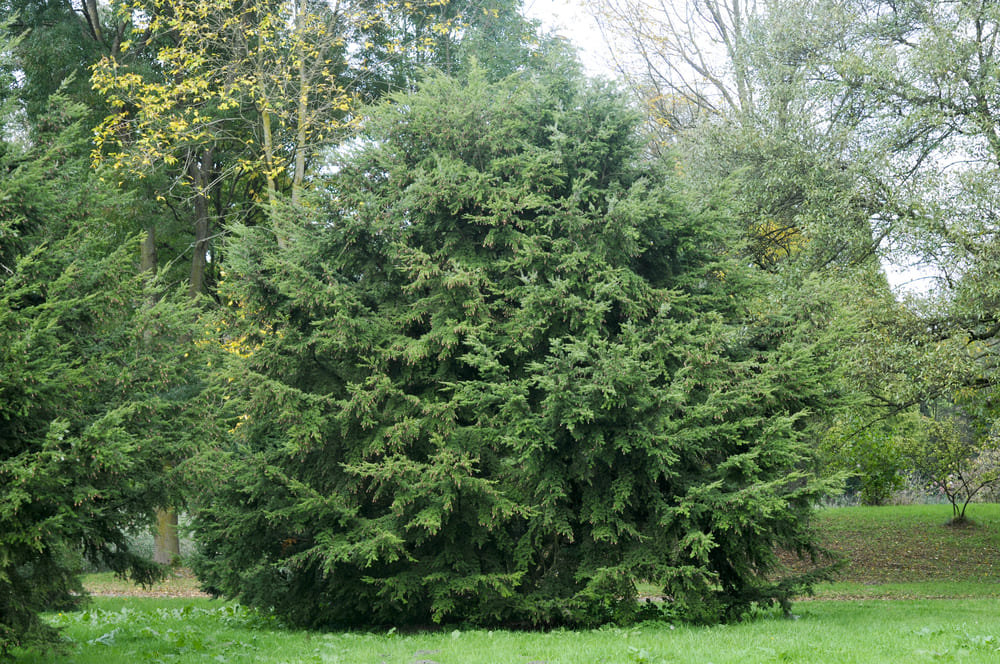
A hemlock tree is an evergreen conifer, and is part of the family of gymnosperms. It’s important to both humans and wildlife, as it provides shelter and food for a wide range of mammals. They also play a crucial role in preserving the water supply and filtering agricultural runoff.
Hemlocks are a common species in North America. They can be found in riparian zones, along stream corridors, and in forests. They have a dense canopy that moderates the temperatures of the forest floor. The wood of hemlocks is useful in a variety of applications, including doors, staircases, and architectural millwork.
These trees are also used to make tea and tan leather. They are an essential part of the habitat of many birds, such as the black-capped chickadee, and the blue-headed vireo. They are also an important food source for deer, porcupines, and northern flickers.
Hemlocks can live for up to 800 years. Their long life is attributed to their ability to survive in deep shade. They can also help protect a wide variety of aquatic habitats.
44. Juniper Tree

Juniper trees come in a variety of shapes, sizes, and textures. Some can grow as tall as 30 feet, while others can be a low-branching shrub. No matter what you choose, junipers are an attractive addition to your garden. They also make a great specimen plant.
There are more than 60 species of junipers, and each of them has its own unique growth pattern. They are adapted to a wide variety of climates, making them easy to grow in both warm and cold regions. In addition, they are also drought resistant, making them great for garden landscapes.
Some junipers are dioecious, meaning they produce male and female structures. The male structures are tiny and globular, while the female structures develop into berry-like cones that birds eat. The berries are bitter.
Junipers can tolerate a wide variety of temperatures, but they do best in mild, sunny climates. They are a good addition to a mixed bed or shrub garden. They are very adaptable to windy sites. They are also deer-resistant.
A common juniper is found throughout the United States and Europe. These shrubs have needle-like leaves that are a glossy green. Their bark is red-brown.
45. Spruce Tree
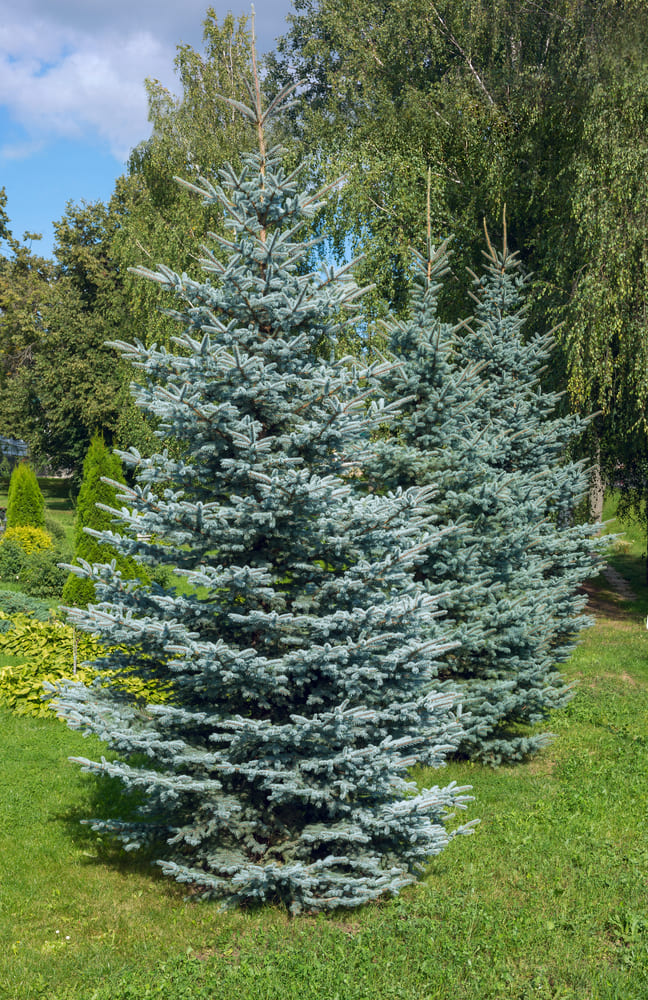
The spruce tree is an evergreen tree that grows from the genus Picea. The term “spruce” is derived from the verb pix, which means “pitch”. These conifers are native to cool climates in the northern hemisphere. They are used for a variety of purposes, including acoustic guitars, wood pulp, and basketry.
There are about 35 species in the genus Picea. The majority of these are grown as ornamental trees. Some are also used for timber. The spruce is an excellent Christmas tree, as well as being popular for landscaping.
Spruces are widely planted in many areas, particularly in the United States and Canada. The Norway spruce is especially popular as a Christmas tree. There are a number of cultivars of the spruce that are available, such as the dwarf Alberta spruce.
Spruces are known for their attractive bark and narrow-conic growth habit. They are also highly admired for their needles. The needles are attached to the branches in spiral formation. This makes the tree easy to identify.
The spruce is very adaptable to dry and wet conditions. Its fine-grained wood is useful in many construction and musical applications.
46. Redwood Tree

The Redwood tree is among the world’s fastest growing trees. They can grow up to 30 feet tall in the first 20 years. They can then continue to grow for centuries. They are very resistant to rot, insects, and fire.
A mature Redwood can produce up to 100,000 tiny cones in a year. Each cone holds up to 100 seeds. Each seed has a small amount of viable pollen that floats in the air, carrying it to the next generation.
The female flowers typically occur in the upper canopy of a forest, while the males are lower. The pollen-producing male flowers are yellowish brown.
The Coast Redwood is a large tree with a conical crown and branches that can be horizontal or vertical. It has a root system that is composed of shallow, wide-spread lateral roots.
The bark of the Redwood is soft and fibrous. When it is freshly exposed, it is bright red. However, the bark weathers and becomes dark and dry after being exposed to the elements. It may be up to a foot thick.
47. Tanoak Tree

The Tanoak tree is a species of trees in the beech family. It is native to southwestern Oregon and northwestern California. The wood of the tree is used for furniture, truck bedding, and veneer.
Acorns from the tanoak are a significant source of food for many animals. They are also an important part of the Indigenous economy of northern California. In the past, tanoak was used by indigenous tribes to make medicine, clothing, and blankets. It also provided shelter for mammals and birds.
The bark of the tanoak has an extract used to tan leather. It was once the main commercial source of tannin. The tanoak was once considered a valuable timber and a food source by both Indigenous peoples and Europeans. However, over the years, the tanoak was exploited and is now threatened by a variety of environmental threats.
Scientists, conservationists, and concerned citizens are working to save the tanoak tree from extinction. Fortunately, the tanoak tree has a strong resistance to some of the threats it faces. It is currently experiencing a severe ecological crisis due to an imported pathogen. This threat is causing huge die-offs of tanoaks.
48. Kauri Tree
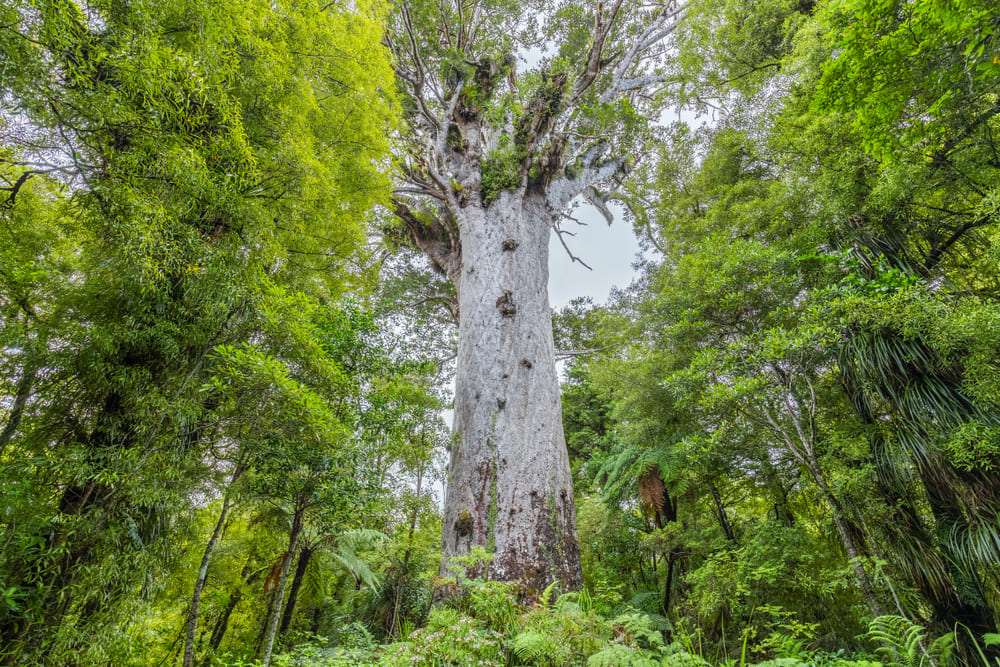
Kauri trees are a type of conifer that occurs in New Zealand. It is the most common tree species in the native forests of New Zealand. It has a unique relationship with the soil. The kauri can be found in sandy and clay soils and is adapted to a variety of climates.
Kauri trees are a conifer, which means that they have conical crowns and straight pole trunks. The mature kauri tree develops a massive column-like trunk. The trunk can grow from three to 23 feet in diameter.
The kauri tree feeds on decaying organic matter. This allows the kauri to alter the composition of the soil. The acidic molecules in the tree’s decaying leaves and bark release nutrients in the soil. Among the nutrients trapped are phosphorus and nitrogen.
The kauri is a tree that grows well in shade. It also has a root system that is shallow and fine. It is covered with fine root hairs that absorb water and nutrients.
Kauri trees are not the tallest trees. They reach between 100 and 160 feet in height. They can be used as landscaping trees in warm weather regions.
49. Monkey Puzzle Tree
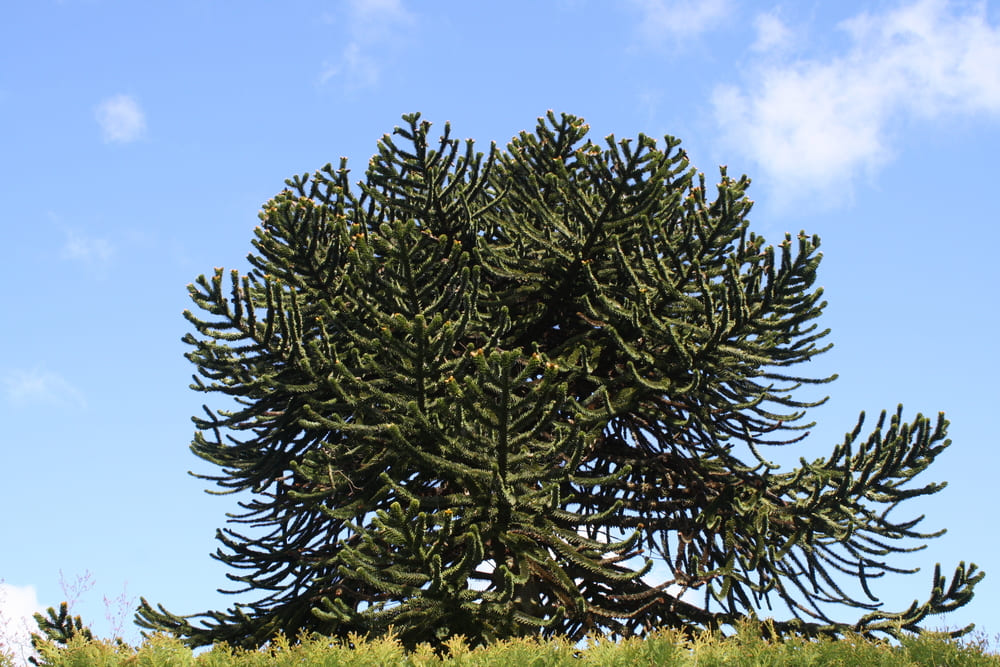
The Monkey Puzzle Tree, also known as the Araucaria araucana, is an evergreen conifer native to the Andes in southern South America. Its leaves are arranged in a spiral around the trunk. The leaves are thick and leathery with sharply pointed scales.
The Monkey Puzzle Tree is a member of the family Araucariaceae. This genus is known for its hardiness. This species can survive temperatures as low as minus 4 degrees Fahrenheit. The plant is also resistant to pests and diseases.
The plant can be propagated from seeds. The seeds are large, about the size of an almond. The seeds have an edible flavor and can be milled into flour.
These seeds are a staple food in parts of South America. They can be roasted and eaten as a snack. The seeds can also be fermented to create a drink.
The tree’s name comes from its challenge to climbing monkeys. The Monkey Puzzle Tree is considered endangered by the International Union for Conservation of Nature (IUCN) Red List. It has been listed as a natural monument in Chile.
50. Cypress Tree

Cypress trees are native to the United States, Canada, Mexico and South America. They are commonly used as landscaping trees in homes. The Cypress is classified as an evergreen tree.
There are many different types of Cypresses. Each species has different characteristics and growth habits. The Cypress can be used for any landscape as long as the planting site is appropriate. They are hardy in most areas, but require plenty of space and water for growth.
These trees are also known for their beauty. They are typically evergreen, with thick, feathery foliage. They are also a good choice for a shade tree in the backyard.
Cypresses are available in a variety of shapes, sizes, and colors. They can be grown in both wet and dry climates. They can reach up to 70 feet in height.
These trees are cultivated extensively throughout the world. They are categorized into two groups: the Old World or New World cypresses. The New World cypresses have fewer scales and are often more compact.
Bald cypresses are the type of cypress found in the wild. They grow in damp places, and have a pyramidal shape with a broad base. They also develop a “knee” – a long piece of root that grows above ground. This may help the tree get oxygen underwater.
51. Cedar Tree

Cedar trees are native to the Himalayas and can be found in several countries with mild climates. They can be planted for many reasons, including windbreaks, medicinal practices, and spiritual practice. These trees are also extremely hardy, and can live more than 300 years.
Cedar tree branches are short and thick. They are curved and round. They are covered with a thick layer of white wax, which prevents water loss.
Cedar trees are characterized by the distinctive spicy scent. They can be a beautiful addition to your landscape. They are able to tolerate all kinds of weather. They grow at a moderate rate each year. The trunk usually reaches 8 to 10 feet wide. They are easy to care for. You can plant these trees in partial shade or full sun.
Cedar trees need to have a rich and well-draining soil. They also require full sun and an evenly moist environment. They will not grow well in dry and acidic soil. If you are planting a cedar tree, you will need to add mulch to the base of the tree to protect it from moisture loss.
52. Bat Fig Tree
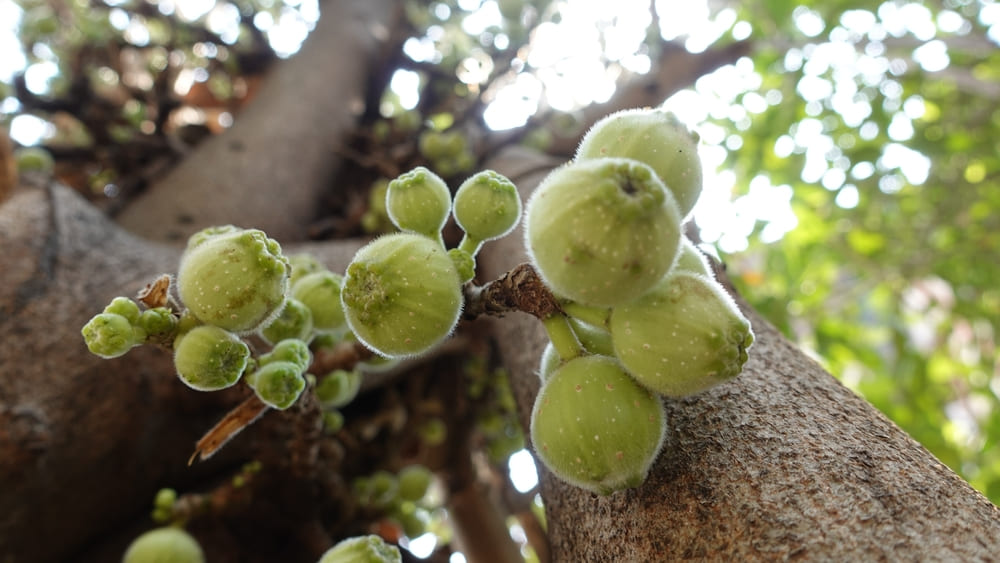
Bat fig trees are commonly grown as shade trees in coffee plantations or along avenues. They grow well in a variety of climates, ranging from tropical to subtropical, and will tolerate drought-like conditions. They can be planted at altitudes of up to 1000 meters above sea level. Ideally, the tree is planted in a location that receives moderate annual precipitation. The leaves on these plants are glossy and slender at the apex. They are between two and five inches long and have a blunt or acute tip.
These figs are attractive to birds and other animals, but it is not clear why they are dispersed by bats. The olfactory qualities of these fruits may play a role in their attraction.
Fruits of these figs are small, 0.8 mm in diameter. They become red when ripe. They are eaten by birds and other animals during the day and by bats at night.
In order to attract birds and other animals, the fruits of these figs produce strong odors. They also have a chemical called ficin, which turns the mâle fig body into proteins.
53. Coconut Palm Tree
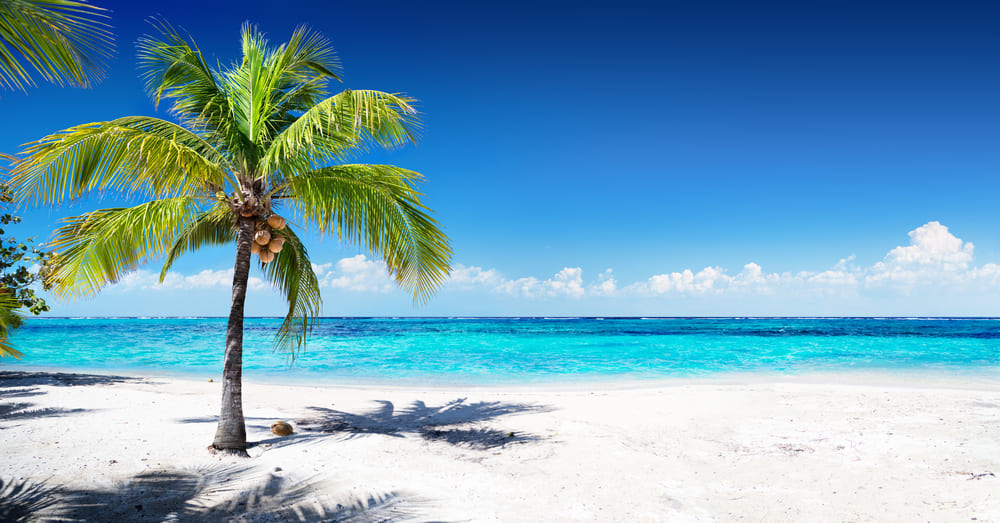
The Coconut Palm tree is a tropical plant that is known for its many benefits. It produces an assortment of valuable products including palm oil and husks.
These husks are used for making mats, brushes, and ropes. The meat of the ripe coconut can be eaten as an edible delicacy. It is also useful for cooking and beauty treatments. The coconut husk can be roasted to use as fuel.
The palm plant has a fibrous root system that extends into the ground. It can withstand short periods of flooding. The trunk can be thick, squat, or reedy. There are many different varieties of palms.
The coconut palm tree can grow up to 100 feet high. It is commonly planted for commercial purposes. It can also be grown indoors. This plant is able to tolerate both drought and heat.
The tree is a member of the Palmaceae family. It is known for its striking leaf color. It is also a popular food source for tropical cultures.
The Coconut Palm can be found in many places throughout the world. It grows well in coastal areas. It also has a wide range of soils and a temperature range that allows it to thrive in various locations.
54. Peppermint Tree
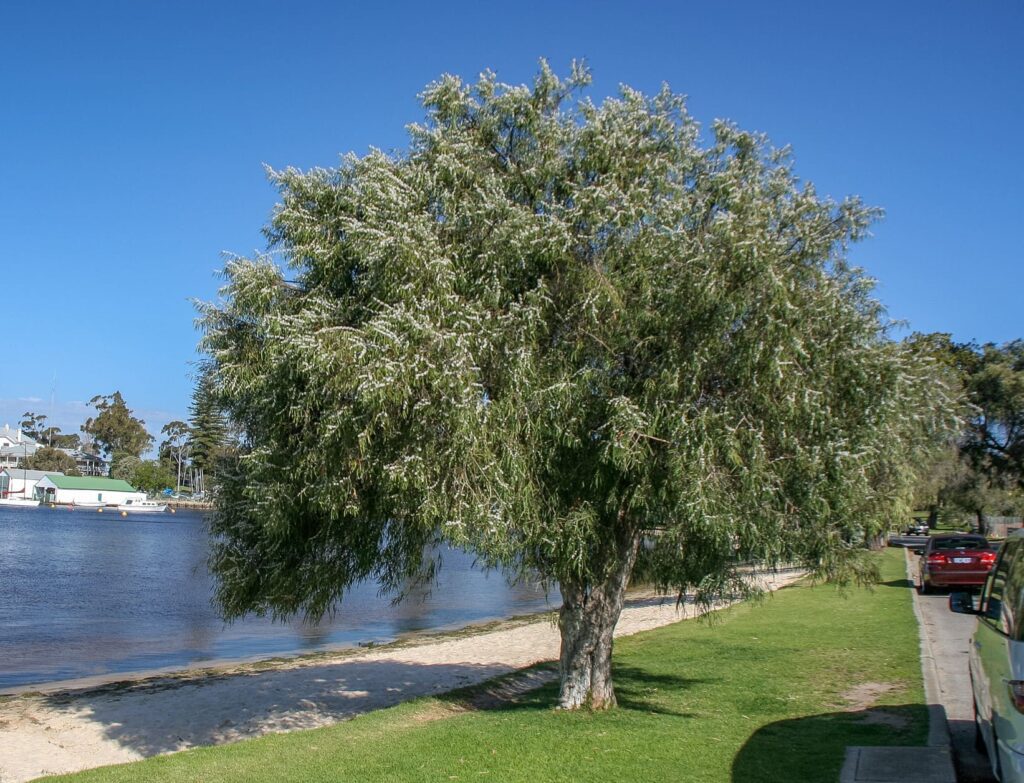
The Peppermint Tree, also known as the Willow Myrtle, is an evergreen tree native to Australia. Its dense foliage and pleasant peppermint aroma make it a favorite for landscaping. The Peppermint Tree grows to a height of between 25 and 35 feet. It can be used as a shade tree, or as a specimen plant in a lawn. It grows well in sandy soils and can tolerate heat and cold. It is also salt tolerant.
The Peppermint Tree has a weeping habit, with branches that are flexible and arching. Its bark is brown to gray, and is usually fibrous. As the tree matures, the bark flakes off.
The leaves are long and narrow. When crushed, the leaves release a peppermint fragrance. The leaves are also attractive to birds and other animals. They are also used by the Noongar people as spear shafts. The Peppermint Tree produces an excellent Christmas tree. The fruit has three valves, and is about 3 to 4 millimeters across. Its small seed capsules stay on the twig for several years.
55. Kumquat Tree
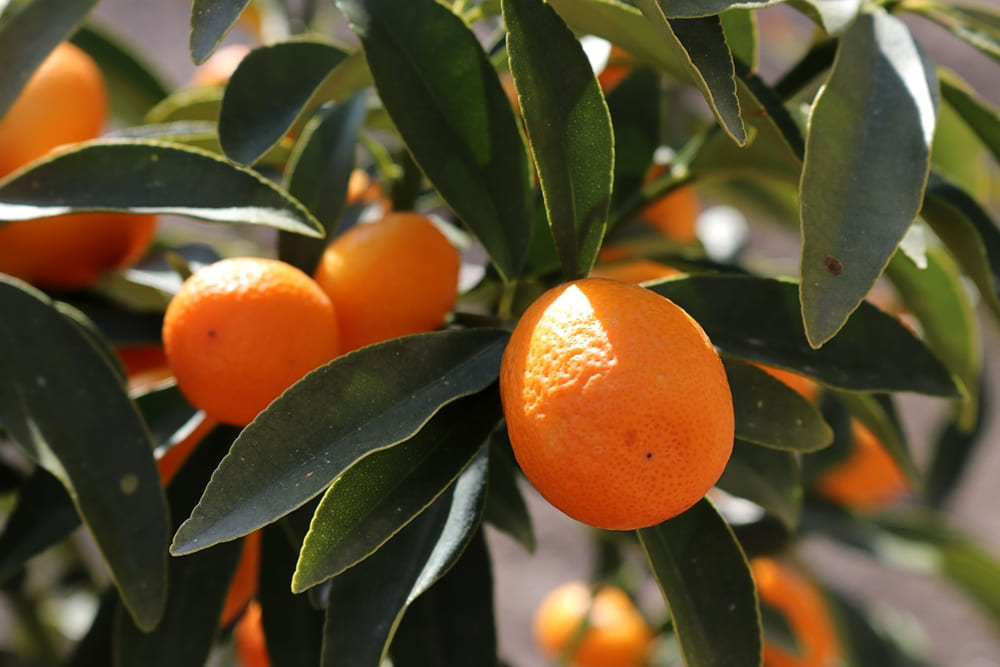
Kumquat trees are a type of citrus tree. They are grown both in the garden and indoors. There are four main species of Kumquat. These are ‘Marumi’, ‘Nagami’, ‘Meiwa’, and ‘Centennial Variegated’. These varieties differ in color, size, fruit, and flavor.
Kumquats can be grown indoors with the right amount of light and humidity. They need to be in a location with at least eight hours of sunlight every day. They also require consistent moist soil. Water them twice a week when they are young and less frequently as they mature.
You should fertilize your kumquats three times a year with a citrus fertilizer. This will help increase the overall health of the tree. They are very susceptible to disease. If the soil is overly soggy, they may develop Phytophthora root rot. To prevent this, use a fungicide that kills the disease.
Kumquats can be easily damaged by mealybugs and aphids. For aphids, you can apply horticultural oil. For mealybugs, you can apply diluted insecticidal soap.
Kumquats need protection from storms and frost. They are susceptible to root rot and scale insects. They can also be affected by drastic changes in light.
56. Olive Tree
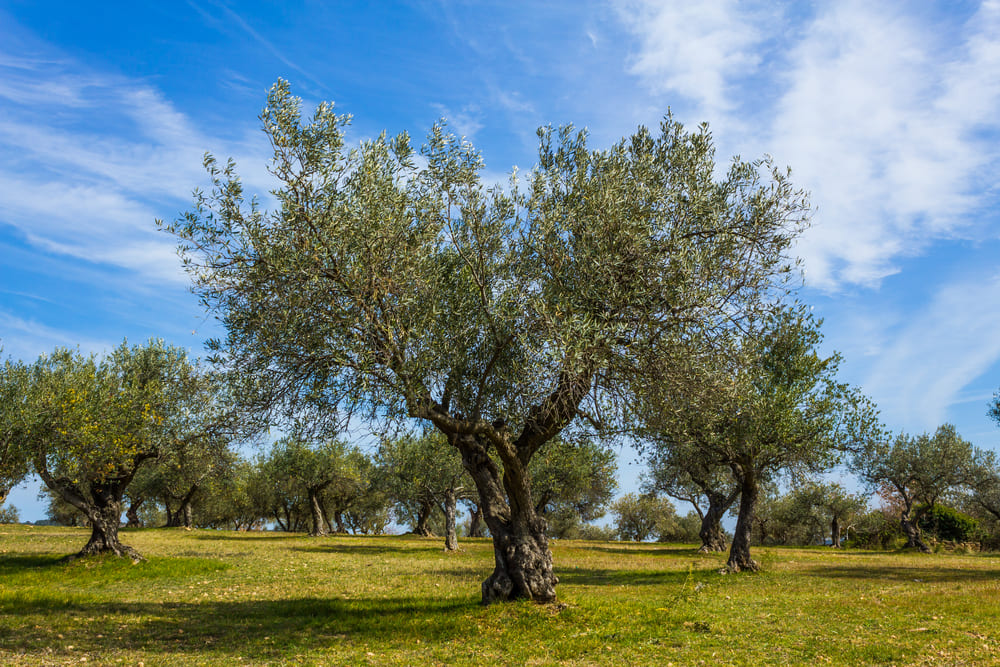
The olive tree is a plant native to the eastern Mediterranean region. It was cultivated by the Ancient Greeks.
The olive is known for its oil. It is commonly used for cooking and cosmetics. It is also useful for making furniture. In addition to being versatile, it is considered to be healthy.
An olive tree can live for many years. It can be planted in a variety of climates and soils. It is naturally pest resistant. It grows best in coastal areas.
The trunk of the olive tree can get quite large over time. It can be strengthened with judicious training and pruning. Its bark is tough.
The olive is a member of the Oleaceae family. The flowering olive tree is a symbol of abundance in the Bible. It is also an important symbol in the United Nations flag.
The olive tree is a drought-tolerant plant. It is a slow-growing tree that requires adequate water and sun. The leaves on the olive tree are dark green above and silvery on the underside.
57. Alder Tree
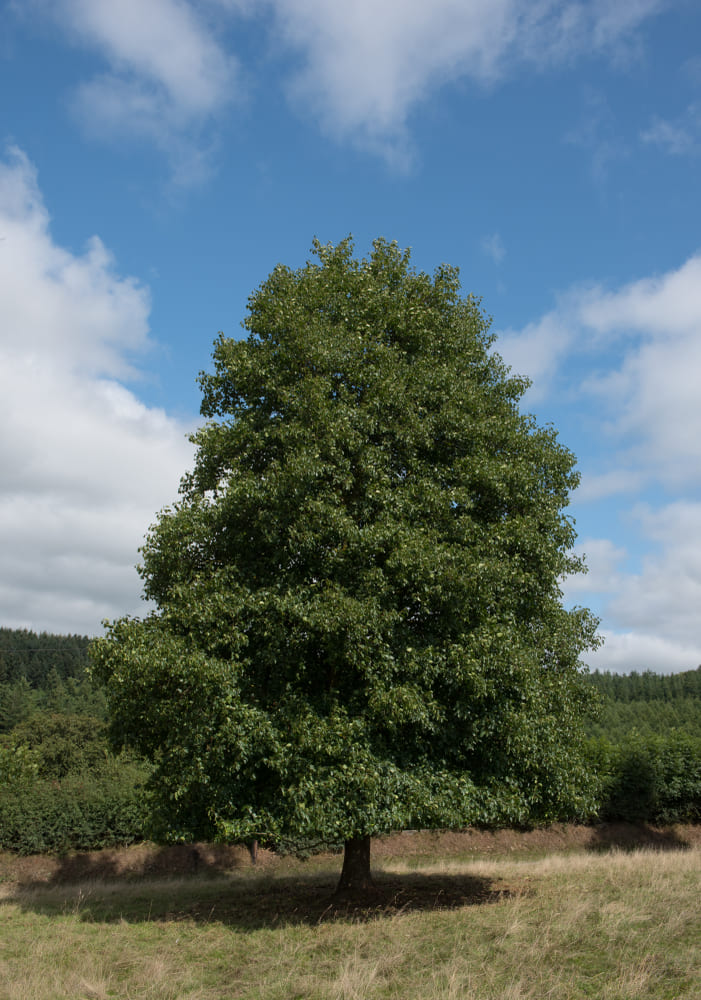
Alder is a genus of ornamental trees. It is found in North America, Europe, and Asia. It is a native plant to moist regions. Its wood is used in timber veneers and plywood. It is also used for smoking salmon. Its sap is an important source of dye.
Alders are monoecious, meaning they have male and female flowers. The female catkins are small, green, and stay on the plant until spring. They gradually develop into cones with seeds. The seeds are dispersed by the wind and water currents.
The alder is a good tree to grow in damp locations, such as stream banks. The root system of the alder is very efficient at retaining soil, which helps to stabilize riverbanks. It is also a good source of nitrogen for the soil.
The bark of the alder is grayish-brown and almost white in some species. It is a good anti-inflammatory agent. In ancient times, it was used as a remedy against tuberculosis. The wood of the alder is used to make timber veneers and plywood.
58. Arborvitae Tree
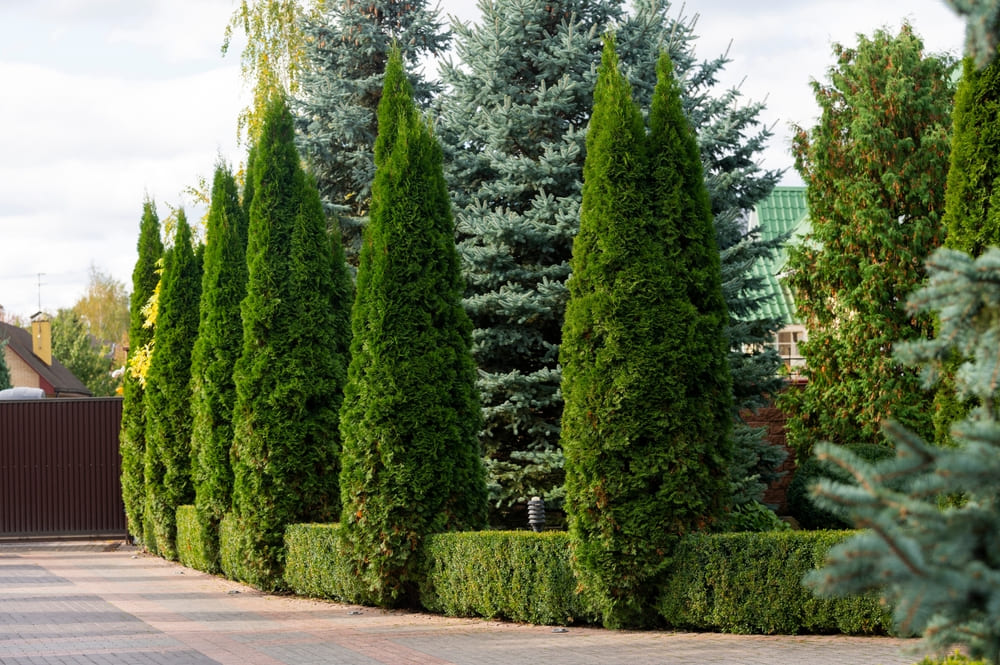
Arborvitae trees and shrubs are often used in landscaping because of their beautiful and fragrant foliage. They are hardy and easy to care for. They can be used as windbreaks and privacy fences. However, you should make sure you provide them with ample space to grow.
The best time to plant arborvitae trees is after the last frost. They require at least six hours of direct sunlight every day. They can also benefit from a slow-release fertilizer to promote new growth.
Most varieties of arborvitae are deer resistant. But keep in mind that overwatering can cause root rot. You can use a hose or drip irrigation system to deliver deep watering.
The oldest arborvitae is over 1,000 years old. These evergreens are prized for their infection fighting properties. In the past, parts of the tree were used to induce abortions.
Arborvitae shrubs are low-maintenance and come in a variety of colors. They are fragrant when bruised. Their foliage comes in light green, yellow, and gold. They can also be used as container plants.
59. Black Tupelo Tree

The Black Tupelo tree is a medium-sized deciduous tree. It grows best in wet soils, but it will grow in alkalos and dry soils. It is a good landscape tree. It can grow to a height of 30-50 feet at maturity. Its leaves are glossy dark green. It is known for its sweet and sour fruit and its attractive fall foliage. It produces small blue-back berries that are eaten by many birds, mammals and insects.
The Tupelo tree is dioecious, meaning it has male and female flowers on different trees. The females produce pollen and nectar. These nectar-rich flowers attract bees. The fruits are sour and edible by birds, mammals, and insects. The seeds are edible by woodpeckers.
Tupelo trees grow in upland depressions, along wooded slopes, and on dry sand flats. In areas with a high water table, they may be found in swamps and upland sand flats. They are often used in landscaping for their excellent autumn color.
The black gum tree is the most common species of tupelo. Its bark is deeply grooved, with irregular ridges. The twigs are reddish brown and slender. Its leaves are oval-elliptical, with downy margins. It is also very drought-tolerant, although it requires occasional irrigation in dry periods.
60. Buckeye Tree

Buckeye trees are part of the family Sapindaceae. They are native to the upper midwest of the United States. These trees thrive in a variety of conditions, and their foliage can survive both drought and snow.
Buckeye trees grow naturally in woodland settings. The trees also thrive in areas of partial shade. However, they require regular watering, especially in the first few years. They do not like to be in a very dry environment, as they are susceptible to nutrient deficiencies.
The tree can be found in many nurseries. The buckeyes are available in four main varieties. The red buckeye, yellow buckeye, California buckeye, and Ohio buckeye. These trees are all quite similar, but their differences are notable.
In the spring, buckeye trees produce upright clusters of small blossoms. The upper flowers of each cluster are staminate, meaning they do not produce seeds. Each cluster is made up of only two or three fertile flowers.
In the fall, buckeye trees’ leaves change to a bright orange or yellow. The fruits are leathery capsules. Each fruit contains one or more shiny brown buckeye seeds.
61. Catalpa Tree

Catalpa trees are beautiful trees with colorful foliage. These hardy trees can tolerate a variety of climates and are easy to grow. Whether you have a large yard or just want a little accent in your garden, catalpas are a good choice. They are also low maintenance.
Catalpa trees are useful as shade trees and can thrive in a variety of soils. However, they require a soil pH of 5.5 to 6. You can use a standard 10-10-10 fertilizer to promote healthy growth. They can also withstand drought.
These trees are native to North America. They can be grown from seed or rooted cuttings. You can also plant these trees in containers to protect them from weeds and other pests.
Northern Catalpa trees grow in USDA zones 4-8. This is because they are cold-hardier than southern varieties. This species is often used for utility wood. They are a reliable deciduous tree and can handle short periods of drought.
Catalpa seeds are readily available in the fall. You can either sow the seeds yourself or buy them in a packet. They should be planted in a pot with good drainage. They should be watered every two to three days during the first growing season.
62. Chinaberry Tree
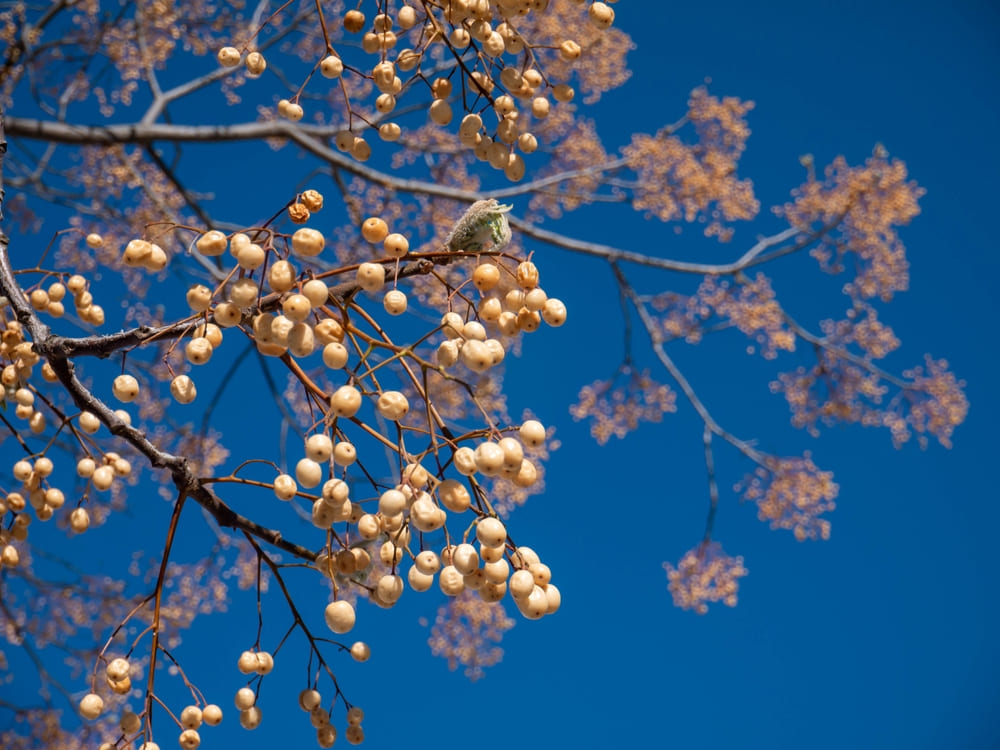
The Chinaberry tree is a fast-growing tree, ranging from 30 to 50 feet tall. It is native to Asia and the Himalayas. It has been introduced to the United States as an ornamental plant.
In some areas, the Chinaberry is a nuisance. It spreads quickly, and can choke out other plants. It also contains toxic substances. It can be poisonous to humans, pets, and livestock. It can cause vomiting, diarrhea, weakness, and loss of appetite. It is often associated with drunken birds.
Some herbal remedies claim that the bark of the Chinaberry tree can treat parasites in the intestines. It can also be used to treat uterine cramps. It has also been used as a cleaning agent.
It was originally used as fuelwood. Some people also use it to make jewelry. Old berries can be painted and threaded to make beads.
The Chinaberry is considered a pest, especially in parts of the southeastern United States. It can be planted in residential landscapes, but regular watering is necessary. Its rapid growth makes it difficult to uproot once it is established.
63. Chokecherry

A chokecherry is a type of tree that grows in a variety of climates. It is commonly found in mountain canyons and foothills. It is a woody, shrubby plant that can be trained into a tree. It grows in various soil types and is drought-resistant. It also provides cover for birds and butterflies.
This plant is native to the United States, but it is cultivated across the world. It is grown as a small tree or a large erect shrub.
It is a great choice for areas with poor or uneven soil. It also tolerates a wide range of conditions, from full sun to partial shade. It is also easy to grow.
Its wood is used for making bows and pipe stems. It has a bitter scent. It has been used to flavor cough syrups. Its fruit can be dried and eaten. It has been used in syrups and jams. Its fruits contain antioxidants.
The chokecherry is an important food source for birds and butterflies. Its fruit attracts deer and rodents. It is also used to make craft wine.
64. Conifer Tree
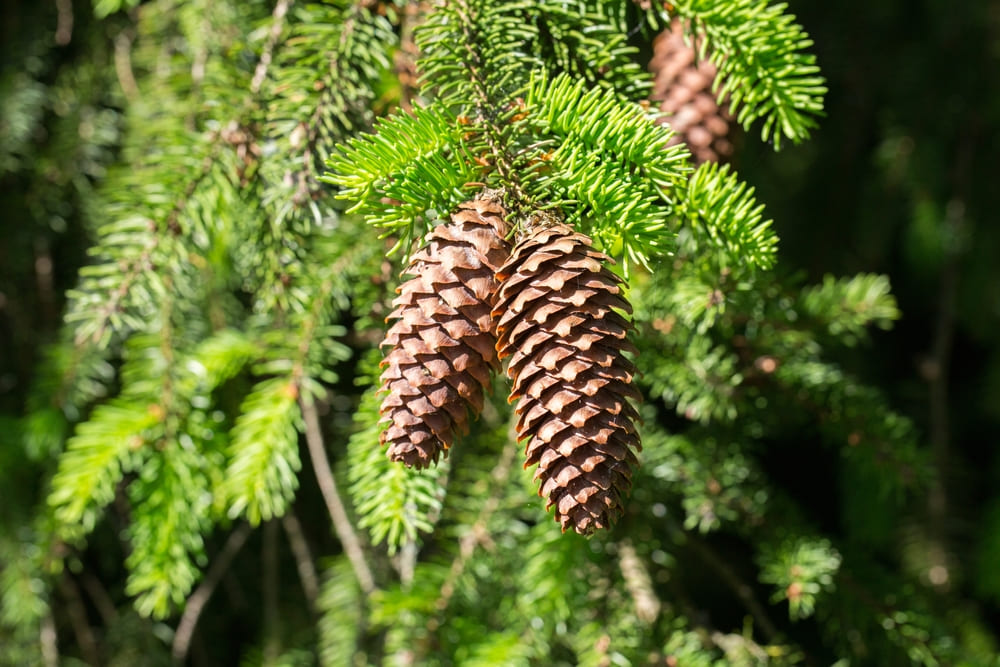
Conifers are a large group of trees, with over 220 species spanning a wide range of climatic conditions. Some of the most common conifer trees are pine, spruce, and fir, but there are many more.
Each conifer type is different in appearance, but a few characteristics are common to most. One of the most useful ways to identify a conifer is its needles. Most conifers have dense clusters of needles, which are typically 1 to 2 inches long. The size and shape of the needles can also help you identify the tree.
Conifers are the boreal lungs of the earth. They create a four-season tapestry of texture, color, and scent. They are commonly found in temperate and subarctic regions, but are widely distributed throughout the world. Some conifers are evergreen, but others are not. Some are used for food, while others are used as a hedge.
The largest conifer tree in the world is the giant sequoia in the Sierra Nevada mountains. These trees can grow to heights of 95 meters. They are often used for lumber and wood products. They require heavy rainfall and well-draining soil. They can also be grown in drier climates.
65. Crabapple Tree

If you are looking for a tree that is perfect for your garden, the crabapple is a great option. These trees are easy to grow and have lovely flowers. They are also resistant to common pests and diseases.
There are hundreds of varieties of crabapples to choose from. Many of these cultivars have unique shapes and blooms. You can even plant them as specimen trees. They are generally hardy in climates that fall below -15 degrees Fahrenheit.
They have a pleasant aroma, and they are also very popular in Asia. Their white, fragrant flowers attract hummingbirds. Their fruit is small, but they are a wonderful source of food for wildlife.
The crabapple’s leaves are a contrasting oval shape, with red veins. They become more vibrant in the fall. They remain on the tree into winter. They are resistant to scab and cedar-apple rust.
A crabapple’s fruit is round and bright yellow. It is also fairly resistant to apple blight and cedar-apple rust. It is tart, but delicious. They can be used to make a special crab apple jelly.
66. Crape Myrtle Tree

Crape Myrtles are small flowering trees that grow in many different sizes and varieties. These plants are very low maintenance and easy to care for. They prefer full sun or part shade. They are also well adapted to a variety of soils and conditions.
Crape Myrtles are great for planting under power lines. They are also excellent for growing in areas with poor soil. However, you must be careful when planting your Crape Myrtle. Make sure your soil is rich in organic matter.
Most Crape Myrtles prefer a site with ample sunlight. They do best in a spot with a minimum of six hours of direct sunlight per day. During the summer, your plant will need regular watering.
The flowering season for a Crape Myrtle will begin in late spring or early summer. The blooms will last up to 100 days. They come in various shades of pink and white. The flowers are borne in large clusters on the terminal panicles.
The seed pods of a Crape Myrtle are popular with birds. In fact, some Crape Myrtles can produce a dense crop of seed pods in the winter.
67. Eucalyptus Tree
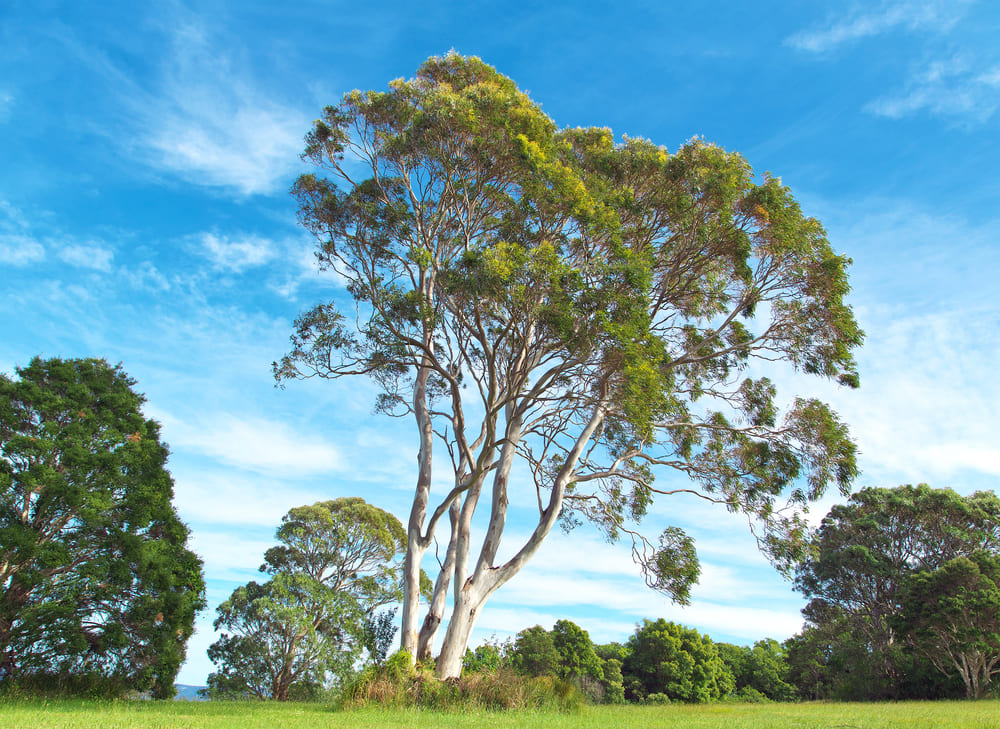
The Guide to Eucalyptus contains volumes of botanical descriptions and full-colour illustrations. It includes the history of eucalyptus, its uses, and the ecology of the trees. The eucalyptus tree is found in many countries.
Eucalyptus species have long been used for medicinal purposes. They have antimicrobial, antifungal, and antibacterial properties. They are used for topical and oral applications, and they are also often mixed with other essential oils.
Some eucalyptus species are invasive, meaning they are not native to the area. In fact, some people have been killed by falling under them. They are also used as firewood and timber. They are also an important cash crop in poor areas. They are also considered an ornamental plant.
The seeds of eucalyptus trees are easy to germinate and they produce fruit months after flowering. These seeds can be a source of food for mammals. They are also very prized for their peeling bark. They are able to grow in all types of climates and conditions.
The leaves of eucalyptus are often used for cleaning. They are also rich in eucalyptol, which is used as medicine. They are also used in soaps, deodorants, and insect repellents.
68. Ficus Tree
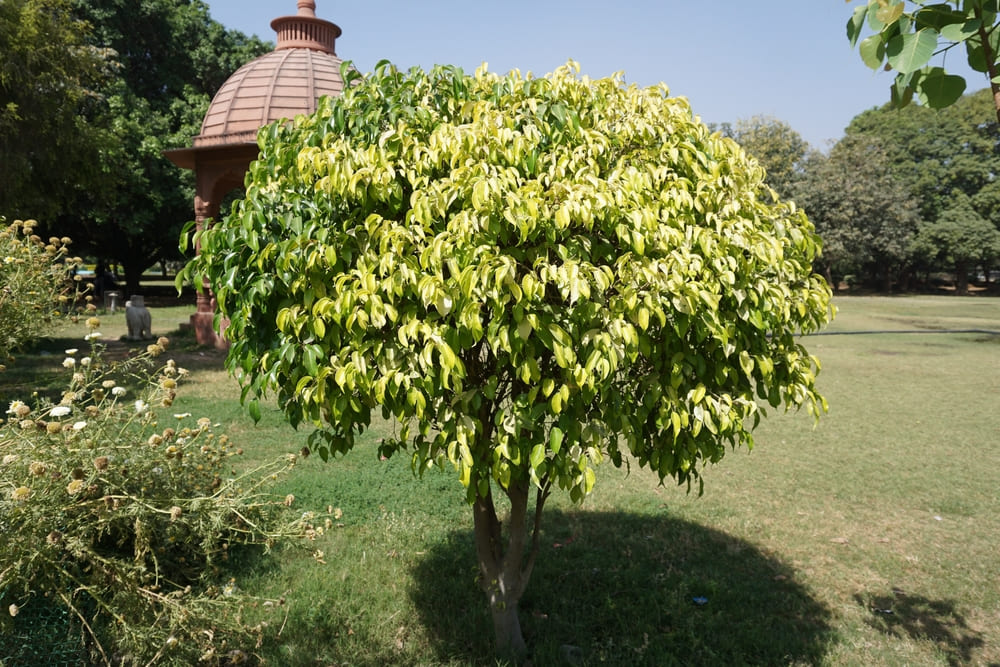
Whether you’re looking for a small specimen to add to your home or a full-scale tree for your landscape, it’s important to know the difference between ficus and other types of plants. While there are many kinds of ficus, you can generally divide them into six distinct categories. Depending on your needs, you may also need to know which species of ficus grow in which zones.
Depending on the type of fig you’re considering, you’ll need to provide a variety of conditions to help the plant thrive. In addition, you’ll need to pay special attention to the plant’s light and water requirements. You’ll also want to make sure the soil is well-drained and that you don’t place the ficus in direct sunlight.
When planting a ficus, you’ll need to keep in mind that it can grow quickly. You should avoid overwatering, and keep the ficus in a pot with drainage holes. The root system is very sensitive after repotting, so you’ll need to be careful.
You can plant a ficus in the ground as well as indoors. If you’re growing a plant indoors, you’ll need to keep it in a bright room. You’ll also need to give it a good source of indirect light, or keep it out of the sun during the day.
69. Ginkgo Biloba Tree
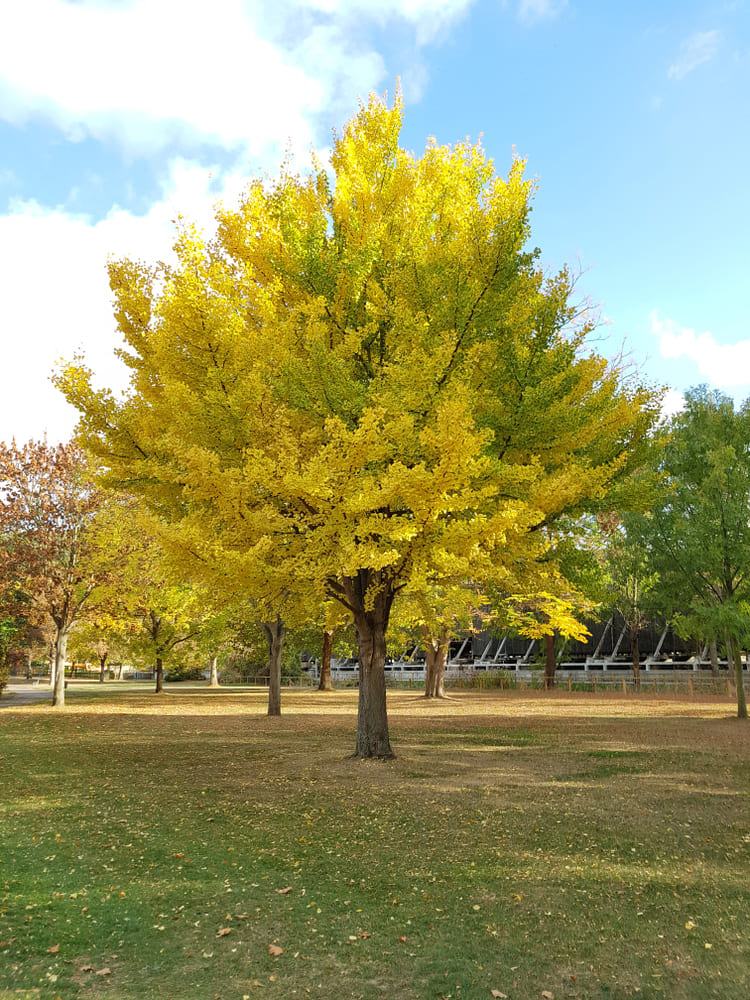
Ginkgo biloba is a type of tree native to China. These trees are deciduous, and have a characteristic leaf shape. They are fan-shaped, and have leaves that turn yellow in the fall. These are attractive and easy to care for. They are also tolerant of wind and air pollution.
There are several different varieties of ginkgo. Some are quite tall, but most start out a little narrow. This makes them suitable for growing in smaller spaces. Others can grow to be huge shade-providing specimens.
Ginkgo plants can be grown in a wide range of climates. They prefer well-drained, sandy soil. They can tolerate dryness and hot weather, as long as they have adequate moisture. They are resistant to disease and air pollution. They are able to survive in both urban and rural settings. They can also be planted in the front yard or on a sidewalk.
Ginkgos are a good addition to a garden. They are easy to care for, and are resistant to disease. They are very attractive, and can be used as accents or as focal points.
70. Hackberry Tree
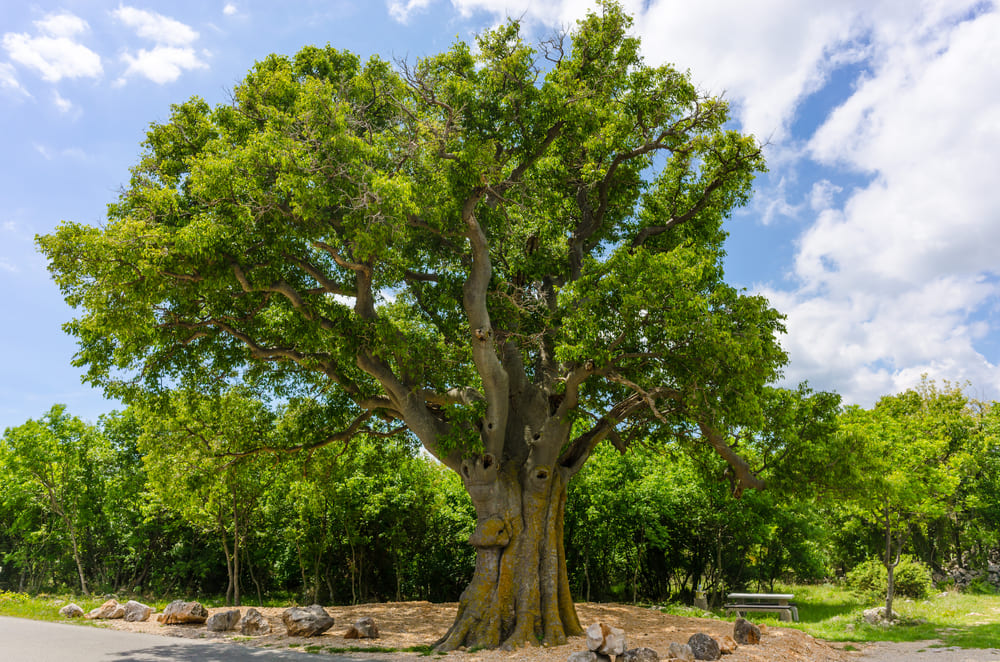
A tree that grows naturally in bottomland soils, hackberry is native to parts of Canada and the United States. It is related to the elm.
It is a tough, adaptable, and hardy tree. It has a rapid growth rate and can withstand pollution. It is a common tree that grows in fields and in river valleys. It is also a good shade tree that provides interest in the landscape.
The fruit of the hackberry is used by several bird species. They are about one-third of an inch in diameter and dark purple when ripe. In late autumn, birds pick them and eat them.
Hackberries are rich in carbohydrates, proteins, and fats. They can be eaten by people. They are high in vitamins. A mature hackberry is about 40 feet tall and wide. It has the potential to live for 150 to 200 years. It is a great addition to your garden.
The bark of the hackberry is a light to dark gray with warty projections. It is often seen in limestone outcrops. The tree can survive the harshest of conditions, including drought.
71. Hazel Tree
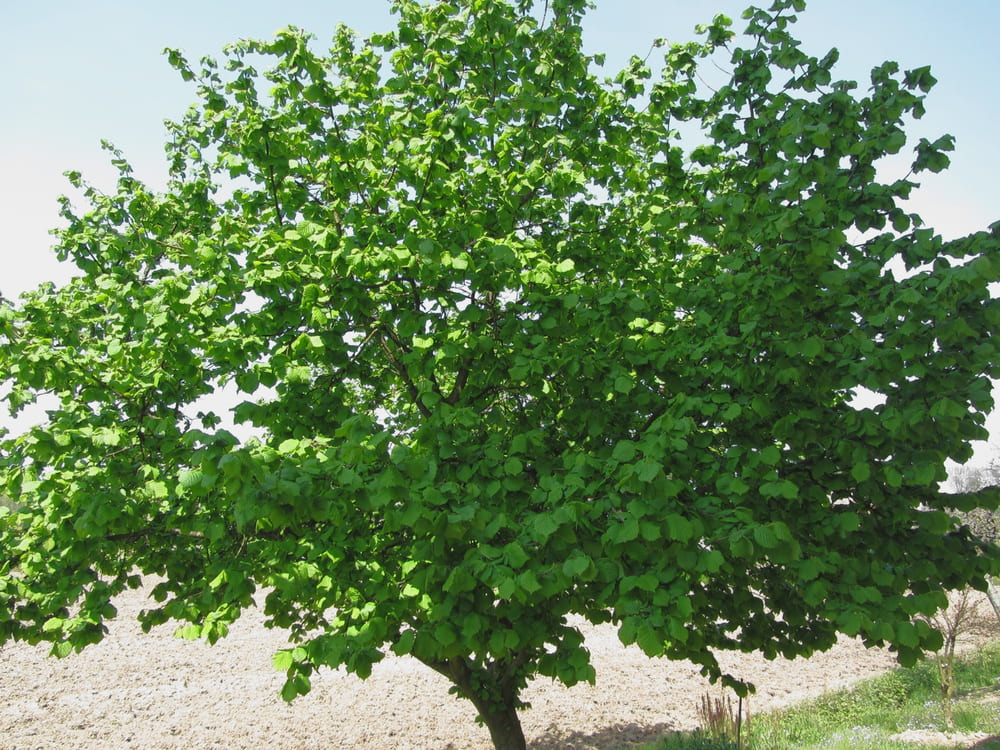
Hazel is a flowering shrub which grows well in a variety of climates. In the United States, hazel is commonly used as a landscape shrub. It is also an excellent source of folate. Its nut is also an important food source for birds and small mammals.
The tree is native to eastern North America. It is grown as a timber tree, or in combination with other trees to make a two-story forest. The nuts are highly nutritious and can be eaten raw, cooked, or even ground into flour.
They are an important food source for small mammals and birds, and are popular with people as a snack. They are also used for cooking and as an emollient in beauty products.
Hazel trees have an attractive canopy and are useful as a screening plant. They are particularly suited for cottage gardens. They also work as hedges.
The leaves are oval and serrated. They turn fiery red or yellow in the fall. They are very palatable to cattle. They also provide food for moths.
The nuts are a rich source of Vitamin E. They are edible and are often added to salads and breads. They can also be roasted.
72. Holly Tree

Holly types of trees can provide you with greenery all year round. Depending on which species you choose, they can be small shrubs or larger trees. Each tree has its own unique characteristics. They also have a variety of functions.
One of the most common holly types is the American holly. This broad-leaved evergreen can grow to 60 feet tall. It produces clusters of red berries in autumn. It also has a trunk diameter that can reach 47 inches.
Another holly type is the dahoon holly. This southeastern coast species can be found in swampy areas. Its leaves have an attractive glossy green color and spines along the top.
If you’re looking for an evergreen holly to add to your garden, you may want to consider the Japanese ‘Brass Buckle’ holly. This small shrub is evergreen and can be used as a hedge.
The longstalk holly is a great choice for urban areas. Its foliage is glossy and dark green. It’s an excellent addition to gardens during the fall months, adding color to the landscape.
73. Horse Chestnut Tree
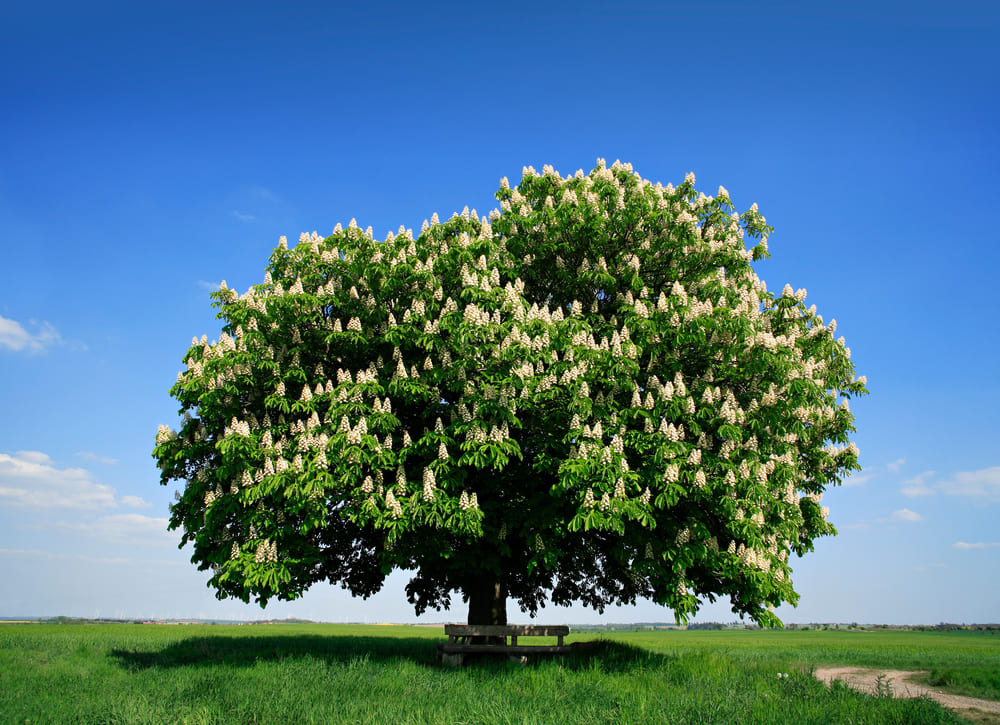
Horse Chestnut is a large deciduous tree with a broad spreading crown. It has twisted limbs and a distinctive bark. In addition to its interesting bark, this tree is an excellent shade tree.
If you’re looking for a shade tree that requires little maintenance, this might be the perfect option for you. It grows in a wide range of soils, from saline to slightly acidic. In the United States, it thrives in areas with USDA plant hardiness zones 3-8.
Its large leaves have five or seven leaflets. The leaflets are palmately compound and taper to a petiole-less base. The edges of the leaflets are obovate or serrated.
When the horse chestnut leaves are first growing, they are light green. In autumn, they turn yellow. The fruit of the horse chestnut is poisonous. Its seeds contain quercetin 3,4′-diglucoside, a flavonol glycoside.
The horse chestnut is an excellent tree for use in parks and landscaping. It’s a popular tree in many urban settings. It can grow up to 25 meters high and can be found in many European countries.
74. Jacaranda Tree

Jacarandas are tropical trees that are found in areas with high humidity and warm temperatures. They are also relatively easy to grow. If you live in a cooler climate, you can plant them in containers.
When you are ready to plant a jacaranda tree, it is important to select the right soil. A well-drained and neutral reaction soil is best. For example, a potting mix containing perlite and coarse grit is ideal.
After choosing a suitable location, you need to create a well-drained and sheltered area. You can add mulch around the base of the tree. This will help preserve moisture in the soil and protect against disease.
You can also propagate a jacaranda tree by planting seeds. However, you must wait a year before the seedling can flower. This is because a seed-grown tree will take years to develop.
During the first couple of months, you should water the seedling daily. This will encourage the tree to begin to establish a root system. The seedling should be planted in a pot that is half its own height and width.
75. Katsura Tree
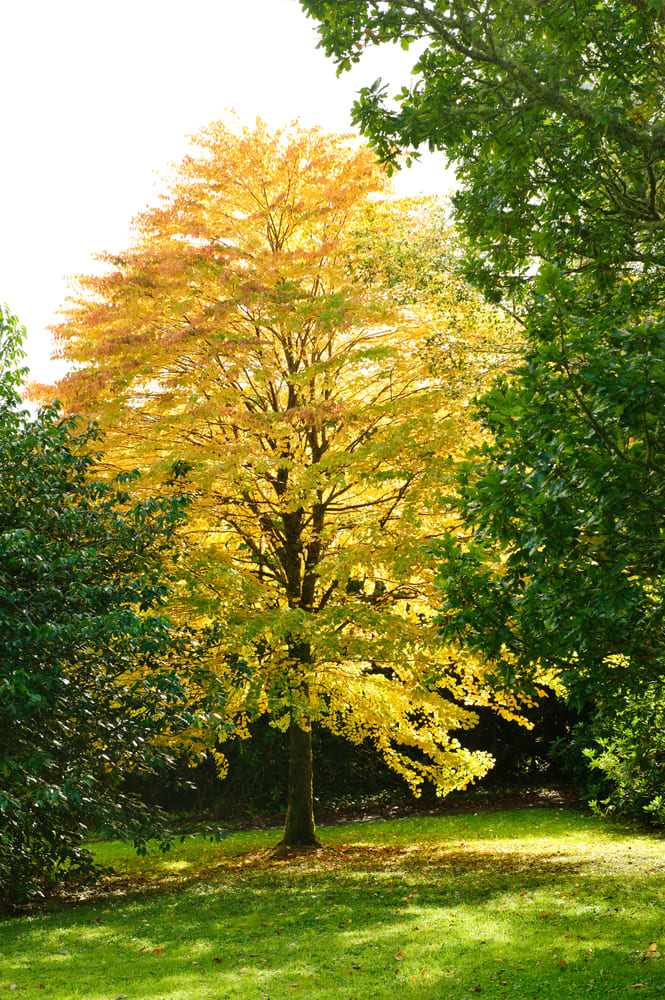
The Katsura tree, also known as the Japanese redbud or the Kerkis, is a medium-sized shrub or tree, a member of the Caryophyllaceae family. It is native to Japan and China, and grows in rich, moist soils. The leaves of the Katsura are heart-shaped, with delicate, rounded edges. They are slightly purple when they first emerge in spring, turning to a deep green, bluish green, and apricot in the fall. They also have a sweet fragrance.
Katsura trees are usually grown as ornamental plants. They thrive in rich, moist, and well-drained soil. However, they are not very tolerant of waterlogging or acidic soil. If they become waterlogged, the roots will rot.
The Katsura tree is a good choice for Midwestern landscapes because of its vibrant autumn color display. The tree is drought-tolerant when it is young, but will need more frequent watering when growing older.
Katsura trees are easily propagated. They grow from seeds and cuttings. To get started, collect the seed pods from fallen trees. For best results, place the seedpods in the refrigerator for eight days. Then, expose the seeds to light for fifteen hours a day for three weeks.
76. Kentucky Coffee Tree
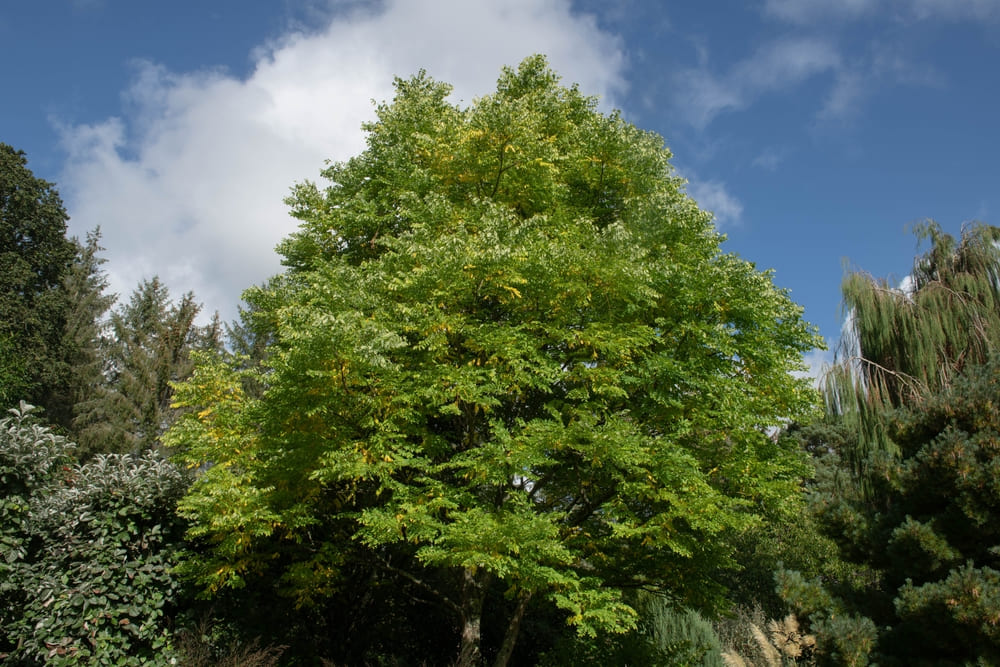
Kentucky Coffee Trees are a variety of trees that are classified as rare forest trees. They are in the legume family, Fabaceae. In addition to being an ornamental tree, Kentucky Coffee Trees are also used in the timber industry.
The Kentucky coffee tree has a wide range of uses, including as a shade tree and in parks. It is drought tolerant, and is considered a good addition to landscapes. The wood is relatively rot-resistant. It is also very easy to work, and can be used in general construction. It is best used in areas where its hardiness and versatility will be beneficial.
The Kentucky coffee tree is a very tall, majestic tree. Its branches can reach 25 m (82 feet) in height. This tall canopy makes it a great addition to a landscape.
The leaves of the Kentucky coffee tree are large and airy. They have 40 to 60 leaflets. The leaves are arranged alternately on the stem. They have a pink-bronze color in the spring and become yellow in the fall.
77. Laurel Tree

Laurel trees are evergreen shrubs. Their leaves are leathery and ovate. They have a slightly floral flavor. These plants are also used for medicinal purposes.
Bay laurel trees are easy to grow. They can be propagated from seeds or stem cuttings. They are also used as hedges. These plants are native to the Mediterranean region. They are a good choice for screening, especially in shady areas. They tolerate pruning well.
When growing indoors, place your bay laurel plant in an area that receives sun. Keep it away from drafts and heating ducts. You can also water it regularly. If the soil becomes dry, add a balanced fertilizer. Make sure to avoid overwatering, as it can cause root rot.
The bay laurel tree is a valuable decorative foliage. It can be a great container plant. It grows to a medium to large size. It also makes a good specimen tree. If you plan to use it as a landscape plant, the tree needs to be pruned, but it will grow back quickly.
78. Linden Tree

Linden trees are beautiful deciduous plants that are native to the southern part of the United States. They have been used in herbal medicine for hundreds of years and have become known for their sweet aroma and sedative properties. They are also popular for their soft timber and for intricate carving. They are an important source of honey for beekeepers, and can produce up to a thousand pounds of honey per year.
The American linden is a stately tree that features long, pendulous limbs and heart-shaped leaves. Its flowers are yellow and cream-colored, and the fruits are round. It is sometimes called basswood. It can live for up to 1000 years. It grows in a wide pH range, and is suitable for planting in shade.
The American linden’s flowers are arranged in clusters that hang down beneath leaf-like bracts. The flowers are borne in pairs, and they have many stamens.
The leaves are dark green and heart-shaped. They turn pale yellow in the fall. The bark of the linden is gray. It is durable, and is used for making mats and ropes. The inner bark is thick and fibrous.
79. Mesquite Tree

There are seven types of mesquite in Texas. They vary in size and shape, depending on the environment and growing conditions.
These hardwoods can grow to 30 feet and more. They can be grown in any soil. They have a dense root system. They are hard and can be used for firewood and cooking food.
The seeds are edible, as are the beans. They are used by cattle, especially during times when there is not enough grass. They are also used as a natural fertilizer. The husks are hard and travel through the digestive system of cattle without causing any damage.
These trees grow fast and provide excellent shade. Their thick, spiky bark can be bothered by mealybugs. They can also be bothered by several varieties of scale insects. The thorns can also hurt livestock.
Mesquite trees can be a nuisance to property owners in a number of states. However, a healthy tree can fend off most infestations. The roots of the mesquite can extend up to 200 feet. The trunk may grow as wide as 40 feet.
80. Mimosa Tree
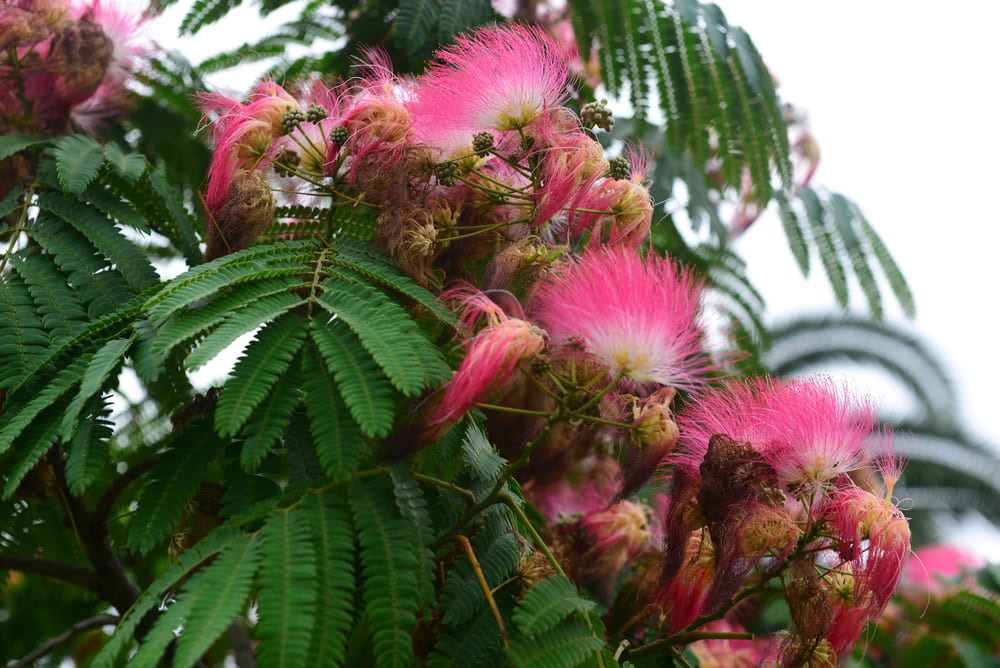
The Mimosa tree is a popular ornamental flowering tree, but it can also be an invasive nuisance in some areas. It can also be dangerous, as the seeds are poisonous.
The roots of this plant spread quickly. Its leaves can be a nuisance when they block roadways. It can also cause cracks in concrete. It has multiple trunks that droop as the tree grows.
Originally, this shrub was only used as a landscaping plant. It is now considered an invasive species.
When it is planted, the mimosa tree has a beautiful, tropical look. It can also be found growing in the wild in many parts of the world. It is a good source of firewood. It can grow to about 40 feet tall and is a drought-resistant plant.
Some varieties are short and others are tall. It can grow in a variety of soil conditions. The best type for your yard depends on your local climate.
The mimosa tree is hardy, but it can be difficult to remove. If you want to, you can use a power saw to pull the stump. You may need to use a herbicide to kill the remaining roots.
81. Mulberry Tree
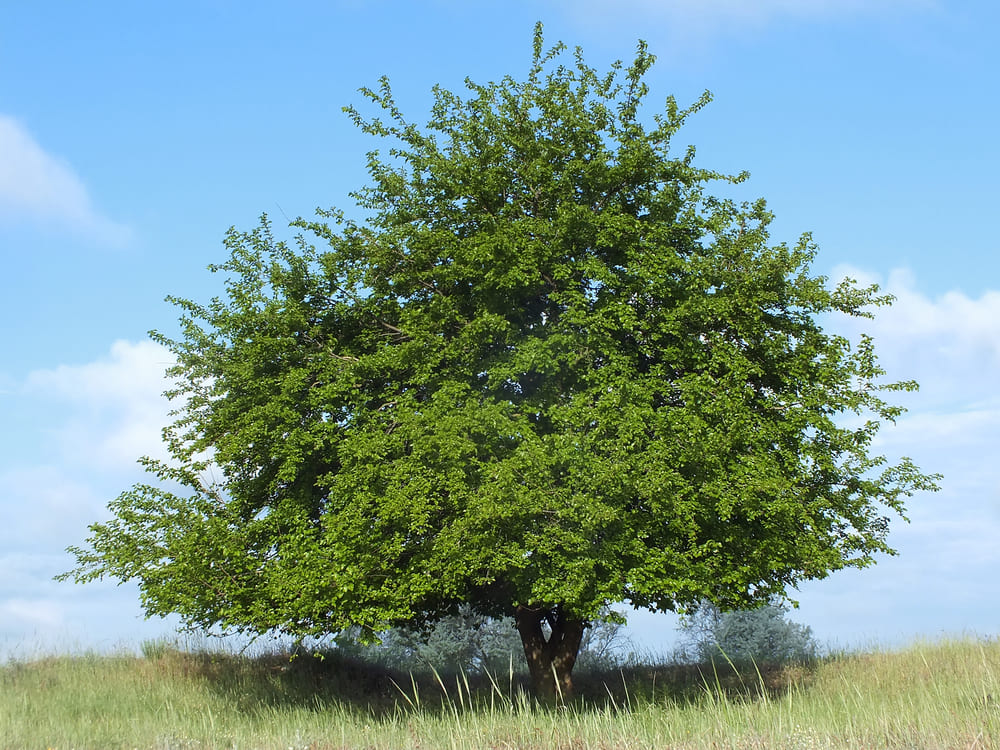
If you’ve ever been to a garden center, you’ve probably seen all kinds of Mulberry tree varieties. If you’re looking to start a new garden, or just want to know what Mulberries can offer you, you’ll need to know a little about these trees. In this guide, you’ll learn about the different types, as well as their care and maintenance.
There are many types of mulberry trees, but the main three you’ll likely encounter are White, Red, and Black. They all grow very quickly and can produce large clumps of tiny fruit. They are a great choice for landscaping or as part of an urban garden.
If you’re interested in growing Mulberries, you’ll find that they’re relatively easy to grow. Depending on your climate, you can choose from a variety of cultivars. However, if you’re in a warmer climate, you’ll be more prone to pest problems than if you live in a cooler region.
When you’re planning to grow Mulberries, it’s important to remember that you’ll need to provide adequate moisture. If you don’t, you may find that your tree will suffer from root disease. It’s also worth considering the potential for fungal leaf spot diseases. You’ll also need to keep an eye out for bacterial blights, which can affect the leaves of the tree.
82. Orchid Tree
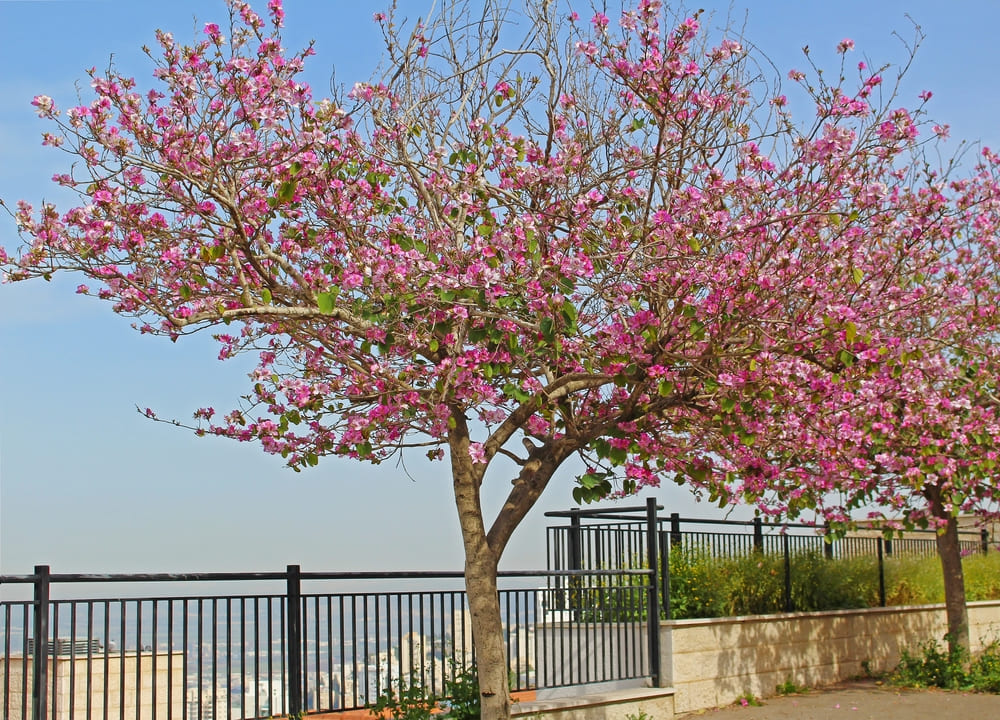
If you’re interested in growing orchids, you may be wondering about the various types of orchid trees that you can purchase and grow. Orchids are a type of flowering plant that originated from China, India, and Mexico. They are now widely grown as landscape ornamentals.
Besides being aesthetically appealing, orchids are also useful. They are used in medicine, rope, and coffee. However, they are endangered because of habitat loss. Orchids can only thrive in humid conditions.
Orchids grow in zones nine to eleven. This is where they can be most easily maintained. In order to successfully grow and care for an orchid tree, it’s important to understand its needs.
When deciding on a location for your orchid, consider whether it can get adequate sun, shade, and water. For optimal results, you should plant your plant at least eight feet from the house. It’s also helpful to keep it at least eight feet away from a walkway.
You’ll also need to staking the young orchid tree in order to prevent its brittle stems from breaking. When staking a young plant, you’ll need to use a strong non-metal material. A plant-based twine works well. It has a high tensile strength, and it will biodegrade after the plant is attached.
83. Ornamental Flowering Pear Tree
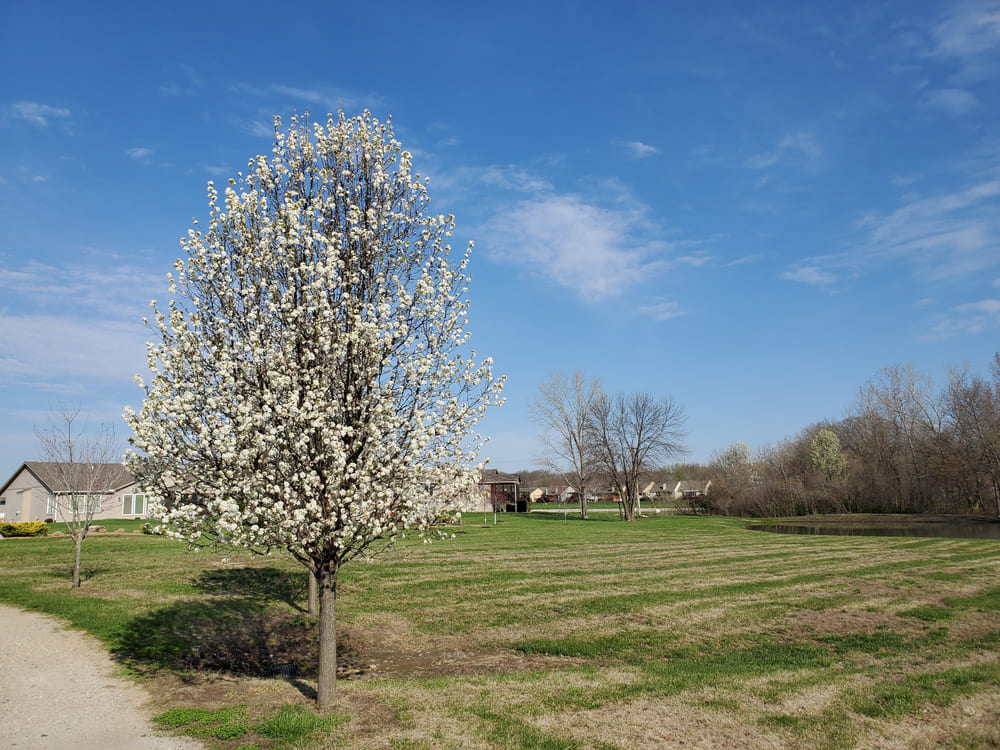
Ornamental Flowering Pear Trees are popular choices for gardeners, and they are a great choice for small gardens. They are tolerant of a wide range of soils, and they are hardy enough to grow in even dry or hot areas. They are also resistant to most pests and diseases.
They are moderate to fast-growing trees, and they grow well in full sun. They are attractive, and they add to the aesthetic value of a garden. They are also great screening trees. Their leaves turn a brilliant red in autumn. They are also very hardy, and they don’t require much care.
They are known to attract wildlife. They are also an excellent choice for firescaping. They are particularly useful on clay soils. They are also very resistant to fire blight. They are highly tolerant of urban pollution, and they are especially good for lining avenues.
They are relatively low-maintenance, so you can enjoy your flowering pear without worrying about weeding, pruning, or mulching. They are a fast-growing tree, so you can get them to a mature size in a few years.
84. Palo Verde Tree
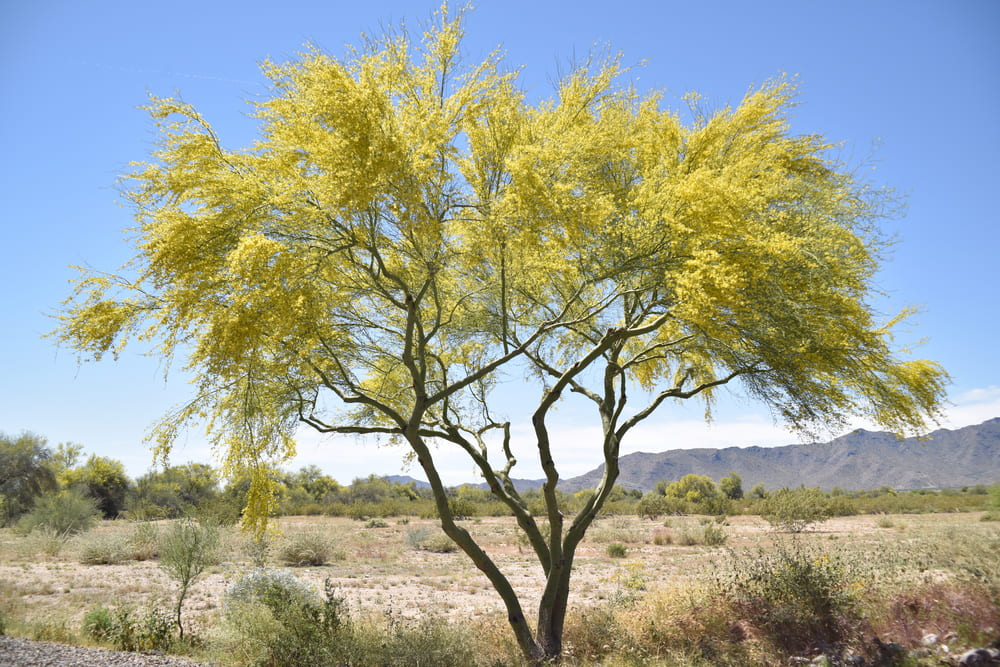
Palo Verde trees are a great addition to your landscape. They provide you with a beautiful, native tree that’s hardy enough to survive in even the harshest of climates. However, they also require some maintenance in order to stay healthy.
If you’re considering planting Palo Verde trees, you’ll need a little help. This guide will guide you through the process.
When planting palo verde, you should plant it in a sunny location. It’s a drought tolerant plant, but still needs water. You may be able to cut down on the amount of water you need to give it by establishing a watering system.
To properly prune your Palo Verde, you’ll need a pruning saw and shears. Make sure to trim out any weak branches. If you can, don’t prune any branches that cross or rub against each other. This will keep the tree from getting damaged, and can result in a better overall shape.
Alternatively, you can hire a professional to do the work for you. This will save you both time and money. A skilled arborist can help you establish a system that will keep your palo verde trees healthy.
85. Plumeria Tree

Plumeria is a small tree that can be planted in home gardens and landscapes. However, there are many things to know before planting and caring for this plant.
Plumeria is a member of the Dogbane family. It can thrive in a sunny location and can be grown in containers indoors or outdoors.
When growing plumerias, make sure that they get at least six hours of sunlight per day. They also need a slightly acidic soil. The best type of pot for this plant is one that is made of black plastic or terracotta. This allows the plant to retain moisture and keep the roots from drying out.
During the winter months, plumerias will go dormant. This means that they are not in need of additional water. They can even be overwintered indoors.
You can propagate plumerias by taking cuttings from healthy branches. However, you need to make sure that you are not allowing the cut to dry out too quickly. This can be accomplished by making the proper preparations, such as adding rooting hormone and dipping the cut in water. The cut should then be allowed to cure for a few days.
86. Poplar Tree

Poplar trees are native to North America and Europe. They can be found in a variety of places and can grow to heights of 50 to 160 feet. A great thing about these trees is that they’re hardy and grow well in all kinds of climates. You’ll need to plant them in areas that get plenty of sunlight. You also need to be sure to keep them out of sewer lines, paved surfaces, and away from buildings.
When you choose a poplar tree, you’ll need to consider the size and shade requirements of your landscape. Some varieties are better for shady environments, while others are more suited to full sun. In general, you want to make sure that your poplar isn’t planted too close to a building or sewer line, as the roots can damage nearby structures. Watering frequently is also recommended to keep the roots from enlarging.
The leaves of a poplar are usually lobed or spade-shaped. Their color ranges from green to yellow, and they glow gold in autumn. Some poplars are also able to survive drought conditions.
87. Purple Leaf Plum Tree
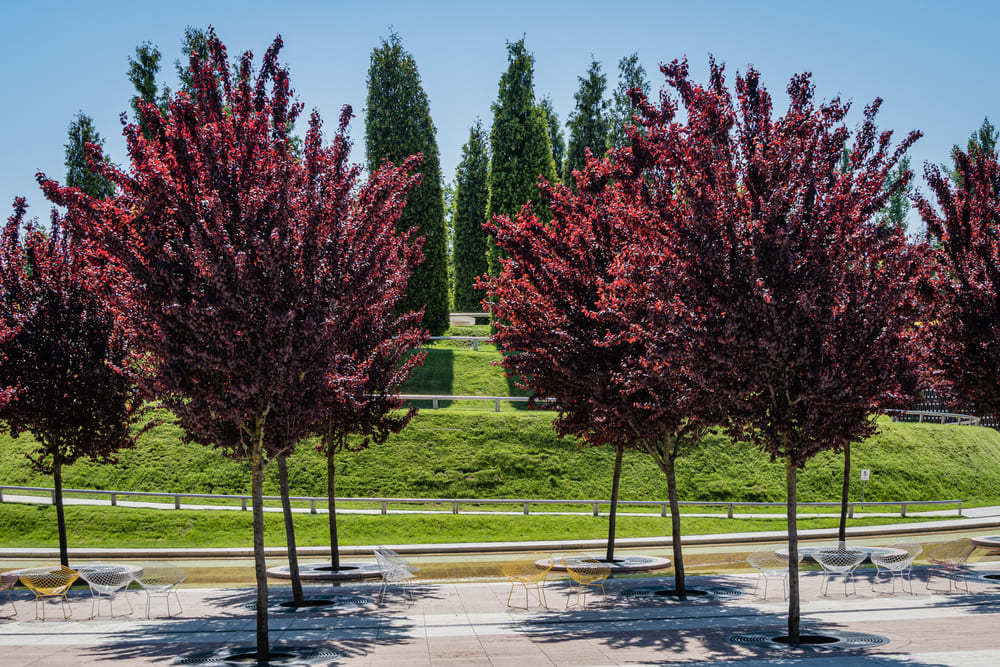
Purple Leaf Plum trees are ornamental and are low maintenance. This tree is ideal for landscaping because it is hardy, drought-tolerant, and can thrive in a variety of climates.
It is very popular as a specimen tree because of its bold color and strong branches. A Purple Leaf Plum tree can grow to twenty feet. It is also a good candidate for potted plants.
When growing the Purple Leaf Plum, it is important to plant the tree in a sunny spot that has plenty of moisture. This will help it to develop strong roots. It is a good idea to water the tree regularly. This will help it to grow and will improve its health.
In early spring, the leaves of the Purple Leaf Plum will start to unfurl. When they are fully unfurled, the foliage will turn a pale green. In fall, the leaves will drop.
The Purple Leaf Plum is a small, shrub-like tree that can be easily grown in a variety of soil conditions. It prefers a slightly acidic to neutral soil, but it will tolerate a wide range of other conditions.
88. Redbud Tree

Redbud trees are a group of small deciduous trees. They are often grown for their attractive foliage. Generally, redbuds require little maintenance. They are commonly planted in parks and other landscape settings.
These colorful trees offer a bright, attractive bloom display from spring to mid-summer. They are a favorite among butterflies, bees, and hummingbirds. Several varieties are available.
Redbud trees can reach a height of about 25 feet. They prefer well-drained, moist soil and full sun. They are also fairly drought-tolerant. They make good accent trees in small landscapes.
Redbuds are usually the first tree to bloom in the spring. The flowers are in a pea-like cluster, with five petals. They are high in antioxidants and are edible. They are commonly used by Native Americans to cook meats. The seeds, which are oval in shape, contain three to ten seeds.
Redbuds are a good choice for those who want a low-maintenance, disease-resistant tree. However, they are slow-growing.
If you are unsure of how to prune, don’t worry. The leaves are heart-shaped and turn yellow in the fall.
89. Sourwood Tree
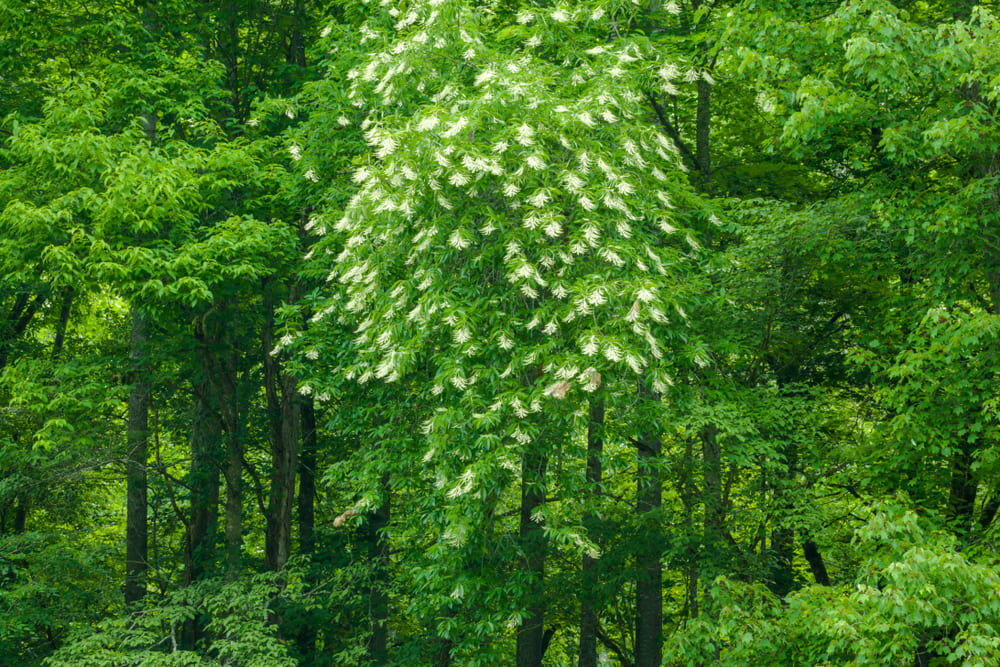
Sourwood is a tree that is often found along roads and forest edges. It is often found growing in an understory, but it also grows well in moist habitats. It is a native of the Appalachian Mountains and Gulf Coastal Plain. It is sometimes used as an ornamental tree, but it is not a very useful timber species.
Sourwood can be found throughout the southern Appalachian Mountains, southern Indiana, central Florida, northern Florida, southeastern Louisiana, southeastern Pennsylvania, and southern Virginia. It is a member of the heath family.
Sourwood is an understory tree that grows in areas of moderate drought. It can tolerate a little bit of shade, but it’s not a good candidate for planting in a city setting. The best place to plant a sourwood is in an open, slightly acidic, soil. It is a slow-growing tree, but it is quite hardy.
Sourwoods are usually quite small. During the summer, they have bright, rich green leaves, and in the fall, they have a deep red color. Their flowers are white and bell-shaped. In the winter, they produce ornamental seed pods.
90. Sumac Tree
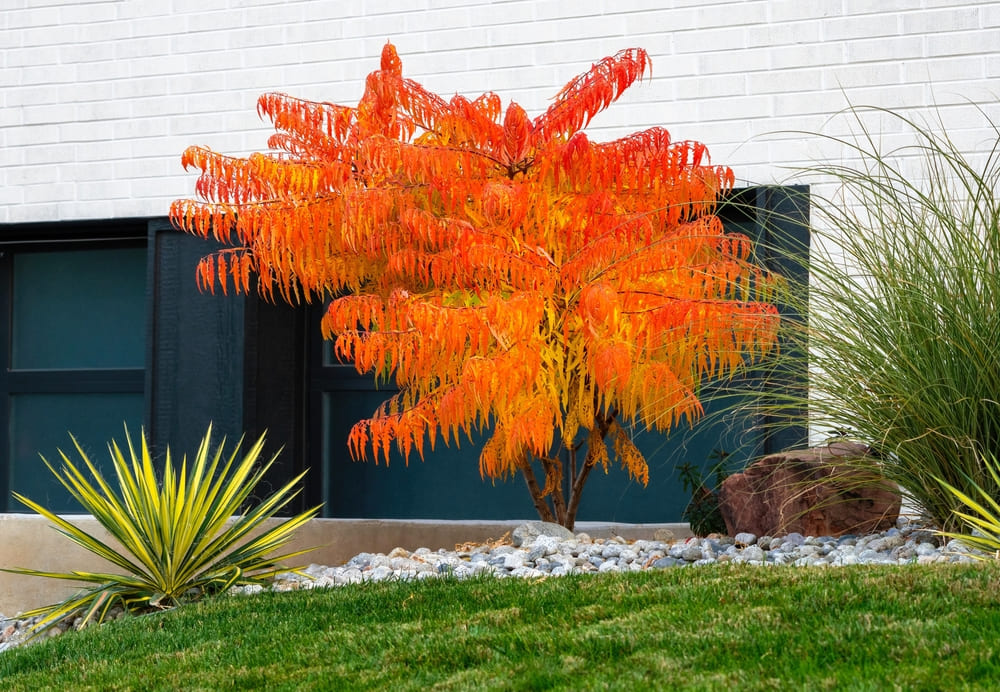
There are several types of sumac trees. Each one has its own special characteristics. Some are low-growing while others produce beautiful fall foliage colors. It’s important to know the specific characteristics of each type before making a plant selection.
The smooth sumac is a low-maintenance landscaping plant. It is well-adapted to full or part sun, as long as it has good drainage. It thrives in acidic, alkaline or sandy soils. It is also hardy in USDA zones 3 to 9.
The elm-leaved sumac is another excellent landscaping choice. Its bright red foliage is attractive in the fall. In addition to its lovely fall color, this variety is useful for massing in parking lot islands. It is also a good windbreak. It is not very invasive and grows to a maximum height of 15 feet. It’s easy to grow.
Rhus glabra ‘Laciniata’ is an extremely versatile plant. It is a sumac cultivar that is very slow-growing but produces a beautiful bright red fall. It is not very invasive, but it may need protection from the hot afternoon sun.
91. Sweetgum Tree

Sweetgum is a native tree of North America. It grows in the Midwest, southern Indiana, Missouri, Arkansas, and eastern Texas. It is known for its attractive foliage, astringent qualities, and medicinal potential. The sap from sweetgum has been used by the Cherokee Native Americans for wound healing.
Sweetgum is an ornamental shade tree. It produces attractive fall foliage. It has bright green foliage during the summer and changes to a variety of bright colors in the fall. It has a pyramidal shape and is usually 60 to 80 feet tall. It is resistant to insect attack. It is also cold-hardy. It is best planted on sidewalks or near sidewalks.
Sweetgum is a very fast-growing tree. It is a monoecious tree, meaning that it has staminate and pistillate flowers in the same plant. The female flower develops a spherical ball called a “gumball,” which is usually 1.5 inches in diameter.
American sweetgum is a good choice for reforestation projects and for reclaiming former mines. It is also a good species for veneer.
The bark of sweetgum is rough and gray-brown. Young trees have smoother bark, while older trees have more fissures.
92. Sycamore Tree

The sycamore tree is a large deciduous tree. It grows to be over 100 feet tall, with a canopy that is oval in shape. The tree is a popular choice for landscapes. However, its roots can cause damage if they are planted too close to a sidewalk or driveway.
The sycamore tree grows well in moist soil, and prefers full sun. It is also drought-tolerant once it is established. It is best to plant the tree near a pond, stream, or other water source. It is also important to fertilize it every spring to help it absorb nutrients.
The tree produces clusters of small flowers. These flowers are monoecious, meaning both male and female flowers grow on the same tree. The females are yellow and are the ones that produce fuzzy fruits. The males are red. The sycamore tree can live for hundreds of years.
The sycamore is one of the most common types of ornamental hardwood trees in the United States. It is a valuable resource for wildlife, as it provides shelter and food.
93. Tabebuia Tree

The tabebuia tree, also known as the trumpet tree, is a plant belonging to the family Bignoniaceae. It is native to South America and Mexico. It is a fast-growing, drought-resistant, and pest-resistant plant that can be easily propagated from hardwood cuttings.
There are over 100 species of tabebuia trees. Each species is unique, so you may have trouble identifying the type of tabebuia you have in your garden. Here is a quick guide on the different varieties of tabebuia trees.
The tabebuia heterophylla tree, also called the pink trumpet tree, is an excellent choice for a shade tree. It has smooth oval leaves and showy pink tubular flowers. The seed pods are 3 to 12 inches long, and contain numerous winged seeds. It grows to be 20 to 30 feet tall.
The golden trumpet tree, also known as the sapphire or golden trumpet tree, is a small tree that grows to about 25 to 40 feet high. The leaves are dark green. It is widely distributed in the West Indies. It has been planted for ornamentation, as well as for boat building.
94. Teak Tree
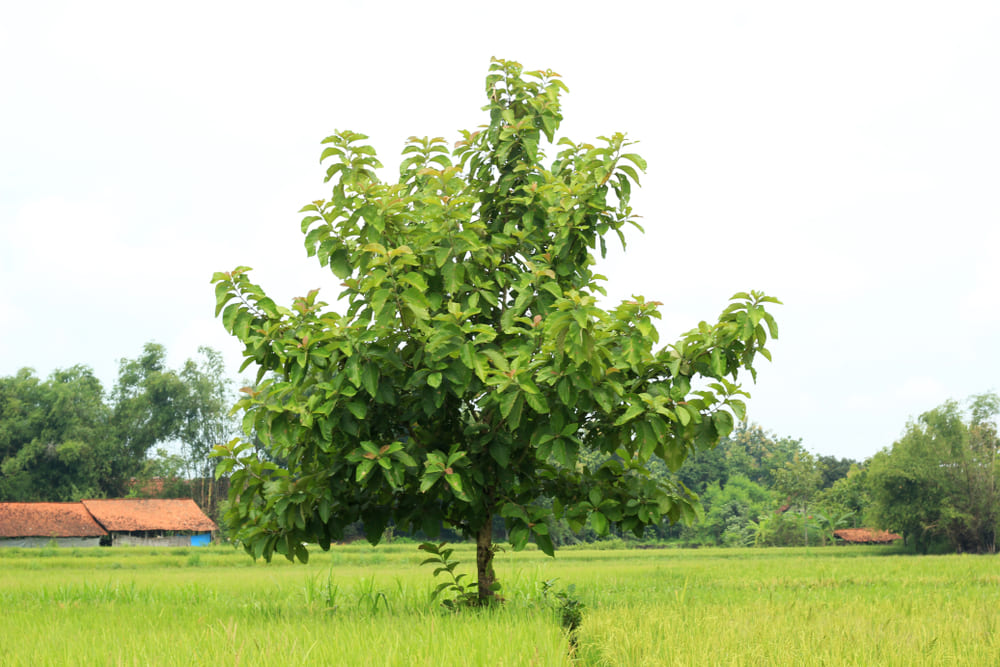
Teak, an essential timber tree, is grown in many regions. Generally, it grows in a range of climate conditions, with warm and humid conditions being its best. However, it grows poorly in waterlogged soils and acidic soils derived from laterite.
It is important to note that, although it is an endemic species, teak is now planted in many regions, including Asia, Africa, Latin America, and South America. It is also native to Myanmar, Indonesia, and Thailand.
Teak is mainly used for exterior construction, boat building, and yachting. It is highly resistant to termites and fungi, and is also known for its attractive color and ease of carving. In addition, it has a high oil content. It is used for flooring, door frames, and window frames.
Plantation management for teak has been a problem, primarily due to problems in maintenance and productivity. Several strategies have been proposed for long-term improvement. These include management of the breeding populations and the establishment of long-term seed orchards.
Traditionally, teak has been harvested for its seed. This process involves cutting side branches off the main trunks of trees. The harvesting operation must be approved by the local forestry department. The amount of seed produced is typically below demand.
95. Vitex Tree
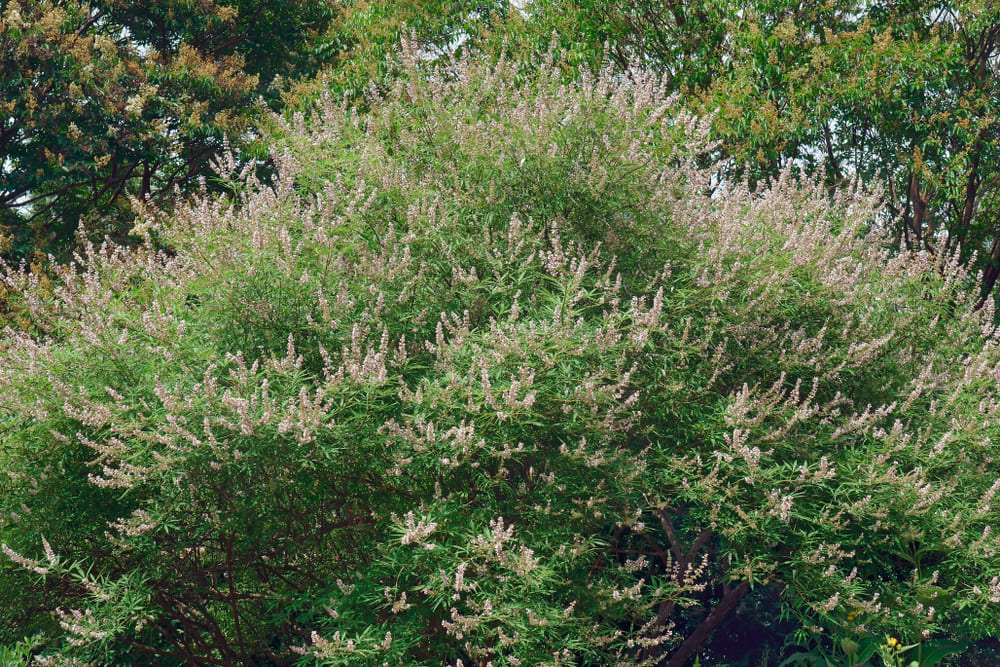
If you want to add a touch of color to your landscape, try planting vitex trees. This beautiful plant can grow to more than 20 feet tall, depending on its species. It grows rapidly and blooms year after year. It’s a great way to attract birds, hummingbirds, and butterflies to your garden.
Although Vitex is native to subtropics, you can find some varieties growing in warmer climates. For instance, the ‘Abbeville Blue’ cultivar has arching lanceolate green leaves. It also has fragrant blue-purple. It works well in butterfly gardens and borders.
Although it thrives in warm, dry weather, it does not like a heavy watering schedule. You should only water the plant occasionally during hot days. In colder regions, however, it may be damaged by hard freezes.
When choosing a location for your vitex tree, it is best to choose a partially shaded spot. You can keep your tree growing and healthy by pruning back the stems to a height of three to four feet in late winter. This will help you control the size of your vitex tree.
96. Yew Tree
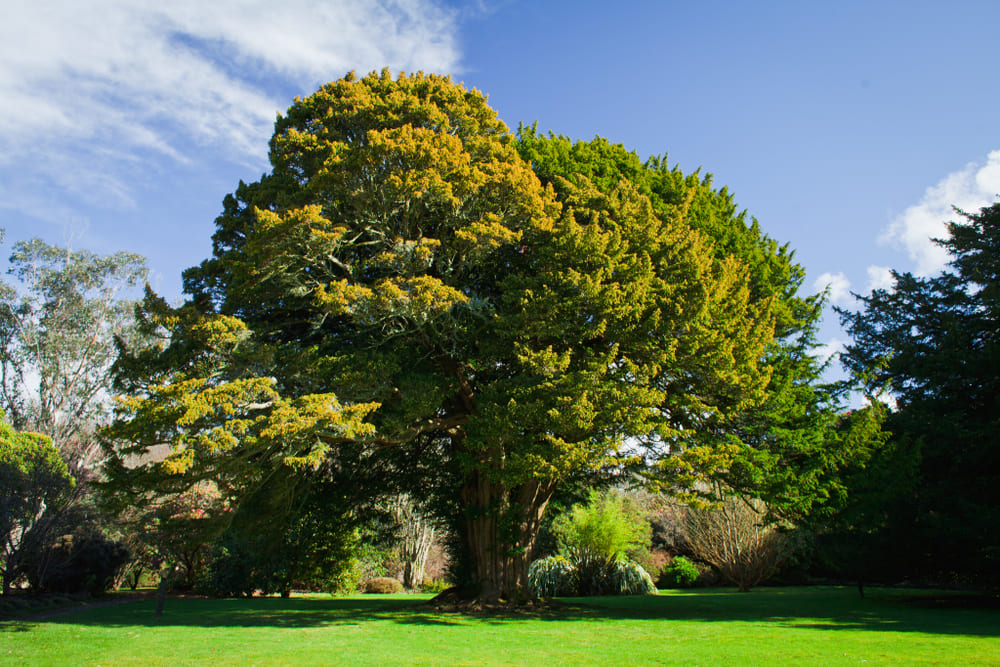
When you’re planning on adding a yew to your landscape, there are a few things you should know. They’re one of the oldest trees in Europe, and they have spiritual and cultural associations. They can be a wonderful addition to your garden, and they add a stable and deep green presence.
The yew is a large conifer, with thin, reddish bark and needle-like leaves. They grow well in partial or full shade, and they make a great hedge. They also produce strong wood.
Yews are often associated with the dead, and some people consider them a symbol of resurrection. They are also a source of woodfuel and are very long-lived. They can live up to nine thousand years.
The yew produces two types of fruits: seeds and berries. The seeds are found in a cone, and the berries are a bright red. The berries remain on the tree throughout winter.
The yew is poisonous, and a little bit can kill humans and animals. However, it has been used to help with cancer treatment.
97. Zelkova Tree

The Zelkova is a deciduous tree, which means it has leaves that change color in the fall. It’s a tough and sturdy relative of the elm, and it does well in a wide variety of soil and climate conditions. This makes it a great option for urban areas where it can tolerate heat and cold. However, it does need to be watered regularly to thrive.
Zelkova’s bark is smooth and grayish. When it ages, it peels away to reveal a bright orange interior. The leaves, too, turn an attractive shade of red or gold.
The Zelkova is known as a hardy elm substitute, and it is resistant to Dutch Elm Disease. It is often used for bonsai. Depending on the cultivar, it can grow to a height of 50 to 80 feet (15 to 24 meters).
In the spring, the Zelkova serrata flower produces small, green, ovoid drupes that look like cherries. These are borne on branches that are densely populated by smaller, green leaves.
In autumn, the foliage changes from green to gold and red. This tree makes an excellent choice for a tree that can be used for landscaping, or as a hedge. Its trunk is relatively thin and it is relatively fast growing.
98. Mango Tree

There are many types of mango trees. They come from different parts of the world, but all are sweet and delicious. They can be used to make many different kinds of dishes. Depending on the variety, the fruit can be either green or yellow in color.
The first type of mango tree is the Indian variety. This is a large, vigorous fruit tree. It grows in tropical and subtropical climates. It is hardy enough to survive the coldest of winters.
It produces a heavy crop of fruit in the summer. It is an excellent crop for salads and can be eaten raw or cooked.
The second type of mango is the Southeast Asian variety. This mango is great for salads. It has a very good resistance to Bacterial Black Spot. It also has a moderate resistance to Anthracnose.
It is not as big as the typical commercial mango but it has a unique appearance. It can grow to over two meters tall and bears fruits with a slightly citrus taste. It is often known as the jackfruit.
99. London Plane Tree
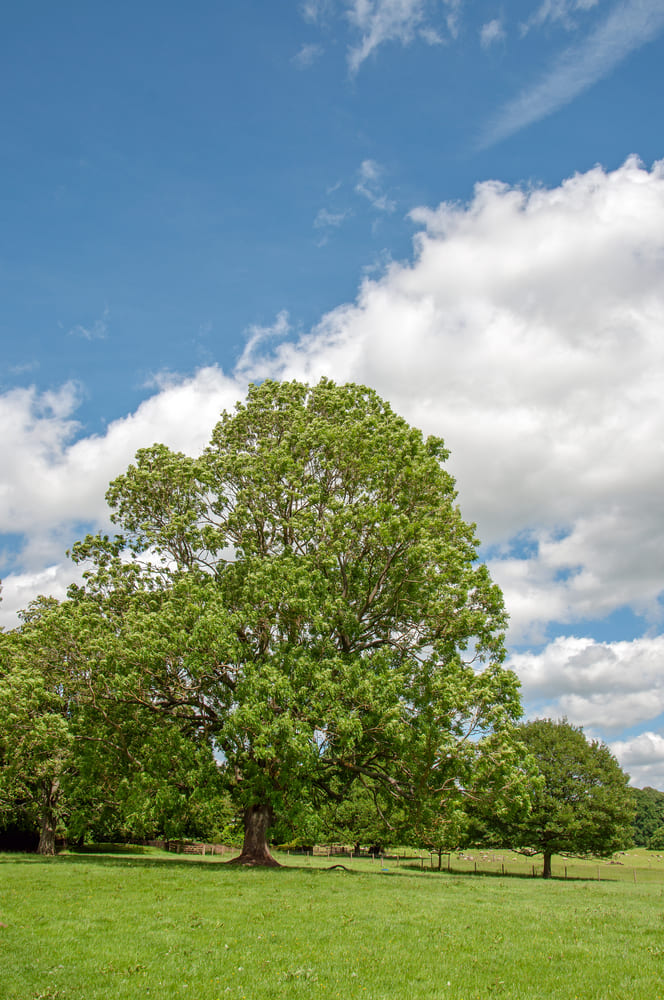
The London Plane Tree (Platanus x hybridus) is a hybrid tree that originated in England. It is a large deciduous tree that is suited for urban landscaping. The hybrid has three to five lobed leaves that are oblong or ovate, and are lobbed on both sides. The leaf blades are usually 6-7 inches wide.
The bark of the London Plane is unique in its camouflage pattern. It is created by exfoliating patches of the outer bark. The inner bark is creamy whitish-green. The bark has a flaky texture. It is often painted or painted with a different color. The London Plane is also able to resist diseases, as well as high levels of pollution.
The London Plane is commonly planted in urban areas, as it is tolerant to a variety of conditions. It is a fast-growing tree that can grow several feet per year. The wood from the London Plane is useful for veneer, as well as for flooring, plywood, and carvings.
The London Plane tree can live in moderate climates all over the world. It grows best in hardiness zones 5-9.
100. Royal Poinciana Tree

A member of the Fabaceae, the Royal Poinciana tree is one of the most striking woody plants in the world. A beautiful and versatile plant, it is also a popular addition to tropical gardens.
It has large, feathery leaves and bright red flowers. It is often used as a focal point in southern tropical landscapes. It is also a good tree for bringing cooling shade during the summer.
The royal poinciana tree is highly tolerant to drought, and it grows well in many soil types. It can survive in dry areas, but it does best in a moist, free-draining soil.
It is also a fairly low-maintenance plant once it’s established. It prefers a well-drained and sunny location. The tree is also a good choice for frost-free areas. It can be grown in pots, but remember to avoid letting the water sit on the leaves.
It is important to protect the tree’s roots from rot. It is also susceptible to termites and scale insects. To prevent these problems, it is recommended to regularly prune the branches.
101. Ironwood Tree
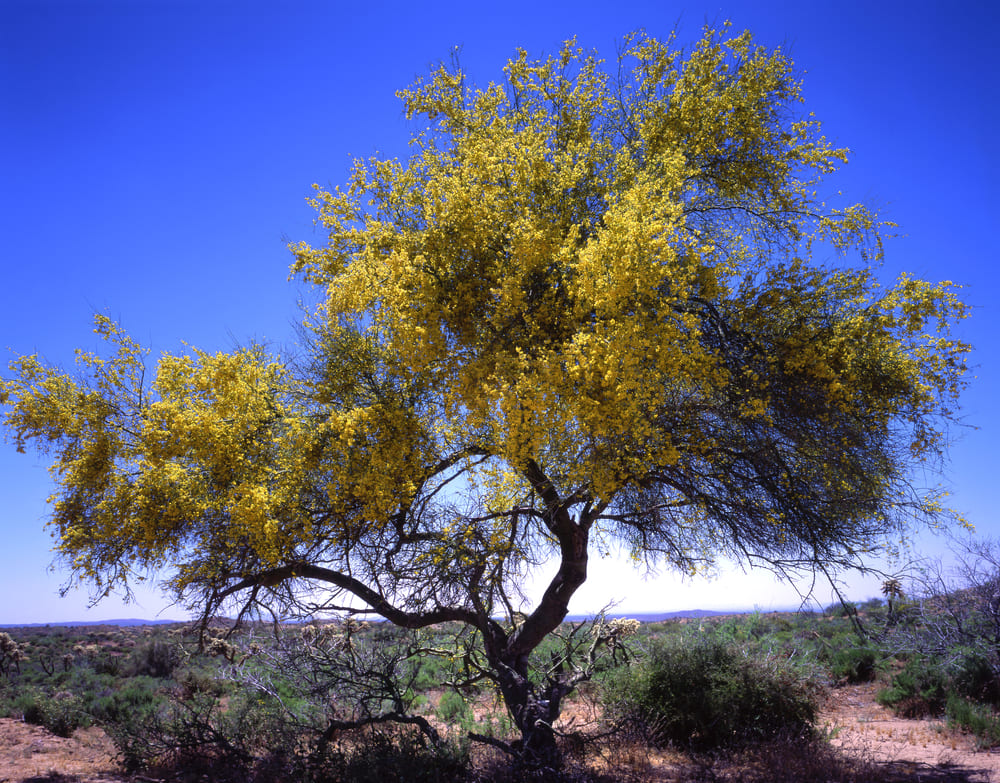
Ironwood (Ostrya virginiana) is a large tree that grows in the Sonoran Desert. It provides cover and forage for animals. This plant also attracts birds and butterflies.
It can grow to about 45 feet. The foliage is green to yellow. In autumn the leaves become dull. The bark is smooth on young trees and scaly on older ones.
This tree is one of the largest plants in the Sonoran Desert. It is a keystone species in many of the ecosystems in the region. It supports 500 other plant and animal species, including 60 reptiles.
It is a drought-tolerant plant. It is very low-maintenance. It can also be grown from seed. It can be harvested in the fall, planted directly in the ground in the spring, or dried for later use.
The Ironwood tree is considered to be an important part of the habitat of a wide variety of animals. In addition to providing food for insects and other small animals, the seeds are a popular food source for quails, doves, and coyotes.
102. Rowan Tree
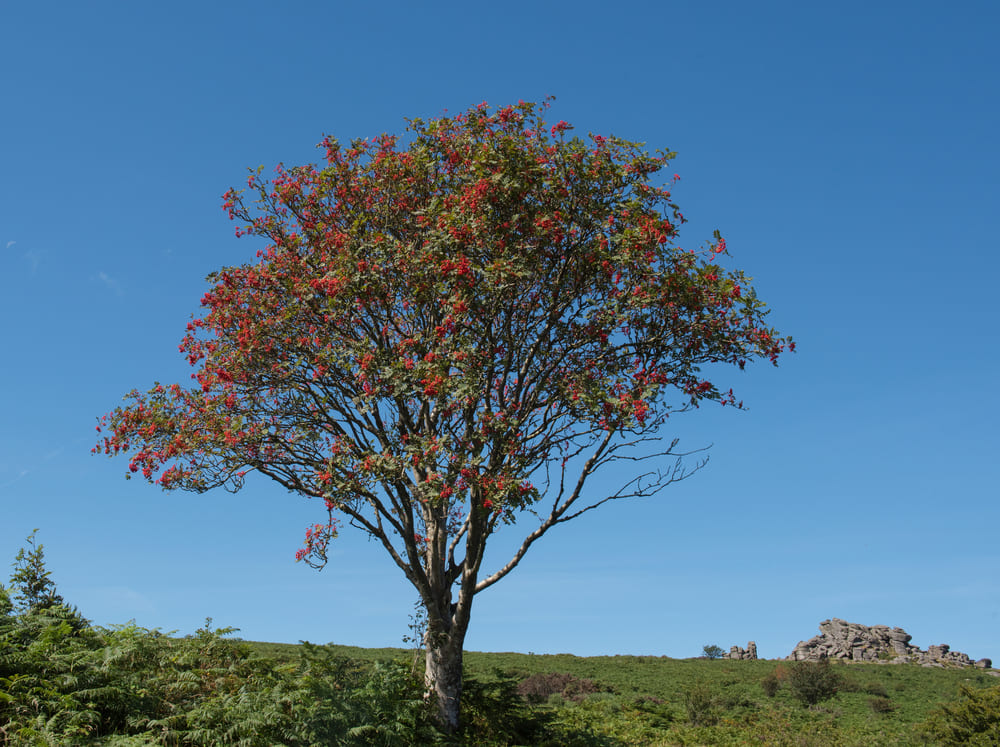
The Rowan Tree is a small native tree that grows in the mountains of the British Isles. This small deciduous shrub is also called the Mountain Ash, Wicken Tree, our Lady of the Mountains. It is a symbol of strength, protection, and divination.
Its five-pointed star shaped fruit is a symbol of magic and protection. The berry has been used to make jellies, liqueurs, jelly, and various alcoholic drinks. The berries contain high levels of vitamin C.
In the UK, the Rowan is commonly found in the north and west of the country. It is also found at higher altitudes than most other native trees. It can survive in inhospitable environments.
Throughout history, Rowan has been associated with protection. Its bark is also known to help in curing stomach upsets and whooping cough. It is believed that a twig of Rowan may contain a thread of red that can turn aside the most powerful spells.
The rowan tree produces beautiful white flowers in spring, followed by vivid red berries in autumn. These berries have been used for various recipes, including as a scurvy remedy and as an autumn food for many birds.
103. Box Elder Tree
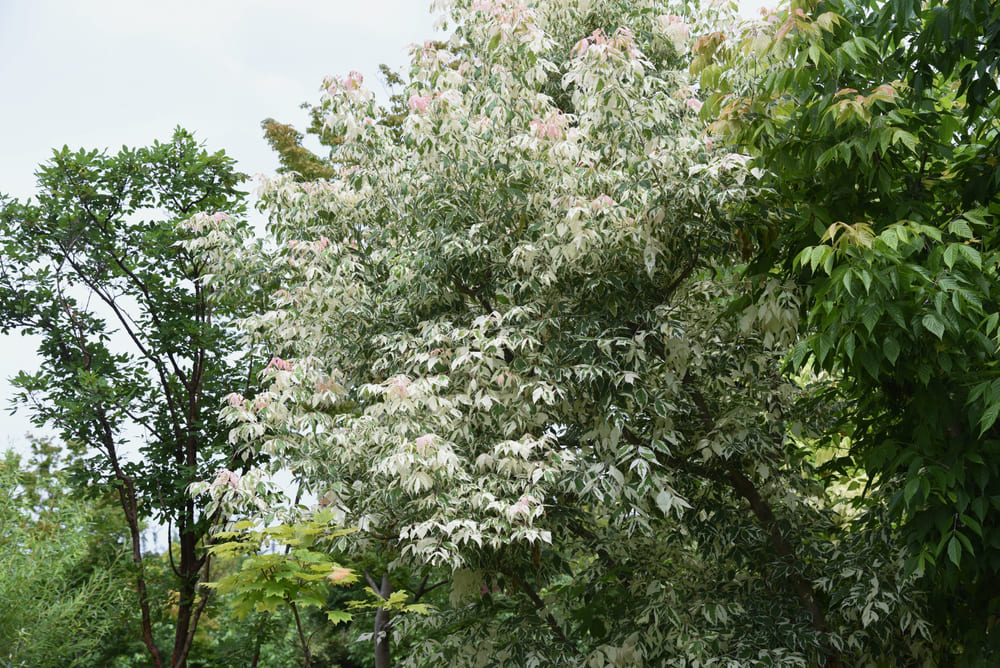
The box elder tree is also known as the ash leaf maple or Manitoba maple. It is a fast-growing deciduous tree. It can grow up to eighty feet in height.
The box elder tree grows in areas with wet soil. It is considered invasive in many parts of the United States.
The tree is a popular plant for landscaping. It attracts birds and butterflies. Its branches are often multi-trunked. The tree is also a favorite of bonsai enthusiasts.
The tree is very hardy and drought resistant. It can survive for more than 75 years. It requires moist soil and full sun.
The box elder produces small, petalless flowers. These bloom in early spring. The female flowers have lime-green pistils and stamens. The pollen is released in winter. The male boxelder trees produce light brown stamens.
The box elder tree is very popular among people. It can be found in almost every state in the contiguous U.S. The leaves of the tree are oval, serrated and have lobes. The leaflets are 2-4 inches long.
104. Floss Silk Tree
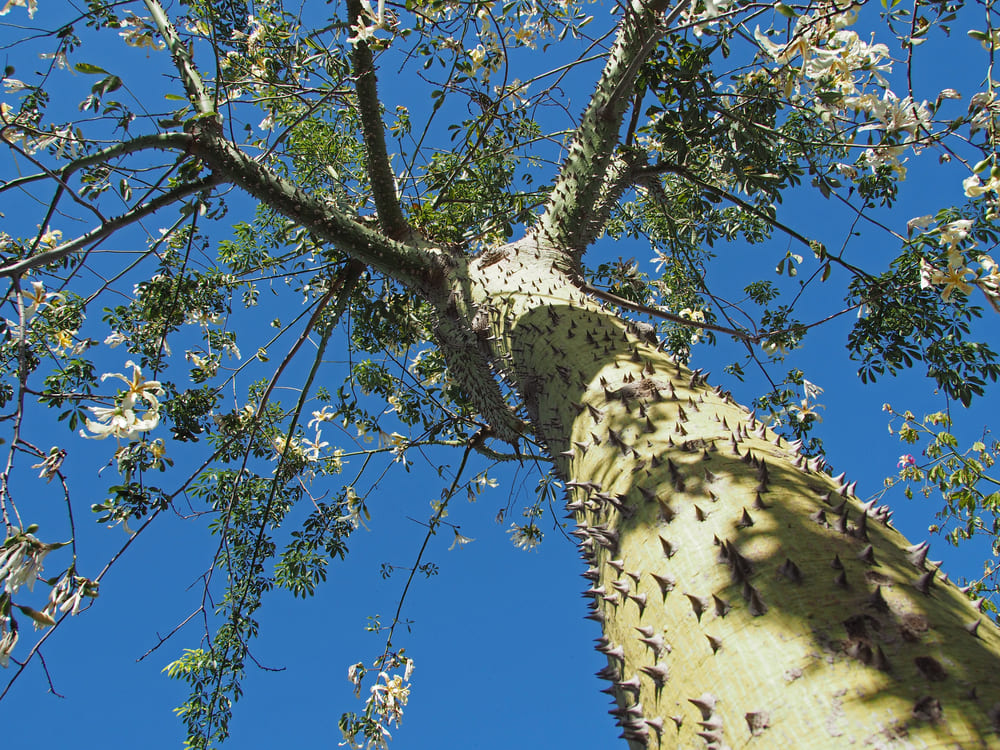
The Floss Silk Tree, or Ceiba speciosa, is a deciduous tree native to South America. It has been cultivated as an ornamental tree in areas with appropriate climates.
It has large, palmate leaves, which can be up to five inches long. The flowers are five petals with a creamy center. They are produced in clusters during the autumn.
The Silk Floss Tree has been cultivated as a landscape tree in subtropical areas. The bark is water-resistant and was used for canoes by the indigenous South American tribes.
During the fall, the tree produces pink funnel-shaped flowers. These blooms are about six inches wide. The Silk Floss Tree can grow as tall as 25 meters. It is a great specimen tree for large landscapes.
When planted in a sunny location, the Floss Silk Tree has a moderate growth rate. Young trees can grow up to three feet a year, while older plants can survive temps as low as 27 degrees Fahrenheit.
The Silk Floss Tree can also be used as a bonsai or container plant. It has a thick trunk with a bottle shape. The bark is green and absorbs sunlight.
105. Sandbox Tree

The sandbox tree is a member of the spurge family. It is native to tropical parts of South America and Africa. It can grow up to 100 feet in height. The fruit is shaped like miniature pumpkins. The best part is, it can be used as a potted plant.
While the sandbox tree is not the most elegant plant in the world, it does have some nice traits. It is known to disperse its seeds efficiently. The tree can also be a bit dangerous. The seeds are quite explosive. They travel at up to 150 miles per hour. This means that you should be careful when gardening with the sandbox tree.
In addition, it is also known for its spiky bark. The trunk is studded with short, conical prickles. Similarly, the leaves are hairy and long. They are also quite round. They are covered with a layer of oil. In fact, they have been used in baths and other healing applications.
The sandbox tree is considered one of the most dangerous plants in the world. In the past, the small gourd-shaped fruit of the sandbox was used to store sand. But it was also used by natives of the Caribbean for poison. Its sap is quite toxic, causing red rashes on the skin and even temporary blindness.
106. Devil’s Walking Stick Tree
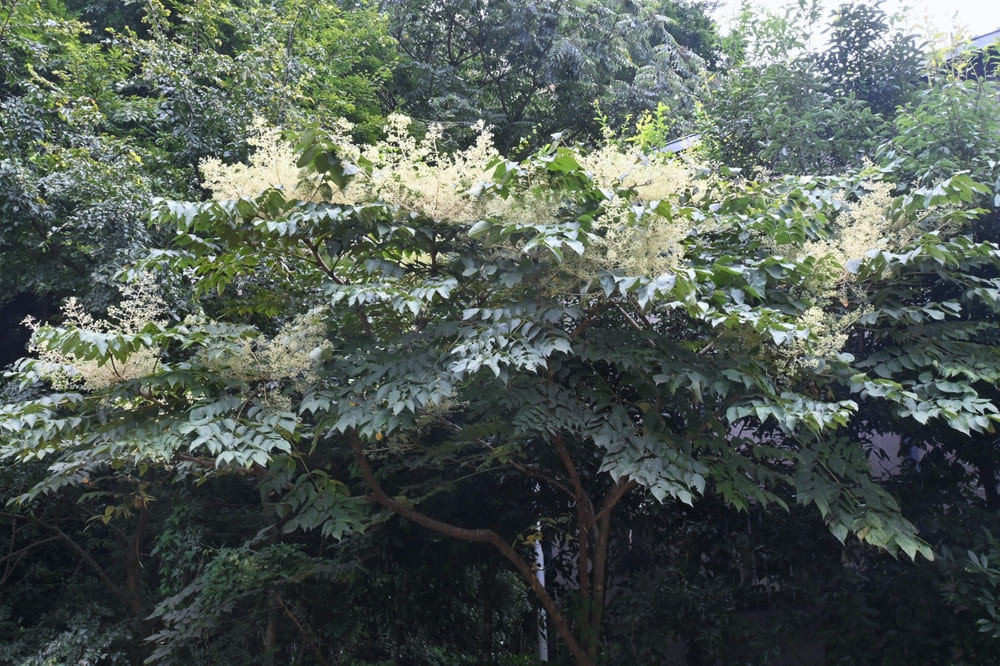
The Devil’s Walking Stick tree is a native species of plant that is native to southern Illinois and the eastern United States. This small deciduous tree is often found along the edges of woodlands and rivers. It is an adaptable plant and is easily grown in a variety of soil conditions.
This plant is a member of the Araliaceae family. The leaves of this tree are arranged in pairs. Each pair is divided into three or four leaflets. These leaves are covered in sharp prickles. The leaves are bronze-yellow in the summer and turn to a deep red with yellow in the fall.
This plant is very popular with birds. The fruits are black, fleshy and are eaten by birds. It also attracts butterflies such as the tiger swallowtail. The flowers are white and are held in clusters. They bloom for 10 days.
The Devil’s Walking Stick tree grows well in both wet and dry environments. It can thrive in full sun to part shade. It is tolerant of both clay and sandy soil.
107. Kapok Tree
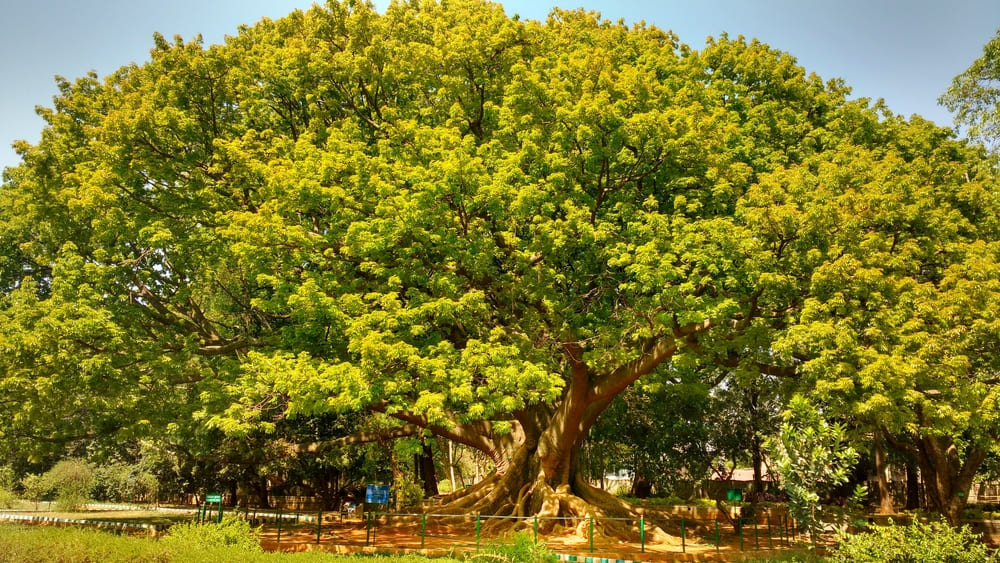
The Kapok tree is also known as the silk cotton tree. It is one of the largest flowering trees in the world. It grows in tropical rainforests. It is found in the southern part of the Amazon and in southern Mexico.
The kapok is a fast growing tree. It produces a large number of seeds. These seeds are round like peas. They are covered with wooly fibers and are edible. The seed pods are smooth and light green. They measure about ten to thirty centimeters. The fruit is surrounded by gray wooly hairs.
The kapok tree is grown in primary and secondary forests. It can grow to a height of 80 feet. The leaves of the kapok are palmately compound, with five to eight lance-shaped leaflets.
108. Chittamwood Tree
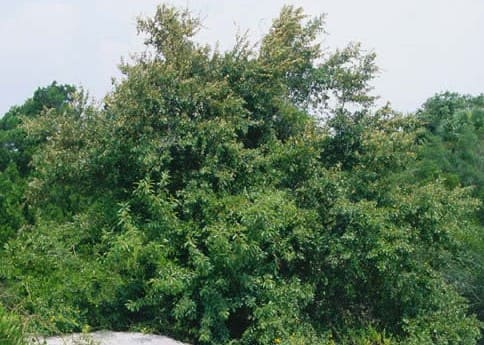
Chittamwood is a medium sized shrub or tree. It is related to the sapodilla tree and is native to the southern United States and Mexico. The fruit is black and is edible. It is also used in a variety of craft projects.
It has small, white flowers that are attractive to butterflies. The berries ripen in the fall and are a source of food for wildlife. It can also be used as a security hedge.
It grows to a height of 30 to 50 feet. It has a round crown and sharp spines on its branches. Its bark is gray to brown. It is a very drought tolerant plant. It can be grown in an average well-drained soil.
Chittamwood is an excellent shrub to use as a background in a shrub border or as a taller accent in a landscape. It is a medium sized, deciduous shrub or tree. It can grow in full sun or part shade.
109. Osage Orange Tree
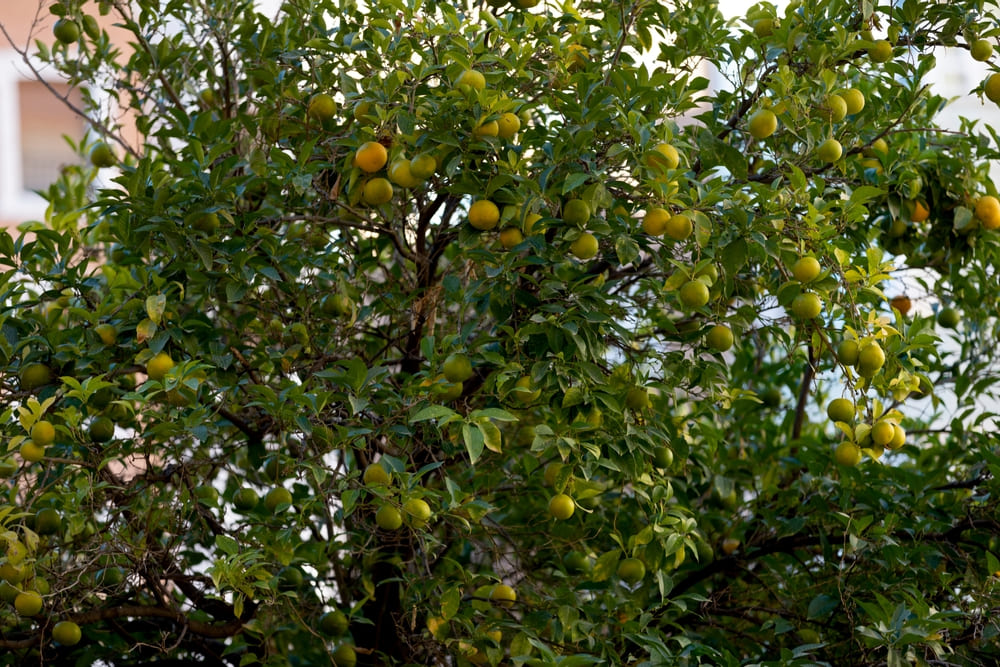
If you have an Osage Orange tree, you’ll want to keep it healthy and thriving. In this guide, we’ll show you how to care for your tree.
When you’re planting an Osage orange tree, you’ll need to choose a location where it will grow in well-drained, but moist soil. If your soil is very dry, you may need to water it more often. Osage oranges are adapted to a variety of climates. They can thrive in dry, sandy, or alkaline soils.
Osage Oranges do not rot easily. They can be used for building, as a fence, or as a hedge. The wood of an Osage Orange is strong, rot-resistant, and dense. It can be used to make archery bows.
Osage Oranges are native to Oklahoma and Arkansas. They were commonly planted by the Osage Indian tribe, and were also used as a natural barrier.
110. Podocarpus Tree
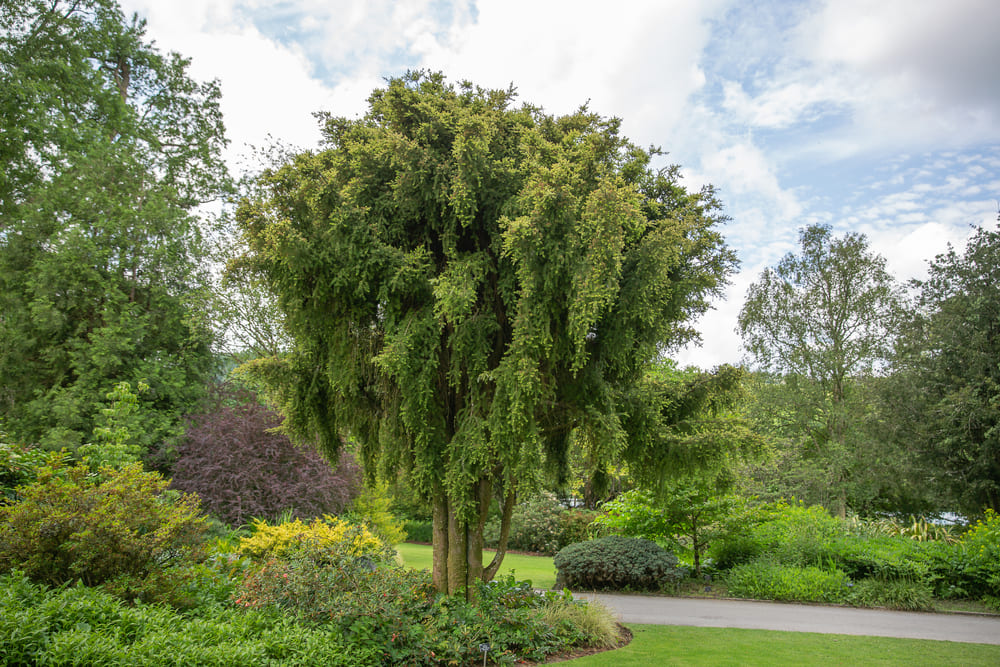
If you are looking for a classy, evergreen plant that will make a good hedge, look no further than the Podocarpus Tree. This shrub or tree is easy to grow and is relatively low maintenance. It is a favorite with gardeners, because of its versatility. It can be grown as a hedge, topiary, or natural screen. It can also be grown in containers, so if you live in a cold climate, you can enjoy its beauty indoors.
It grows well in full sun, but it’s also tolerant of partial shade. If you’re looking to plant it in a shaded area, you’ll want to choose a location that has 6 hours of sunlight or less. This will help ensure that the leaves don’t get scorched.
111. Manzanita Tree
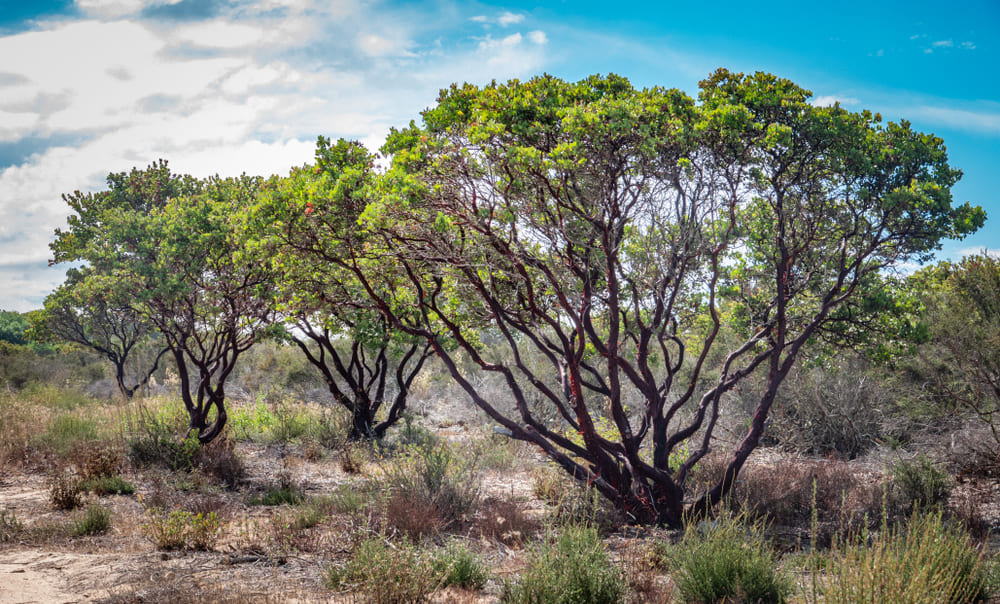
If you are planning to create a beautiful landscape in your yard, you may want to add a manzanita tree. There are many varieties of manzanitas available, from small ornamental shrubs to small tree specimens.
The flower of manzanitas has a distinctive shape, reminiscent of little vases tipped upside down. The leaves are thick and round. They are about a quarter-inch in diameter. The tree is evergreen.
A large number of species and subspecies exist in California, from the southern Sierras to the northern Baja. There are also naturally occurring hybrids. These varieties have proven their value in the garden.
Manzanitas are a good choice for the garden because they thrive in dry climates. However, they require good air circulation.
For best results, use a potting mix of equal parts sand and peat. It is best to avoid overhead irrigation. Water should be directed to the root zone.
